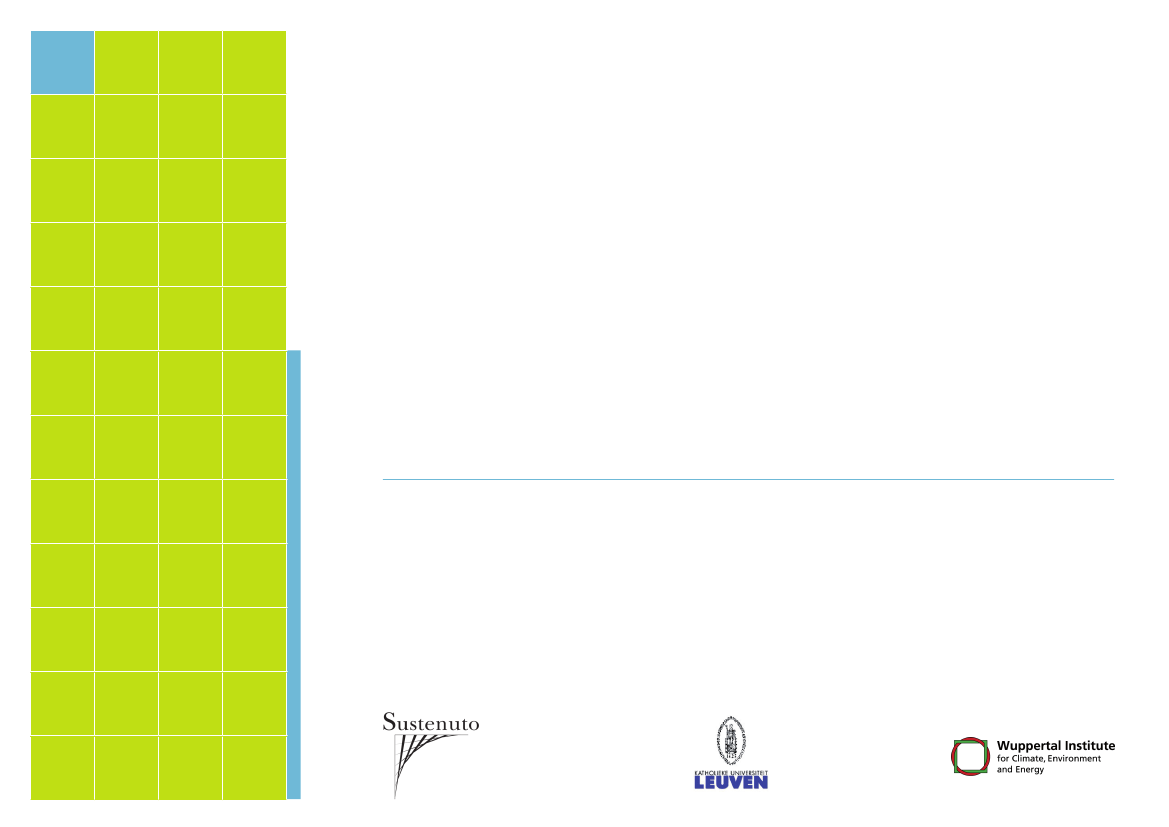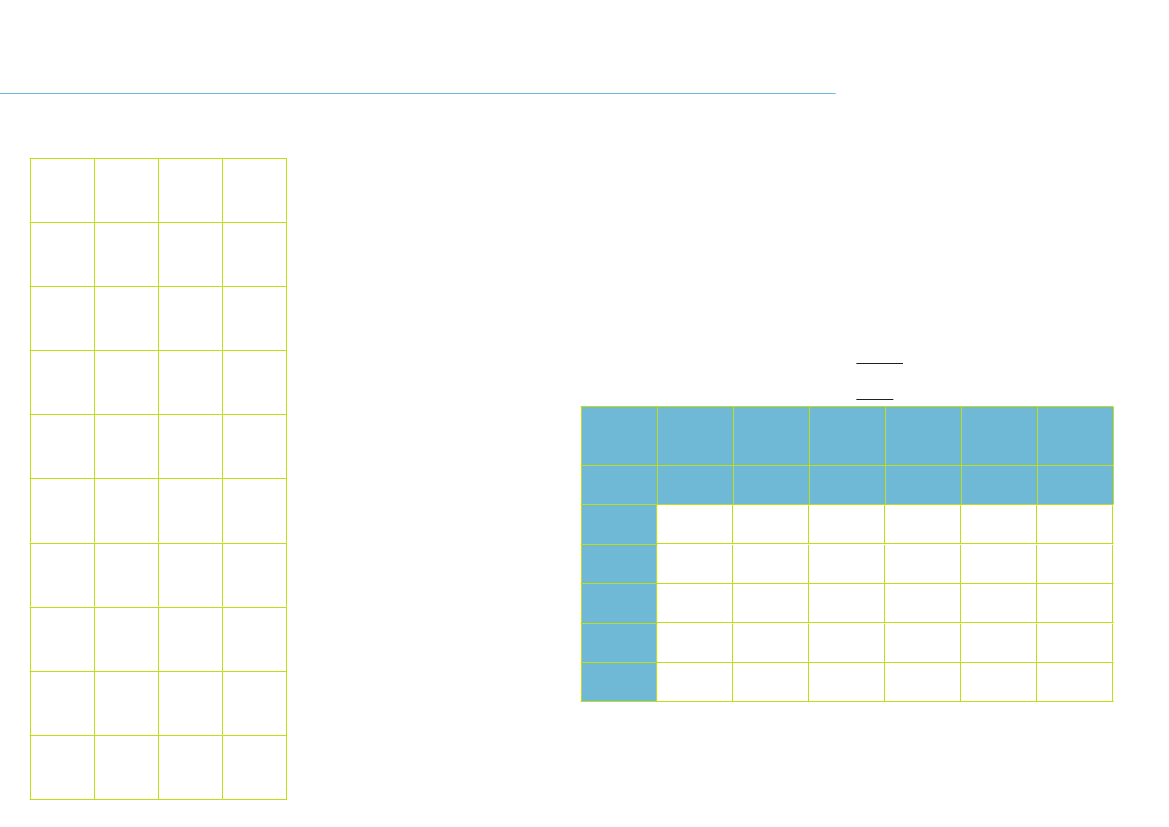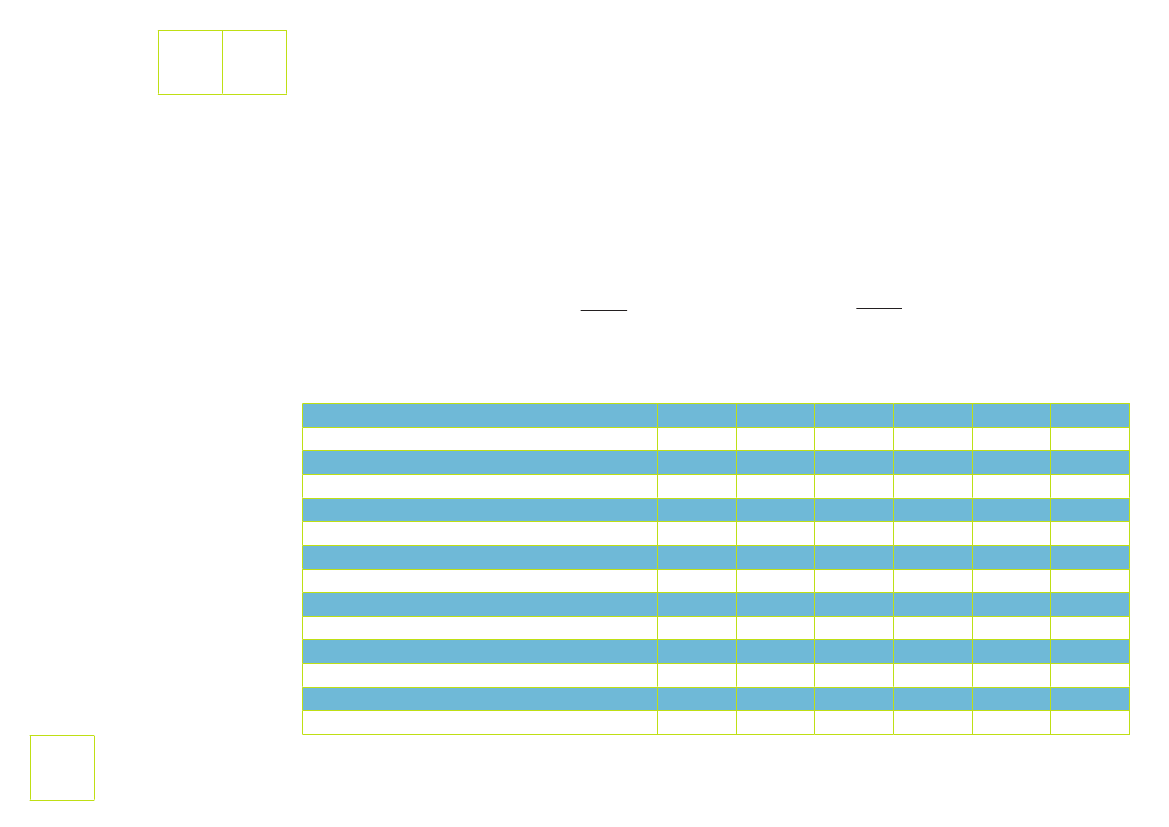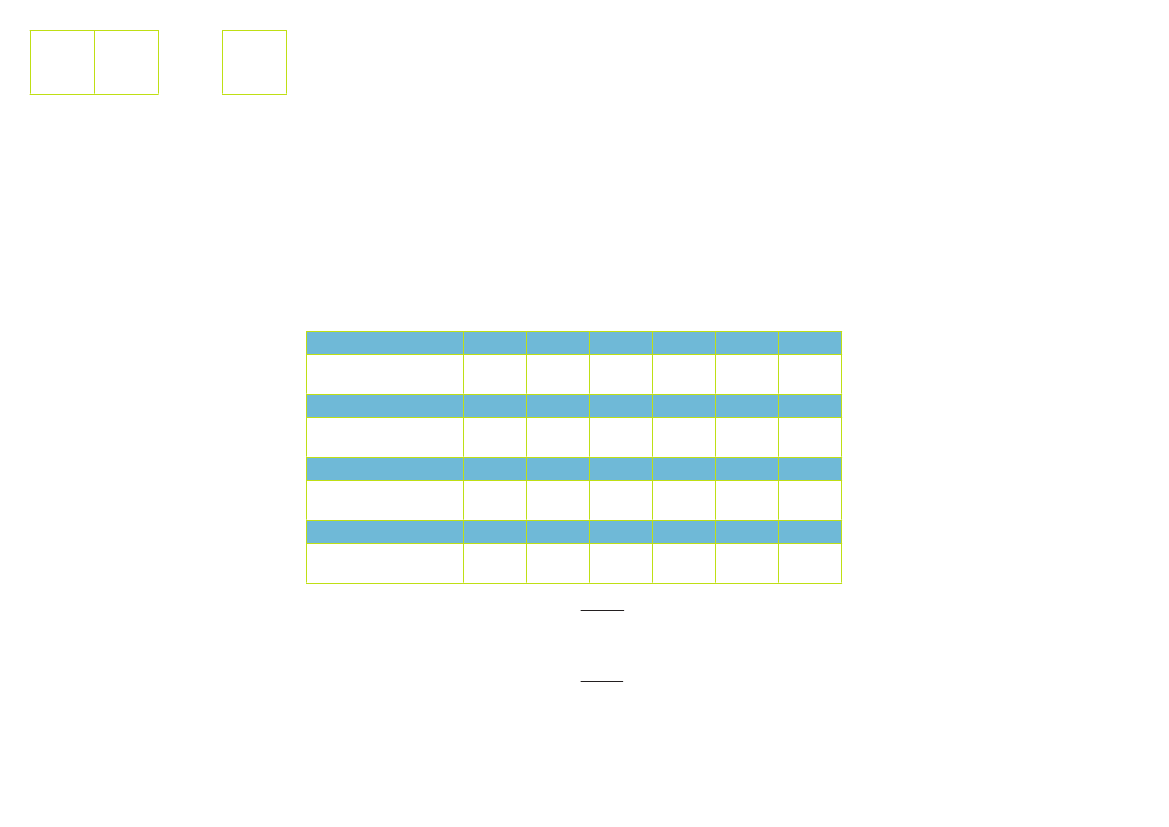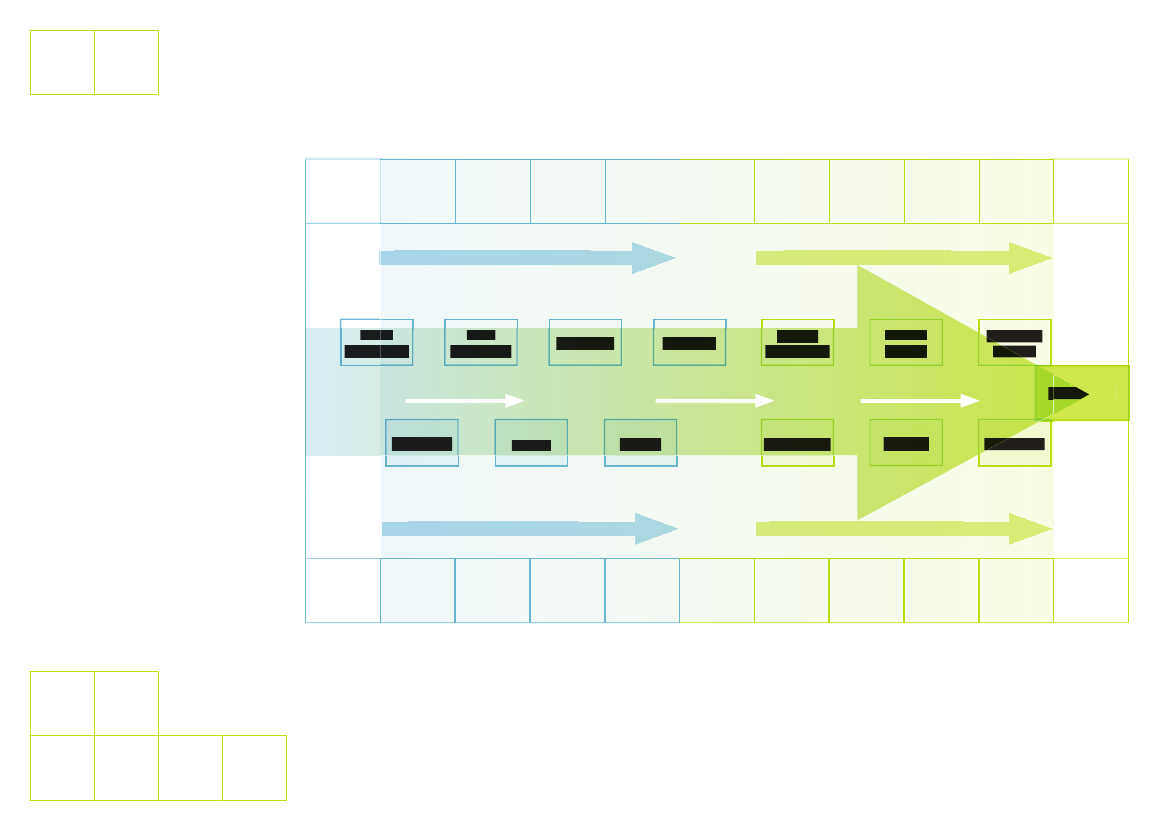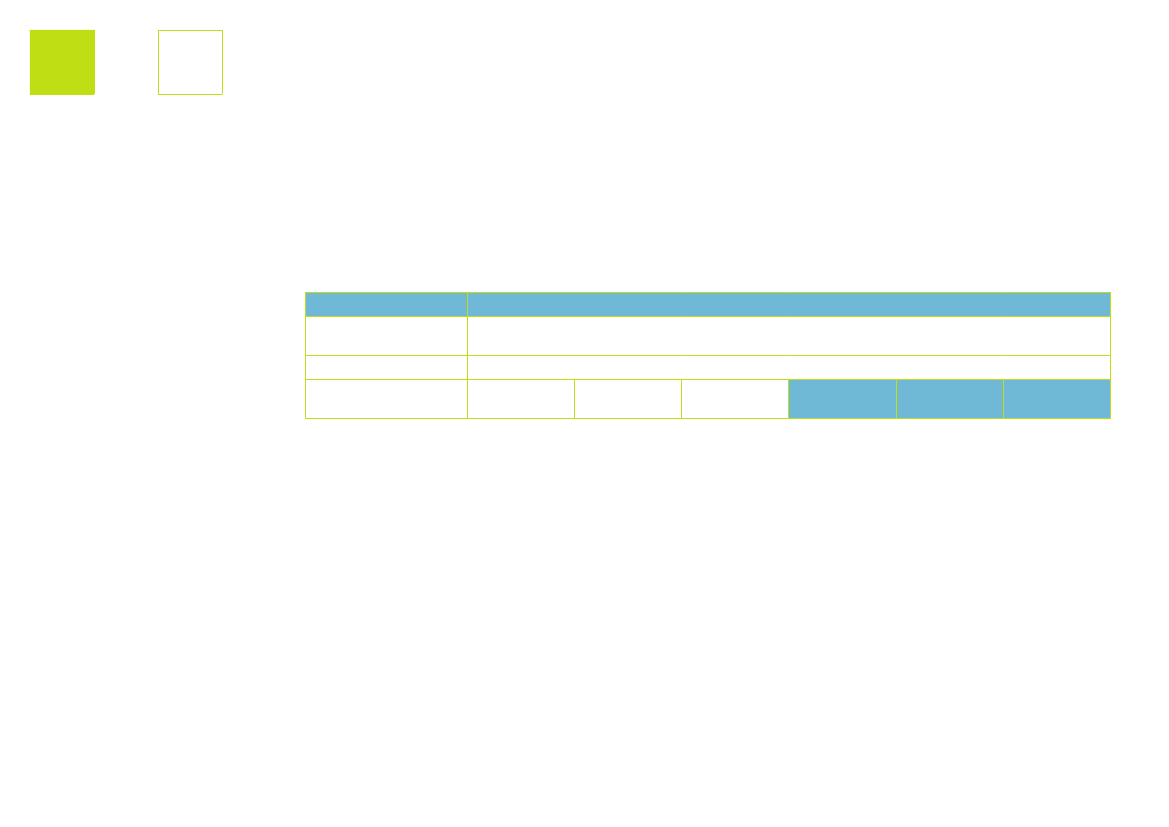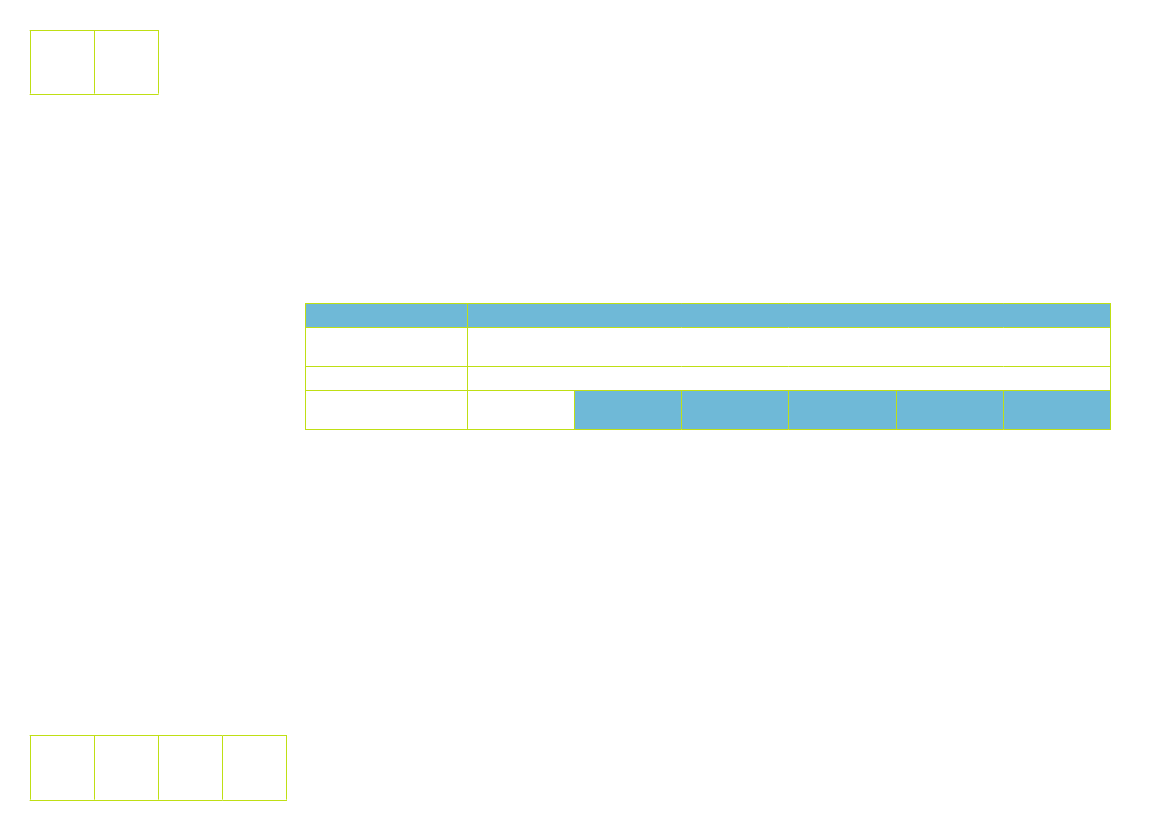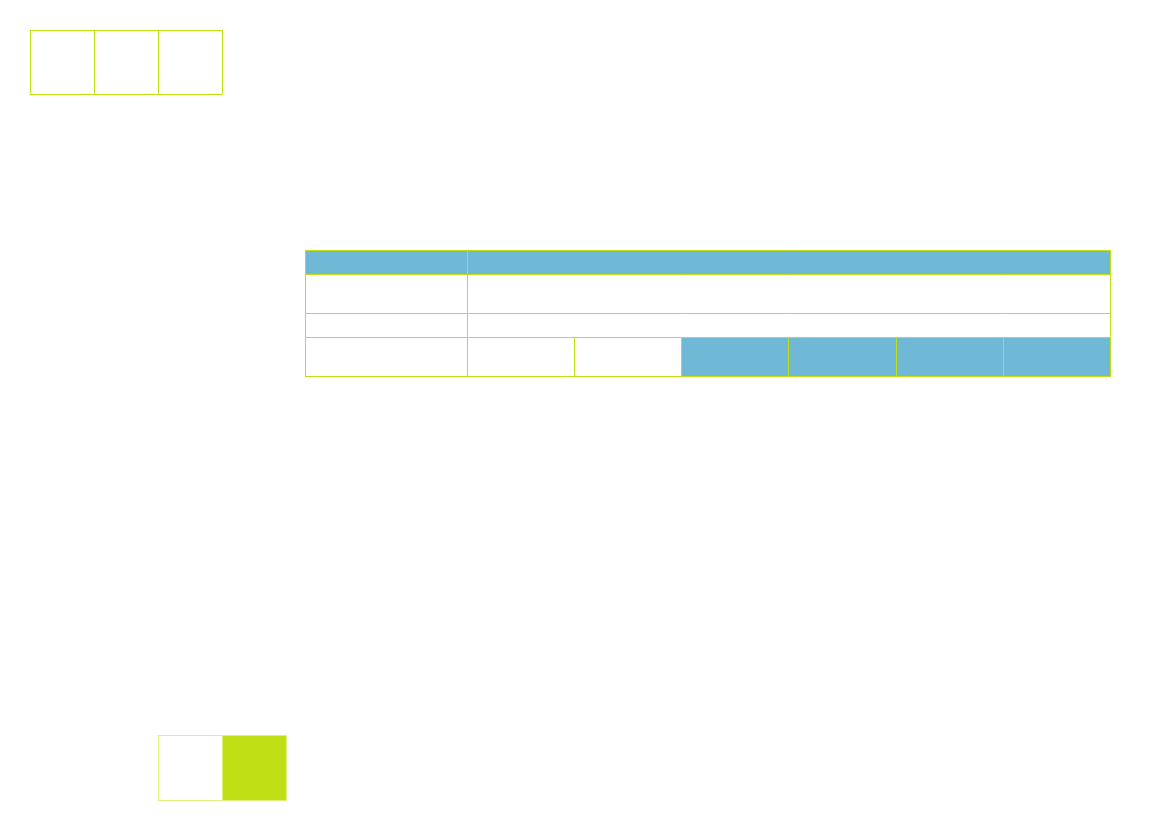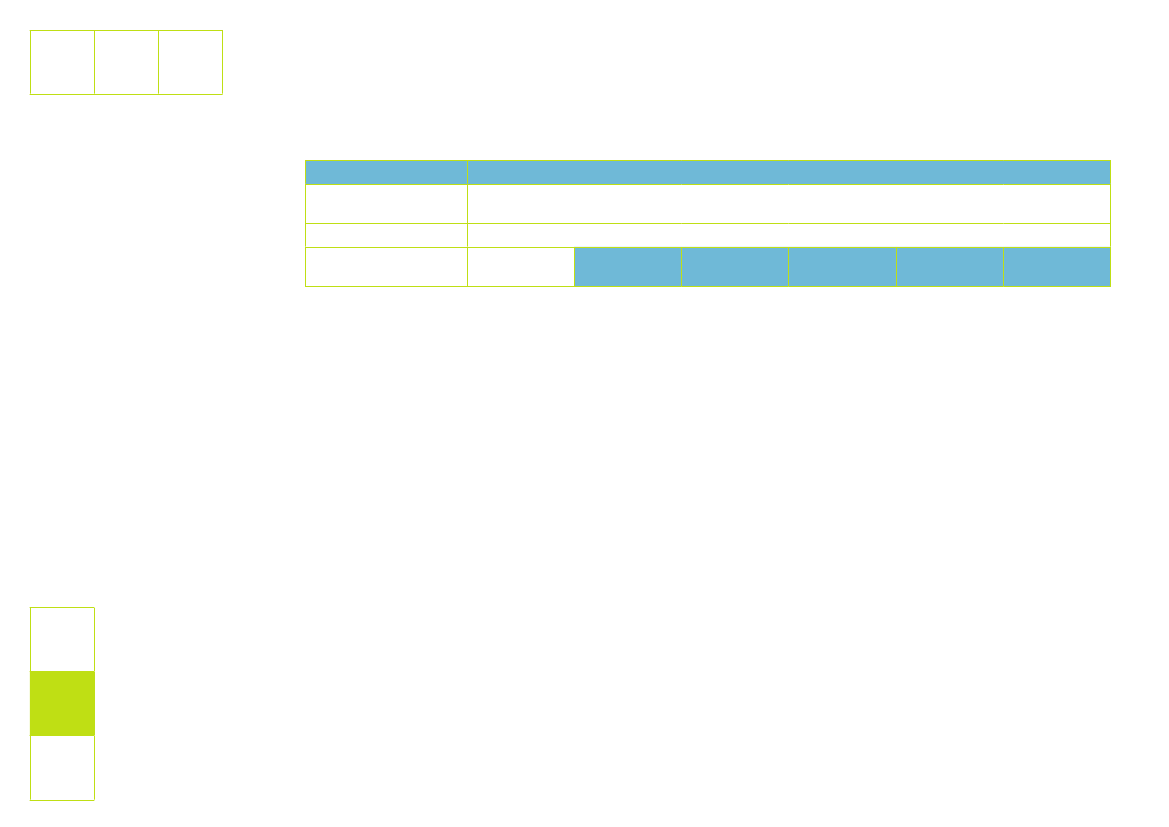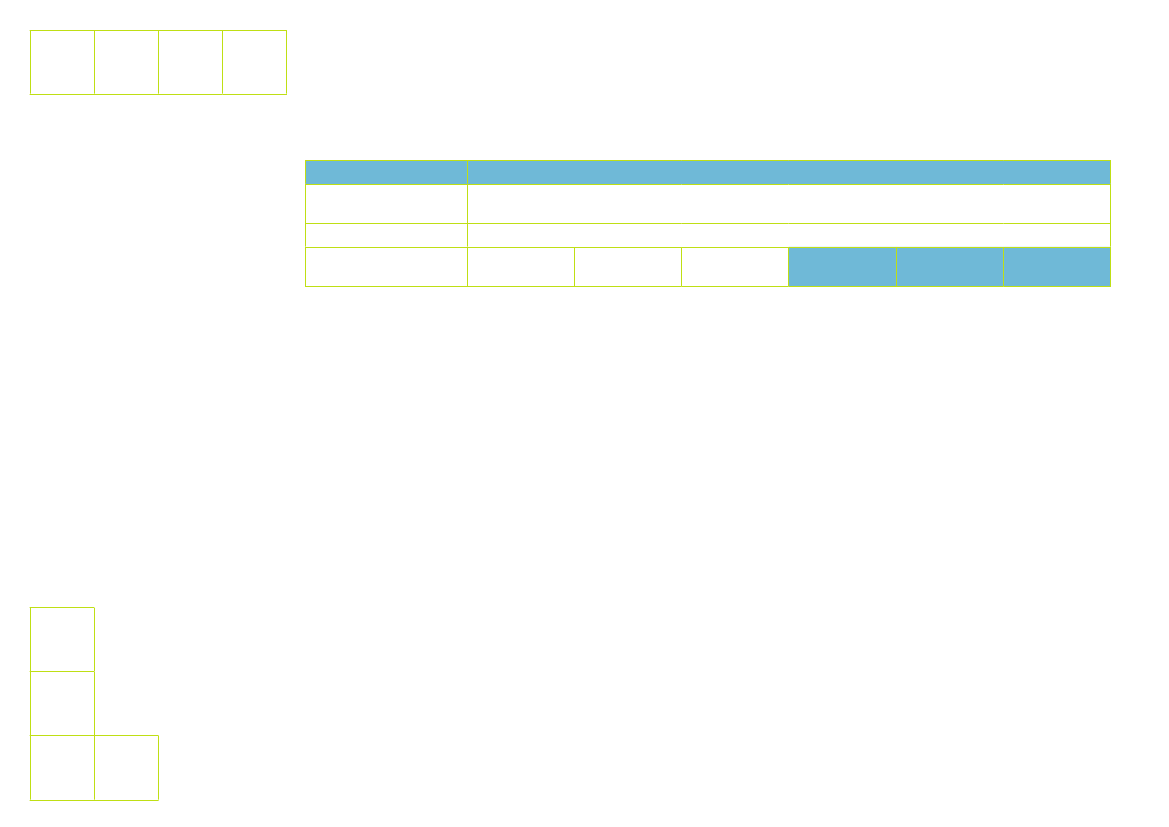Miljø- og Planlægningsudvalget 2008-09
MPU Alm.del Bilag 676
Offentligt
Sustainable Materials Management for Europe,from efficiency to effectiveness.
This background study on Sustainable Materials Management has been commissioned by the Flemish government, by the Department of Environ-ment, Nature and Energy (LNE) and the Public Waste Agency of Flanders (OVAM).This report serves as basis for the background paper for the informal Environmental Council on the 12th and 13th of July 2010, as part of the BelgianPresidency of the EU during the second semester of 2010.The study is executed by a partnership of three expert organisations:•Sustenuto:independent Belgian strategic consultancy & research firm on Sustainable Development, CSR, cross-sector partnerships and Cradleto Cradle.Author and lay-out: Ans Rossy. Contact: [email protected]•Catholic University of Leuven (KULeuven),Department of Metallurgy and Materials Engineering, Leuven Research & Development including itsMaterial Research Centre (MRC).Authors: Dr. Peter Tom Jones and Dr. Daneel Geysen. Contact: [email protected]Wuppertal Institute for Climate, Environment and Energy:application-oriented sustainability research, addressing the major challengesrelated to sustainable development, such as climate change or resource shortages.Author: Katrin Bienge. Contact: [email protected]
•
Manuscript completed: Brussels, 31 March 2010
SMM for Europe, from efficiency to effectiveness|pag 2
Table of ContentExecutive summary. . . . . . . . . . . . . . . . . . . . . . . . . . . . . . . . . . . . . . . . . . . . . . . . . . . . . . . . . . . . . . . . . . . . . . . . . . . . . . . . . . . . . . . . . . . . . . . . . . . . . .4Objective. . . . . . . . . . . . . . . . . . . . . . . . . . . . . . . . . . . . . . . . . . . . . . . . . . . . . . . . . . . . . . . . . . . . . . . . . . . . . . . . . . . . . . . . . . . . . . . . . . . . . . . . . . . . . . . . . . . . . . . .41. What is SMM?. . . . . . . . . . . . . . . . . . . . . . . . . . . . . . . . . . . . . . . . . . . . . . . . . . . . . . . . . . . . . . . . . . . . . . . . . . . . . . . . . . . . . . . . . . . . . . . . . . . . . . . . . . . .42. Why is SMM relevant?. . . . . . . . . . . . . . . . . . . . . . . . . . . . . . . . . . . . . . . . . . . . . . . . . . . . . . . . . . . . . . . . . . . . . . . . . . . . . . . . . . . . . . . . . . . . . . . . . .43. Case examples of SMM. . . . . . . . . . . . . . . . . . . . . . . . . . . . . . . . . . . . . . . . . . . . . . . . . . . . . . . . . . . . . . . . . . . . . . . . . . . . . . . . . . . . . . . . . . . . . . . .54. Future policy directions for SMM. . . . . . . . . . . . . . . . . . . . . . . . . . . . . . . . . . . . . . . . . . . . . . . . . . . . . . . . . . . . . . . . . . . . . . . . . . . . . . . . . . . .5Chapter 1 - What is Sustainable Materials Management?. . . . . . . . . . . . . . . . . . . . . . . . . . . . . . . . . . . . . . . . . . . . .71.1 Clarifying terminology; do we talk about the same?. . . . . . . . . . . . . . . . . . . . . . . . . . . . . . . . . . . . . . . . . . . . . . . . . . . . . . . . .71.2 Main evolutions in material use. . . . . . . . . . . . . . . . . . . . . . . . . . . . . . . . . . . . . . . . . . . . . . . . . . . . . . . . . . . . . . . . . . . . . . . . . . . . . . . . . . . . .91.2.1 Reaction: from end-of-pipe to eco-efficiency and supply chain. . . . . . . . . . . . . . . . . . . . . . . . . . . . . . . . . .91.2.2 Re-designing: eco-effectiveness and closing the loop. . . . . . . . . . . . . . . . . . . . . . . . . . . . . . . . . . . . . . . . . . . .101.2.3 Re-framing: towards new horizons of integrated approaches. . . . . . . . . . . . . . . . . . . . . . . . . . . . . . . . . .111.2.4 Future Challenges. . . . . . . . . . . . . . . . . . . . . . . . . . . . . . . . . . . . . . . . . . . . . . . . . . . . . . . . . . . . . . . . . . . . . . . . . . . . . . . . . . . . . . . . . . . .11Chapter 2 - Why is SMM relevant? The bigger picture. . . . . . . . . . . . . . . . . . . . . . . . . . . . . . . . . . . . . . . . . . . . . . . . .132.1 What has changed in a life time?. . . . . . . . . . . . . . . . . . . . . . . . . . . . . . . . . . . . . . . . . . . . . . . . . . . . . . . . . . . . . . . . . . . . . . . . . . . . . . . .132.1.1 The overall challenge: climate change and human development. . . . . . . . . . . . . . . . . . . . . . . . . . . . . .142.1.2 Food. . . . . . . . . . . . . . . . . . . . . . . . . . . . . . . . . . . . . . . . . . . . . . . . . . . . . . . . . . . . . . . . . . . . . . . . . . . . . . . . . . . . . . . . . . . . . . . . . . . . . . . . . . . . . .162.1.3 Living - housing. . . . . . . . . . . . . . . . . . . . . . . . . . . . . . . . . . . . . . . . . . . . . . . . . . . . . . . . . . . . . . . . . . . . . . . . . . . . . . . . . . . . . . . . . . . . . . .182.1.4 Mobility. . . . . . . . . . . . . . . . . . . . . . . . . . . . . . . . . . . . . . . . . . . . . . . . . . . . . . . . . . . . . . . . . . . . . . . . . . . . . . . . . . . . . . . . . . . . . . . . . . . . . . . . . . .212.2 Why is SMM relevant?. . . . . . . . . . . . . . . . . . . . . . . . . . . . . . . . . . . . . . . . . . . . . . . . . . . . . . . . . . . . . . . . . . . . . . . . . . . . . . . . . . . . . . . . . . . . . .232.3 What are the future challenges for SMM?. . . . . . . . . . . . . . . . . . . . . . . . . . . . . . . . . . . . . . . . . . . . . . . . . . . . . . . . . . . . . . . . . . .23References. . . . . . . . . . . . . . . . . . . . . . . . . . . . . . . . . . . . . . . . . . . . . . . . . . . . . . . . . . . . . . . . . . . . . . . . . . . . . . . . . . . . . . . . . . . . . . . . . . . . . . . . . . . . . . . . .69Chapter 4 Future policy directions. . . . . . . . . . . . . . . . . . . . . . . . . . . . . . . . . . . . . . . . . . . . . . . . . . . . . . . . . . . . . . . . . . . . . . . . . . . . . .624.1 Policy Integration. . . . . . . . . . . . . . . . . . . . . . . . . . . . . . . . . . . . . . . . . . . . . . . . . . . . . . . . . . . . . . . . . . . . . . . . . . . . . . . . . . . . . . . . . . . . . . . . . . . . .634.2 Measuring and indicators. . . . . . . . . . . . . . . . . . . . . . . . . . . . . . . . . . . . . . . . . . . . . . . . . . . . . . . . . . . . . . . . . . . . . . . . . . . . . . . . . . . . . . . . . .644.3 Research & Development. . . . . . . . . . . . . . . . . . . . . . . . . . . . . . . . . . . . . . . . . . . . . . . . . . . . . . . . . . . . . . . . . . . . . . . . . . . . . . . . . . . . . . . . . .674.4 World 2.0. . . . . . . . . . . . . . . . . . . . . . . . . . . . . . . . . . . . . . . . . . . . . . . . . . . . . . . . . . . . . . . . . . . . . . . . . . . . . . . . . . . . . . . . . . . . . . . . . . . . . . . . . . . . . . . .67Chapter 3 – SMM examples: cases and country policies. . . . . . . . . . . . . . . . . . . . . . . . . . . . . . . . . . . . . . . . . . . . . .253.1 SMM cases. . . . . . . . . . . . . . . . . . . . . . . . . . . . . . . . . . . . . . . . . . . . . . . . . . . . . . . . . . . . . . . . . . . . . . . . . . . . . . . . . . . . . . . . . . . . . . . . . . . . . . . . . . . . .273.1.1 Policy directions based on SMM cases. . . . . . . . . . . . . . . . . . . . . . . . . . . . . . . . . . . . . . . . . . . . . . . . . . . . . . . . . . . . . . .513.2 Country policies on SMM. . . . . . . . . . . . . . . . . . . . . . . . . . . . . . . . . . . . . . . . . . . . . . . . . . . . . . . . . . . . . . . . . . . . . . . . . . . . . . . . . . . . . . . . . .52
SMM for Europe, from efficiency to effectiveness|pag 3
ExEcutivE summaryObjectiveThe objective of this report is to provide a clearand easily understandable background studyon what sustainable materials management(hereafter SMM) is about, what the main evolu-tions are, and why SMM is relevant. The reportprovides examples of a great variety of casesand illustrates the challenges for further policydevelopment on SMM at EU level.The study serves as a basis for debate for theinformal Environmental Council on July 12 and13, as part of the Belgian EU Presidency duringthe second semester of 2010. It is not intendedto give an exhaustive outline of the whole spec-trum of SMM and related concepts, nor of thedifferent existing policies at all political levels.Production (SCP), and Sustainable MaterialsManagement (SMM). The study uses the OECDdefinition on SMM as a basis as it provides thebroadest vision of these four concepts. ThisSMM definition must be seen from its mostintegrated point of view, also encompassing theissues of land use, absolute decoupling of eco-nomic growth and natural resource use, whileaddressing changes in human lifestyles.The concept of material use has evolved overthe past decades, due to increased knowledgeon and understanding of the complexity ofecosystems and the strong interconnected-ness of global environmental, societal andeconomic aspects. The evolutions in materialuse can be roughly divided in three main shifts,which have parallels with the different levels oforganisational learning. These shifts indicate anevolution towards more integrated approachesof material use, bearing in mind that scientificknowledge, real business practices and actualgovernmental interventions do not necessarilyemerge at the same time in these evolutions.1.Reaction – single loop learning (‘knowingwhat’): mainly end-of-pipe reactions onpollution and damage; waste managementand eco-efficiency are central to busi-ness activities. The focus is mainly on theimprovement and efficiency of productionprocesses (clean technology).2.Redesigning – double loop learning (‘know-ing how’): a shift towards rethinking andredesigning products, addressing challeng-es in the supply chain with involvement ofother stakeholders, and taking on the res-ponsibility for products. Eco-effectiveness,closing the loop and LCA are central to thebusiness activities, whereby new product-service concepts emerge.3.Reframing – triple loop learning (‘knowingwhy’): this shift – we are only at the begin-ning of this process – implies a systemicchange towards cyclical and fully integratedways of addressing material use, towardssustainable materials management.The further evolution of Sustainable MaterialsManagement in the 21st century then alsomeans:•Responsible, fair and just extraction anduse of raw materials and natural resources,including responsible land and water use,safeguarding soil quality and biodiversity;•Establishment of absolute decoupling ofmaterial & resource use (including produc-tion of waste and emissions) and economicgrowth (‘beyond GDP’, from growth towealth);•Behavioural changes in the production andconsumption patterns.
1. What is SMM?The term SMM is one of several existingterminologies used for an approach to pro-mote sustainable material use. Knowledgeon sustainable development (SD) at large andthe (complex) relationship with how we use,through production and consumption, materi-als, natural resources (including energy, waterand land) have strongly evolved in recentdecades. The terminology originates from theUN World summits on SD and is used at EU,UN and OECD level. The most common termsused are: Integrated Product Policy (IPP),Sustainable use and management of naturalresources, Sustainable Consumption and
2. Why is SMM relevant?In order to understand the real challenges forsustainable materials management we needto understand the bigger picture. Our human
SMM for Europe, from efficiency to effectiveness|pag 4
ecological footprint overshoots earth’s carry-ing capacity. In simple terms: we act as if wehave more than one planet to live on. We usemore resources and produce higher levels ofgreenhouse gases, toxics and non-degradablewaste than this planet has the capacity and thetime to, respectively, regenerate or assimilate.Nevertheless, respecting these ecological limits(sources and sink capacity) is the non-negotia-ble basis for our social and economic develop-ment. SMM is part of other challenges as well,e.g. the crises related to climate change, theenergy system, land use, loss of biodiversity,social equity, etc. and has to be understood inthe larger framework of sustainable develop-ment visions and strategies for the future.To picture the monumental changes since the1960’s this study describes the evolutions inthe major domains of human life (based onthe division used by the EU SCORE! network- Sustainable Consumption Research Exchang-es), for both the production and consumptionside: food, living, and mobility.The changed consumption and productionpatterns in the described domains show thatbiotic and abiotic materials in whatever formor size are part of every aspect of our lives.The amount and the way we use materials andproducts is influenced by a mixture of factors,e.g.: increased demand (population growth,changed ideas on comfort, convenience andhealth), rapid technological advancements,
changed life-styles, increased income and mo-bility, and differences in consumption patternsbetween women and men.Research shows, furthermore, that the EU isthe world region that outsources the biggestpart of resource extraction required to producegoods for final demand (private and publicconsumption), thus exceeding a potential self-sufficiency of natural resource use (ITRE, 2009).As materials demand is expected to grow four-fold in the next two decades, dematerialisation,resource productivity, and a shift from efficiencythinking to effectiveness and sufficiency isurgently needed.
3. Case examples of SMMTo provide a clear framework for the variety andlevels of SMM initiatives the authors developedthe ‘SMM Maturity Model’. This model is basedon the SMM concepts and evolutions as de-scribed in chapter 1 and 2 and combines threetypes of evolutions (with respect to economic,business and organisational/learning practices),while showing the level of ‘integratedness’ ofSMM. The model has an ‘open end’ evolv-ing into a ‘world 2.0’ where SMM reaches afully integrated level. The 40 presented casescome from business, government and othersocietal actors worldwide. They are clusteredin 12 themes (the position in the SMM MaturityModel is indicated per theme). The describedcases within each cluster illustrate the enor-mous variety of existing SMM initiatives and
their innovative potential. The cluster themesare:1.Waste collection, treatment and recycling2.Reuse and repair3.Collection and linear upgrading/recycling/reuse/recovery of (inorganic) residues4.Eco-design5.Product Service Systems6.Cradle to Cradle7.Choice Editing8.Biomaterials and natural ecosystems9.Transition Towns10.Knowledge Networks for Transitions11.IT in SMM12.Closed loop industry systems for (inorganic)residuesFurthermore, some specific policy measuresfrom six countries are described to show thepotential for further support and encourage-ment of SMM by national/regional governmentsthrough pro-active policy development.
would need to be reduced by approximately90% compared to its present level (Factor 10).This can only be achieved by real breakthroughsystem-level innovations; thus moving fromeco-efficiency to eco-effectiveness and furtherto conservation; to eco-sufficiency. It is abouttransformation and changes in the systems ofprovision and our behaviour. Such changes areunlikely to occur by normal market processes,or at national levels alone. There is a strongneed for a comprehensive policy mix andactions at EU level that further supports thenecessary shift towards higher levels of SMMmaturity.An effective change strategy towards SMMrequires integration of several aspects, such as:responsible extraction, use and re-use, healthyand safe technology development, fair distribu-tion of resources and materials, smarter waysof consumption, and product-service effective-ness. This means that a solid SMM EU policycan further reinforce the current focus andtargets in the EU policies on (renewable) energyuse, CO2 emission reductions, and green inno-vation. Further integration of SMM as defined inthis report then enhances the other Europeangoals and SMM should therefore also be part ofthe new EU 2020 Strategy.This creates challenges for a comprehensivepolicy mix and integrated policy approachesthat contribute to the creation of a sustainableand resource-light world. This demands an
4. Future policy directions for SMMStriving to SMM is a matter for all actors insociety, be it business, government, consum-ers, academia, civil society or others. Movingtowards SMM cannot solely be achieved bybeing more efficient in existing productionprocesses, or by minimising waste. To reacha ‘reasonable’ co-existence of the economyand the surrounding ecosystem(s) the use ofnatural resources by industrialised countries
SMM for Europe, from efficiency to effectiveness|pag 5
effective mix of strategies for change, takinginto consideration the different drivers for hu-man behaviour.Therefore, the following main policy directionson SMM and EU level are suggested:1. Policy integration:•Further policy integration of the mainexisting EU frameworks linked to resourcemanagement and SCP;•In parallel, a review of several existing strat-egies on the presence of SMM aspects,e.g. the new EU 2020 Strategy and theEco-Design Directive;•Establish strong European institutions,through for instance a cross-directorateEuropean ‘Green Cabinet’;•Develop a vision for sustainable futuremarkets, set demanding and binding SMMtargets;2. Measuring and indicators:•Implement a comprehensive and robustresource use indicator set in the EU andmember states;•Establish one Data Centre where data onresource intensity can be internationallyharmonised, validated and periodicallyupdated;•Develop strong and mandatory mecha-nisms for data generation of resourceintensity at sector and company level;
••
•
Support the establishment of national SMMagencies;Reinforce policy assessments and integrateindicators on SMM in the existing Sustain-able Impact Assessment (SIA) at EU level;Design and start capacity building cam-paigns for sector and company level.
•
3. Research & Development:•integrate SMM in future EU R&D pro-grammes: EIT and EC FP7/FP8 calls, EUstructural Funds, and specific SME pro-grammes;•The complexity of SMM issues require novelresearch and educational approaches thatfocus more explicitly on inter- and transdis-ciplinary networks and settings. Reservingsubstantially more means for multi-domain,integrative projects and networks is neededas a large part of the current EU fundingis still reserved for the traditional single-domain projects.•At global level: establish knowledge transferto developing countries on how to developtheir capacity to sustainable materialsmanagement, adequate measuring andmonitoring, impact assessments, etc.4. World 2.0 Transition:•Further explore existing initiatives anddebates at EU level on ‘beyond GDP’ and‘redefining prosperity’;•More research on developing financially
•
stable and prosperous alternative macro-economics models is also urgently required,with the goal of transitionising the economytowards a World 2.0 and achieving the Fac-tor 10 goal.Set up of a multi-stakeholder SMM Transi-tion Platform at EU level, developing ideasto address the necessary transitions,systems changes, reframing, and actionsneeded for sustainable materials manage-ment (cf. the Flemish Transition ProcessPlan C, which focuses on SMM).Address the shortage of funding and invest-ments at the stage of pre-commercialisationby developing an EU Trust Fund for ‘Eco-innovation’, which includes SMM.
SMM for Europe, from efficiency to effectiveness|pag 6
chaptEr1 - What issustainablEmatErialsmanagEmEnt?Sustainable materials management (hereafterSMM) is not a stand-alone concept. It is part ofthe bigger picture of sustainable developmentand it is one of several existing terminologiesused for an approach to promote sustainablematerial use. It is therefore relevant to furtherclarify this concept and define the framework.In this chapter we will address the:1.different existing terms and conceptsrelated to SMM and investigate the possibledifferences and similarities,2.evolutions in material use that have takenplace so far and the possible future direc-tions.b.Sustainable use and management of natu-ral resourcesc.Sustainable Consumptions and Production(SCP)d.Sustainable materials management (SMM)Several aspects can be part of all theseconcepts and are often intertwined, such as:(c)lean production, life cycle assessment andapproach, resource efficiency and productivity,waste reduction, 3R’s (reduce, reuse, recycle),eco-design, eco-innovation, industrial ecology,sustainable products & services, sustainablesupply chain, etc.The UN and the EU tend to use more oftenthe first three concepts, originating from theUN World Summits on Sustainable Develop-ment (WSSD) in Rio (1992) and Johannesburg(2002), and the OECD uses more the termSMM.a. Integrated Product PolicyIn a report for the EC (Ernst & Young, 2000),that investigates the foundation for a EuropeanIPP, three main principles for national IPP poli-cies are distinguished, namely: integration (in-tegrating the control of impacts at given stagesof the product chain), market based approachand life-cycle thinking. All products cause en-vironmental degradation in some way, whetherfrom their manufacturing, use or disposal.IPP seeks to minimise these by looking at allphases of a products’ life-cycle and taking ac-tion where it is most effective. The life-cycle ofa product is often long and complicated. It cov-ers all the areas from the extraction of naturalresources, through their design, manufacture,assembly, marketing, distribution, sale and useto reuse and repair, reconditioning, remanufac-turing, recycling and cascading use of materials.At the same time it also involves many differentactors such as designers, industry, market-ing people, retailers, disposal contractors,recyclers, and consumers. IPP attempts tostimulate each part of these individual phasesto improve their environmental performance.Main focus in IPP is on ‘greener’ products inview of the life-cycle, throughout the productchain. The focus in IPP is aiming at an overalldecrease of material flows, prevention of eco-logical impacts to soil, water, air, etc..b. Sustainable use and management ofnatural resourcesThe basis for this concept is to ensure that theconsumption of resources and their associatedimpacts do not exceed the carrying capacityof the planet and decoupling economic growthfrom resource use. The 6th Environmental Ac-tion Programme (EAP) called for the prepara-tion of a ‘thematic strategy on the sustainableuse and management of resources’.The strategy, which also has to be seen in
1.1 Clarifying terminology; do wetalk about the same?Within the international arena of, for instance,the UN, EU and the OECD, different terminol-ogy is used for material use, often dependingon the specific focus for policy development.There is a variety of reasons why different termi-nologies exist.One of the main reasons is that ideas andknowledge about sustainable development atlarge and the (complex) relationship with howwe use materials, substances, natural re-sources, including energy, water and land, havestrongly evolved over the past decades.The most common terms used are:a.Integrated Product Policy (IPP)
SMM for Europe, from efficiency to effectiveness|pag 7
context with and contributes to the reviewedEU Sustainable Development Strategy, focuseson the natural resource use for products andmaterials.Resource use has been an issue in Europeanenvironment policy discussions over the past30 years. A major concern in the 1970s, fol-lowing the first oil crises, was natural resourcescarcity and limits to growth (EC, 2005).Rapidly growing demand, ecological dam-age and scarcity have put responsible naturalresource management at the core of the SMMdebate. This reality forces us to a significantreduction of negative environmental impacts,but also re-addresses the concepts of wasteto the point that we cannot afford to ‘waste’valuable materials anymore and a decoupling ofeconomic growth and resource use is needed.The attention paid to resource use is increasingat international level. In particular, the OECDhas set the goal of decoupling environmentalpressures from economic growth and has alsopublished a joint agency paper (with WorldBank, DFID, e.a.) on environmental fiscal reformand how that can contribute to more sustain-able use of natural resources (OECD, 2001).c. Sustainable consumption and productionIn this concept IPP is part of a wider sustain-able development perspective on SMM includ-
ing the consumption patterns in the sensethat, in order to render markets and economiesmore sustainable, production and consump-tion patterns are optimised. At the UN WSSD inJohannesburg (2002) all countries committedthemselves to changing unsustainable patternsof consumption and production.In the WSSD Plan of Action the so called Mar-rakech Process was set up; a global processto support the elaboration of a 10-Year Frame-work of Programs (10YFP) on sustainableconsumption and production.The main objective of the 10YFP is to bea global framework for action on SCP thatcountries can endorse and commit to in orderto accelerate the shift towards sustainableconsumption and production patterns, thuspromoting social and economic developmentwithin the carrying capacity of ecosystems byde-linking economic growth from environmentaldegradation.The perspective of sustainable lifestyles at largeis also part of the framework.The EC Action Plan on this matter contains adynamic framework to improve the energy andenvironmental performance of products andfoster their uptake by consumers.This includes setting ambitious standards,ensuring that products are improved using a
systematic approach to incentives and (public)procurement, and reinforcing information toconsumers through a more coherent and sim-plified labelling framework.The challenge is to create a virtuous circle:improving the overall environmental perfor-mance of products throughout their life-cycle,promoting and stimulating the demand ofbetter products and production technologiesand helping consumers to make better choicesthrough a more coherent and simplified label-ling (EC, 2005).d. Sustainable materials managementThe OECD working definition of SMM wasdeveloped in 2005, and states:“Sustainable Materials Management is anapproach to promote sustainable materialsuse, integrating actions targeted at reducingnegative environmental impacts and preservingnatural capital throughout the life-cycle of ma-terials, taking into account economic efficiencyand social equity”.Followingexplanatory notesare given withthis working definition:•“Materials”include all those extracted orderived from natural resources, which maybe either inorganic or organic substances,at all points throughout their life-cycles;•“Life-cycle of materials”includes all ac-tivities related to materials such as extrac-
•
•
•
•
tion, transportation, production, consump-tion, material, product reuse, recovery anddisposal;Aneconomically efficientoutcome isachieved when net benefits to society as awhole are maximized;A variety of policy tools can support SMM,such as economic, regulatory and informa-tion instruments and partnerships;SMM may take place at different levels,including firm/sector and different govern-ment levels;SMM may cover different geographicalareas and time horizons.
e. Approach of background for the study:What do we talk about?It is clear that despite different wordings thedifferences between the above concepts arenot always that significant and there is oftenoverlap. The above described concepts ofmaterial use do not yet reflect the full andbroad perspective, including water and landuse, justice and fairness, societal behaviouralparadigms.The distinction exists mainly in the scope of theconcepts, ranging from narrower to wider, upto a more integrated view:•A strictly environmental and technologi-cal focus on the product and/or industrialprocess itself,•The whole (linear) supply and productchain, upstream and downstream, including
1http://esa.un.org/marrakechprocess/
SMM for Europe, from efficiency to effectiveness|pag 8
•
•
natural resource use and consumers use,To a larger societal perspective, includingconsumption mechanisms, the connectionbetween materials as (continuous) resourcefor each other, up to closed-loop productand service cycles,To the (relative) decoupling of economicgrowth and natural resource use (scarcity)and change of human lifestyles (behaviouraland societal factors), considering overallsustainable development goals (includinge.g. the relationship between material useand energy, land use and food production,global versus regional aspects, biodiversityand climate impacts, equity and justice (e.g.equal access to and use of the availablenatural resources), etc.
change and biodiversity, to deforestation, re-source use, emissions, population growth andhuman lifestyles.It is only since the last two decades or so thatwe start to better understand the effects of hu-man activity on the system at large.In 1990 the Intergovernmental Panel on ClimateChange (IPCC), established by the UNEP andthe World Meteorological Organization (WMO),issued its first assessment report (FAR), provid-ing the world with a clear scientific view on theactual state of climate change and its potentialenvironmental and socio-economic conse-quences.These evolutions also affected our thinking onmaterial use. We can witness a shift from acompany’s focus on the product and processtowards a focus on the supply chain and amore sector wide approach, involving close co-operation with a variety of external stakehold-ers. The evolutions described below indicatethe main changes at international level in threephases stretched over certain time periods.These time periods are variable as both scientif-ic evolutions, the range of market applications,and policy interventions often do not converge.Furthermore, the speed of innovation and ad-aptation may vary for individual countries.
Three main phases in the development of ma-terial use can be distinguished.In the beginning material use was stronglyfocussing on reacting. Thereafter it changedtowards redesigning. Considering the enor-mous challenges we face in the 21st centuryon resource scarcity, climate change, foodinsecurity, etc. the need for reframing becomesmore apparent.Albert Einstein already said: “The significantproblems we face cannot be solved at thesame level of thinking we were at when we cre-ated them”.This shift in depth and width of the understand-ing of material use and its relationship to awider context and the related actions taken canbe compared to the different levels in organisa-tional learning (developed by Chris Argyris).Organisational learning, according to Argyris,involves the detection and correction of error.Following comparison can be made:1.Reaction - single loop learning:focuson factual knowledge - ‘knowing what’ andthe actions involve mainly technical repairand a routine is in place (follows existingprocedures and mechanisms).2.Redesigning - double loop learning:focus on procedural knowledge - ‘knowinghow’ and the actions involve improvementsof processes, structures and practices,
which demands reflection and creativity, asdilemmas emerge.3.Reframing - triple loop learning:focuson meta-knowledge - ‘knowing why’ andthe actions involve questioning the basiccommon framework. The problems then arereframed leading to the implementation ofnew approaches. This type of learning alsorefers to the capacity of action learning of agroup (either in an organisation or multi-dimensional and across sectors), which isvital for the so called transition processes.Reframing implies the transition to newmodels or frameworks to construct oursocieties.While describing below the evolutions in mate-rial use and management we have to bearin mind that the advancements of scientificknowledge, technology development and busi-ness models, and governmental actions do notalways occur simultaneously.The latter is often somewhat behind, whichdoes not mean that it cannot influence thepace, direction and scale of developments, aswe shall see in the following chapters.1.2.1 Reaction: from end-of-pipe to eco-efficiency and supply chainIn the 1970’s and 1980’s the focus in industryand on material use was mainly dominated byend-of-pipe thinking. Strong economic growth,
The SMM concept in this study takes theOECD SMM definition as a basis and startingpoint. However, it also takes the wider andmore integrated perspective of material use intoconsideration. The concepts of SMM are stillevolving, as we will see in the next paragraph.
1.2 Main evolutions in material useKey factor in the evolution on the concept ofmaterial use is our enhanced knowledge on thecomplexity and interdependency of the planet’secosystem. Particularly, the cause-effect linearthinking proved inadequate to understand thecomplexity and delicate balance between themultiple aspects of the ecosystem, from climate
SMM for Europe, from efficiency to effectiveness|pag 9
expansion of multinationals, liberalisation andderegulation of the international markets alsobrought environmental damage. Waste produc-tion and pollution formed the first concretenegative signs of business activities.The first response of business (and society)to environmental disasters and scandals wasre-active, cleaning up after the damage hadbeen done. The reaction of business was ratherdefensive and its main concern was to repairthe damage and its image and clean up thewaste, which in the early stages sometimesonly meant: take it out of sight.This then shifted in the 1980’s to pollution andwaste prevention, in parallel with EU and na-tional government initiatives on environmentallegislation.Business started to realise that they also hada responsibility towards the environment andsociety and now attention focussed more oncleaner technology and industrial processes. Inthis period the eco-efficiency thinking, ‘do morewith less’, becomes more central to businessoperations.Eco-efficiency means that we produce thesame amount of useful output with less inputfrom resources and (fossil) energy. By the early1990’s the application in the company of vari-ous management systems and standards (ISO,
EFQM, EMAS, SA 8000, etc.) becomes moreand more prevalent, whereby multinationalcompanies often take the lead.The shifts in the perception and concepts ofSMM do not stand alone. Since the 1990’s ashift, in parallel with the evolutions on Corpo-rate Social Responsibility (CSR) in business,has taken place.This goes from a more internal focus towardsan external focus, involving a wider range ofexternal stakeholders and with considerationsof the effects along the supply chain, bothupstream and downstream (SERV, 2007). Atthe world summit in Rio de Janeiro in 1992,governments agreed to “encourage a shift tomore sustainable patterns of production andconsumption” (Agenda 21, 4.17).Although, still mainly seen from a linear per-spective. Companies now start to take on,but it is certainly not yet mainstream, widerresponsibilities for the societal effects of theircore business activities.This is among others noticeable by the growthof a large number of product labels and inter-national multi-sector initiatives in the mid nine-ties of last century, e.g. Fair Wear Foundation,Kimberly process (diamond sector), and morerecent the WWF Round Tables on Soy & PalmOil, which address the economic, environ-
mental and social issues at stake in the wholesupply chain.Companies are asked to take responsibilityfor their products and services throughout thevalue chain and concepts as product steward-ship emerge.1.2.2 Re-designing: eco-effectiveness andclosing the loopIn the past decade our understanding of theimpacts of human activity on climate change,food security, depletion of natural resourcesand on many other sustainable societal chal-lenges, has changed which also implies a shiftin thinking on material use. Ten years later, theUnited Nations Commission on SustainableDevelopment noted that little had changed withregard to non-sustainable patterns of produc-tion and consumption, and that the threatto the natural basis of life continued to exist(“Implementing Agenda 21”, report from Janu-ary 2002). In response, it was formally agreedin Johannesburg to accelerate the transition tosustainable manufacturing and consumptionprocesses (Plan of Implementation, § 13) bymeans of ten-year plans.Meanwhile, consumers and the wider publicare better informed and become more de-manding on the quality of products. Peoplewant to know from companies (and govern-ments and civil society actors) where products
come from, how they are made, under whatcircumstances, and what is in them.This also demands a wider perspective onmaterial use, including resource extraction fromelsewhere, the global movements of products,the relationship to our consumption patternsand our (Western) concepts of comfort, cleanli-ness and convenience (Shove, 2003). Withour increased understanding of the complex-ity, interdependency and the societal impacts,material use is no longer limited to industryprocesses and product efficiency.Reduction of material and resource use in thewhole production chain of a product becomesgenerally accepted, as is the reduction andsmarter design of packaging at various levels,including for transportation. Reduction, reuseand recycling and eco-effectiveness becomethe buzz words. No longer just ‘do more withless’, but ‘do it right from the beginning’.This means designing products from a life cycleapproach, where responsible extraction andmaterial use are as much a concern as whatcan be done with products after the end-of-use stage. In the Cradle to Cradle concept thismeans how to keep materials in closed cycles,either biological or technical.Here the concept of waste as such changes,after use materials still maintain value and canbe reused of remanufactured in biodegradable
SMM for Europe, from efficiency to effectiveness|pag 10
or new industrial products, without constantlyextracting new resources from the earth.This implies a shift towards products-servicesconcepts; from owing (end-user) to using (leas-ing, renting) concepts. Producers then remainthe owner of the product, and if a machinebreaks down, he needs to repair or replace it.This contributes to the reduction of environ-mental pressures.1.2.3 Re-framing: towards new horizons ofintegrated approachesAt the beginning of the 21st Century, we noticea shift in the developments of the conceptsfrom more linear and simple to cyclical andcomplex. Trends and developments are onits way where material use, product develop-ment, and production & consumption patternsare considered in a system that has effect onsociety at large, here and elsewhere, today andtomorrow.This means addressing the current shift ofburden at three levels:a.between generations (for our children andgrand children),b.between geographical regions (here andelsewhere on this planet),c.the whole supply chain (and between differ-ent sectors).We then enter the phase of reframing. This
implies a fully integrated approach with a sys-tems perspective or in other words, sustainablematerials management. SMM is then interlinkedwith diverse aspects that affect the eco-sys-tems and societal wellbeing.The interdependency of resource use andscarcities between energy, land use, water andnatural resources has become clear and, aswe will see in chapter 2, the urgencies to actincrease. This also implies that SMM will haveto be looked at from a closed-loop, cyclicaland systems perspective and that geological,physical, economical, social, institutional andgeopolitical implications have to be addressed(Ministries VROM & Foreign Affairs, 2009).It demands an integrated approach and a newframework for business.1.2.4 Future ChallengesThe existing materials management concepts,at this point in time, do not yet fully addressfor instance how raw materials and naturalresources can be extracted in a responsible,fair and just way, how this is related to land use,the maintenance of soil quality and biodiversity,how absolute decoupling of material & resourceuse, production of waste and emissions, andeconomic growth (GDP) can be established, andwhat this means for the relationship betweenproduction and consumption patterns and theway we use products and materials. Further-more, the current focus on (energy) efficiency,
which often leads to rebound effects, can createadverse effects and undo the initial gains.This also addresses cultural, value and behav-ioural questions; what do we really need for adecent living standard?The main problems with materials and resourceuse are twofold:1.The environmental impact generated bythe current patterns of resource use. Forexample, the availability (which is not limit-less) of fossil fuels and the consequentlyextensive use to generate energy and toproduce products creates severe air pollu-tion and global warming.This also applies to non-renewable resourc-es, such as metals and minerals, althoughtheir availability is not for all under threat,they do cause environmental problems andpressures.2.In the case of renewable resources, scarcityin itself is an environmental problem, asthe extinction of species means loss ofbiodiversity and land use means loss ofhabitats and diversity, and often also lossof soil quality, which then leads to a varietyof other problems, such as floods or poornutritious value of food crops. Scarcity isonly partially solved by price mechanisms.Despite considerable efforts in the EU in thelast 20 years to improve material efficiency andthe fact that overall consumption per inhabitant
has remained virtually unchanged in the EU ataround 16 tonnes per year, while economy hasgrown by 50% over that period, this has notbeen sufficient to reverse fundamentally unsus-tainable trends either in Europe of globally.In order to reverse these unsustainable trends,containing environmental degradation andpreserving the essential services that naturalresources provide, environmental policy needsto move beyond emission and waste control(EC, COM 2005, page 4,5).In order to reduce the overall environmentaland societal impact of materials the future chal-lenges for SMM are multiple:•to design products ‘right’ from scratch;•to use renewable resources and energy toextract, make, use, separate, and remanu-facture them;•to re-use materials as long as appropriateand avoid depletion;•to develop concepts that shift from (one)end-user and ownership towards moreeffective use by leasing and renting (newtypes of services);•by creating closed loops between mate-rial use and land use, while integrating andmixing functions of living, working, mobility,food supply, etc.;•creating buildings and infrastructures thatproduce energy, clean water, etc.;•waste in its current concept will becomehistory.
SMM for Europe, from efficiency to effectiveness|pag 11
The future framework for SMM lies in our abilityto combine design, nature and technology withthe environment (ecological and social), chang-ing the mindset, optimising production andconsumption patterns towards ‘resource-light’patterns, and creating effective and collab-orative economies, based on integrated (bio)systems. This cannot be realised by business,research, civil society actors or consumersalone.Governments and public authorities can play animportant role in stimulating and setting frame-works for SMM, and as such can contribute toa greener and more equitable economy.
SMM for Europe, from efficiency to effectiveness|pag 12
chaptEr2 - Why issmmrElEvant? thE biggEr picturE.Can we see the bigger picture and do we reallyunderstand the signs around us? Our humanecological footprint overshoots earth’s carry-ing capacity (see table 2.2). In simple terms,we act as if we have more than one planet tolive on. We use more resources and producemore damaging greenhouse gasses, toxicsand non degradable waste than this planet hasthe capacity and the time to maintain a healthyeco-system, which is the sole provider of ourand other species’ living conditions.SMM is therefore part of other challenges aswell, e.g. climate change, energy, land use,resources, biodiversity, etc. and has to beunderstood in a larger framework and as partof sustainable development visions an waywe live, what we consider necessary, use-ful or pleasurable, and the way we constructour societies anywhere on this planet. Thesemanmade processes and (economic) activitiescreate pressures on the ecosystem and on thepotential for human development.In this chapter we will see what has changedin a lifetime, what urgencies we face, and whatthe future challenges for SMM are.accelerated way. We picture these changesover the time span of a human life of about 80years (a life expectancy not yet a reality every-where! see table 2.2), from around the 1960’s,70’s until around 2040.The changes and impacts that took place andthe challenges we are facing for a sustainabledevelopment involve all areas of life and areindeed very complex. For the sake of clarity wewill picture the overall urgencies by three maindomains of human life (based on the EU projectSCORE!- Sustainable Consumption ResearchExchanges2):food, living (housing), mobility.Table 2.1 gives an overview of the environ-mental impacts of four consumption domains(recreation will not be addressed here) for theEU-25 with some country examples.
Table 2.1: Environmental impact (full life cycle) of con-sumption domains (based on Tukker e.a., 2008)Source: Jones, P. T., De Meyere, V. (2009)
Domain
% of ex-penses inEU-25
EcologicalfootprintCardiff
Energy
CO2(eq)Nether-lands22,1%33,4%17,3%15,1%87,9%
CO2
CO2(eq)
Denmark26,2%40,8%19,5%7,2%93,7%
Norway12,2%23%35,9%0,5%71,6%
EU-2531%23,6%18,5%6%79,1%
FoodLivingTransportRecreation
19,3%*25,1%14,1%9,1%67,6%
21%30,8%22,4%8,3%82,5%
2.1 What has changed in a life time?In only a few decades our lives have changeddramatically. The impacts on many levels arenot only significant but also occur in an2 thescorescience network(2005-2008) ,funded bytheeu’s6thframeworkprogram andunep,supports thedevelopment of theun’s10yearframework ofprogrammes onsustainableconsumption& production(scp).
TOTAL
*If restaurant visits were included the figure would be28,9%
SMM for Europe, from efficiency to effectiveness|pag 13
Within these three domains we describethe changes and challenges from both theconsumption and production side, and will befurther illustrated with some non-exhaustive keyfigures. Although based on scientific data andprojections, these figures are merely meant asillustration and support for the better under-standing of the impacts and urgencies we arefacing.2.1.1 The overall challenge: climate changeand human developmentBefore looking at the three domains we willpicture some overall challenges we face. Table2.2 shows figures on the evolution of someglobal issues.Climate change (and in its wake the financialand economic crisis) and human developmentare among the most impressive challenges wehave on our plates today.The UN Millennium Development Goals covereight human areas closely linked with the needfor a sustainable development.There are only five years left until 2015 toachieve these goals. The 2009 UN progressreport is clear; advances in the fight againsthunger and poverty have slowed down and areeven reversed and overall progress has beentoo slow to reach most of the targets.Growth of the world population is anothermajor factor, including the shift, mainly in the
developing world, towards megacities. Today,virtually one out of two people on the planet isa city dweller. In 1975 urban population was813 million in developing countries to 704 mil-lion in developed countries.In 2005 it was 2.3 billion in less developedto 344 million in more developed countries(UN-Habitat World Urban Forum III, June 2006,Vancouver).Thanks to scientific research and the IPCC itis now generally accepted that global warmingshould not exceed 2�C if we are to avoid majordamage.Former World Bank economist Nicholas Sternleaves no doubt. The cost of inaction will behigher than the cost of climate mitigation actionprogrammes. He showed that doing nothingwill cause an economic recession with a yearlyloss of 5 to 20% of the global GDP (Stern,2006).Economic damages from weather-relateddisasters hit an unprecedented $204 billion in2005, nearly doubling the previous record of$112 billion set in 1998 and reflecting the highnumber of disasters affecting built-up areas.Three of the 10 strongest hurricanes everrecorded occurred in 20053.Climate change does however not affect usevenly. The South and developing countries,where many poor people live in low coastal
areas and megacities, will be most affected.UNDP (2007) judges that if we fail to tackleclimate change the poorest 40% of the worldpopulation will be condemned to a hopelessexistence.Human impact also becomes clear in ourecological footprint, already more than oneplanet. The ecological footprint, developed inthe 1990’s by Matthis Wackernagel and WilliamRees, is a measure expressing how much bio-productive land is needed for meeting humanconsumption.It consists of various factors: land use forinfrastructure, agricultural activities and fishing,and (potential) land use for compensating CO2emissions from non-renewable energy resourc-es. Our ecological footprint is on average 2.3ha/pp, however the planet provides resourcesfor only 1.9 ha/pp. We overshot the earth ca-pacity already in 1975. (See table 2.2)Recent decades have also changed the rela-tionship society-forest. The FAO has observeda number of trends for forests and forestry(FAO, 2007, page 79). To mention a few:•Deforestation and forest degradation willcontinue in most developing regions; areversal of the situation would depend onstructural shifts in economies to reducedirect and indirect dependence on land. Inmost developing tropical countries, agricul-
•
•
ture and land use continues to expand.The possible effects of climate change mayincrease the incidence and severity of forestfires and pest and disease infestation andmay alter forest ecosystems. There will alsobe increased attention on the role of forestsin carbon conservation and sequestrationand in substitution of fossil fuels.For many developing countries, wood willremain the most important source of en-ergy. The use of wood as fuel will increasein both the developing and the developedworld. The development of improved fuelconversion technologies that enhance en-ergy efficiency would particularly favour thisshift.
Economic growth has become the main indica-tor for human activity. In many Western coun-tries we could speak of un-economic growth,which is when the negative effects of growthexceed the benefits of growth. The real wealthof a nation then decreases instead of increases(Jones & De Meyere, 2009).There have been several attempts for alter-native measuring of our wealth, such as theIndex of Sustainable Economic Welfare (ISEW)of Daly and Cobb (1989). The ISEW is anadjusted economic indicator which attempts toincorporate costs and benefits not traditionallymeasured in monetary terms.It brings together a wide range of economic,
3www.worldwatch.org/node/4250
SMM for Europe, from efficiency to effectiveness|pag 14
social and environmental issues, such as:habitat loss, localised pollution, depletion ofnon-renewable resources and climate change;social costs associated with crime, divorce,commuting and unequal income distribution;and the health costs of road or workplace ac-cidents.So far the ISEW has only been drawn up fora few industrialised countries. These coun-tries already reached, between the 1970’sand 1980’s, the tipping point where economicgrowth becomes ‘un-economical’.The UNDP and the WHO also found indicationsthat the higher the income inequality, the higherthe prevalence of emotional distress (depres-sion, anxiety, substance abuse, impulsivity)(James, 2007). The EC calculated (based ondata of the WHO) that by 2012 the highestpercentage of job fall out in the EU is causedby depression.The ‘Happy Planet Index’ shows that aroundthe world, high levels of resource consumptiondo not reliably produce high levels of well-being, and that it is possible to produce highwell-being without excessive consumption ofthe Earth’s resources.The EC is now reflecting on the improve-ment of indicators that better reflect the newcontext and can complement current GDP withenvironmental and social indicators, building onother international efforts (EC, 20.8.2009). Also
the World Business Council for SustainableDevelopment describes in its ‘Vision 2050’ theneed for new measures of success and redefin-ing progress (WBCSD, 2010).Meanwhile we are faced with an economiccrisis that cuts deep. The ILO reported a fewmonths after the 2008 financial meltdown theloss of 50 million jobs. Some 2 billion peoplestruggle to get by on less than two dollars aday, lacking access to food, water, health, andenergy. Over 25% of young people in the
world are unemployed, and around 70% of theworld’s wealth is concentrated in the top 10%of the world population.Unprecedented challenges in a world that sodrastically changed over the past few decades.
Table 2.2 Some key global evolutions* ecological footprint scenario’s based on moderate‘business as usual’.** average of men and women together.
Sources:Ecological Footprint Network, IPCC ClimateChange 2007 Synthesis report, WWF, UN Habitat(2006,2007),UN World Urbanization Prospects : The2003 Revision, UN World Population Prospects : The2006 Revision,
1960World Ecological Footprint (nr. of planets)0,51960World bio capacity (resource supply) (ha/pp)3,75
19700,719703,21970
19800,919802,6198035,619804,4198073198047200049
20001,219902,2199039,420006,2200075200052201053
20201,5*20002200044,720207,5202079202059202059
20402*20051,820044920408,9204081204065203062
Global anthropogenic GHG emissions (GtCO2 – eq/yr)1960World population (billions)3,51960** life expectancy at birth (years) more developed regions691960** life expectancy at birth (years) least developed regions391960Urban population world wide (%)30
28,719704197071197044198040
SMM for Europe, from efficiency to effectiveness|pag 15
2.1.2 FoodFood is one of our basic needs. It consistsof multiple human, ecological and economicaspects. Apart from fulfilling our basic need it isalso connected to: consumption, production,employment, trade, pricing, access, land use,soil quality, nutritious values, health & safety,emissions, rural development, poverty andpopulation, etc.Food, in its production and consumption, alsocreates major impacts related to (fossil) energyuse, material use, GHG-emissions, health risks,malnutrition, land use, soil quality, and unequalaccess.Worldwide, agricultural activity, especiallylivestock production, accounts for about onefifth of the total GHG-emissions, thus contribu-ting to climate change and its adverse healthconsequences, including the threat to foodyields in many regions. Today we live in a worldof multiple food paradoxes.According to the FAO, 2009 has been adevastating year for the world’s hungry,marking a significant worsening of an alreadydisappointing trend in global food security since1996. The global economic slowdown, follow-ing the food crisis in 2006–2008, has deprivedan additional 100 million people of access toadequate food. Although from the 1970’s untilaround 1995 there was a decrease, since thenand particularly since 2006 there have beenmarked increases in hunger in all of the worlds’
major regions.Currently 1.02 billion people are estimated tobe undernourished.On the other hand 1.6 billion people are over-weight of which 400 million suffer from obesity,mainly due to unhealthy food choices and hab-its (high caloric and low nutritious fast food andtoo much meat).consumptionOur food habits have dramatically changed,both in quantity and quality, in only a fewdecades.Towards 2050 global population will increaseby a further 2.5 billion and in this period percapita income will more than double. This willcause a large increase in the demand for foodand put extra pressures on land use. ‘World-wide, agricultural production is projected to riseby approximately 80% (crops) to 100% (animalproducts), between 2000 and 2005’ (NEAA e.a.2009, page 30)The animal products intake per person per dayin the industrialised countries has increasedfrom around 600 Kcal in the 1960’s to 880 Kcalby 2040 (Mc Michael J.A. e.a. 2007). World-wide meat (and dairy products) production andconsumption continues to increase, not onlydue to population growth, but particularly to theincrease of income and living standards.Another major change took place in the waywe purchase food and the way it is presented
to us. In the 1960’s until even the late 1980’s,food was sold through local groceries, originatingfrom regional food chains with a relativelylimited choice. Super- or hypermarkets,managed by large multinational retail chains,now have become the dominant providers ofour food, non-food, and daily-use appliances,with a seemingly unlimited choice.The shift to industrialised food production(see below), new technologies (freezers,microwaves), and ever smaller family units,changed both the content and type of food onthe shelves. We now are used to frozen food,ready-made meals, industrially processed foodwith added sugar, salt and artificial additives,and products from all over the world.These changes also influenced the amount ofmaterials used in the food chain for packag-ing, storing, conservation, and transportation.According to the French Environmental andEnergy Agency Ademe, a pack of coffee (250grams) containing individual portions generates10 times more packaging than the equivalent ofa non-portioned packaging.A similar development has taken place forrestaurants. We moved from eating regionalcuisine with fresh and seasonal products, tothe whole world on our plates. Also theconcepts and conditions under which we eathave changed. We now eat fast food and
non-nutritious snacks available 24 hours a dayin cooled and lighted machines, from nightshops, petrol stations, or other self-serviceconcepts.Another development in supermarkets (andother shops) is the increased efficiency andproductivity, often leading to the abolishmentof labour in favour of machines and electron-ics, e.g. energy consuming deep freezers andcooling systems, IT and electronics for stockmanagement, new types of payment and cashpoints, and self-service systems.The latest developments are self scans and selfpay machines; no contact with staff neededany more.
SMM for Europe, from efficiency to effectiveness|pag 16
Table 2.3* food consumption refers to: animal products, othercrops, oil crop, and cereals/rice/maize
Sources: World Resource Institute http://earthtrends.wri.org, Global water withdrawal: UNEP GEO 4Report 2007, OECD Environmental Outlook, 2008,
1960World meat consumption(kg/pp/per year)21.11970Global food consumption*(kcal/cap/day)24501960Global water withdrawalAgriculture (km�)13001960Global water withdrawalIndustry (km�)150
197024.820002750197015001970190
198028.120303250198021001980240
200038.620503500200025002000400202030002020550204034002040700
productionOver the past decades we have drasticallychanged the way we produce and grow ourfood and non-food products (biofuels). Advanc-es in plant and animal breeding throughout lastcentury facilitated mechanisation in agricultureand increased yields and quality, enhanced bythe rapid development of inexpensive chemi-cal fertilizers and pesticides since 1945. As aresult of these advances, growth in agriculturalproductivity in the USA averaged 1.9 % annu-ally between 1948 and 1999.
The FAO showed that the world productivityincreased 2.3% per year since 1961, but es-timates that it will decrease by 2030 by 1.5%,and 0.9% between 2030 and 2050.Today a Western farmer can produce 200times more than before and a farmer in the USproduces even 2000 times more than an aver-age farmer in Rwanda.Agriculture is still an important job provider, par-ticularly in the South. Almost half of the worldpopulation
is active in agriculture. Worldwide agricultureuses 70% of water. Irrigation can increase foodproduction; however the downsides cannotbe neglected. Since 1950 the irrigated surfacehas doubled, while water use for agriculture,household and industrial use has tripled!According the FAO modern agriculturalmethods create several other effects (Steinfelde.a.2006):a.Farms became more specialised and withthat the number of produced commoditiesper farm has decreased. This also meant aloss of varieties of plants.b.The number of farms decreased, but theaverage size increased (more monocultureswhich also affects soil quality),c.Agro-exports dominate the global economicrelations. Consequence is transportation offood and derived products sometimes withbizarre effects. Example: France exportsjust as much milk to the UK as it importsfrom the UK, and the UK exports just asmuch ginger bread as it imports.d.Emerging of greenhouse farming (energyintense, more CO2 emissions).e.Use of fertilisers and pesticides whichpollute water and soil and create (in)directhealth risks in food chains over large ter-ritories.f.Increased soil degradation; about 40% ofour agricultural land today is in decay, alsodue to other practices such as deforesta-tion and uncontrolled irrigation.
trEndsApart from above impacts there are the chal-lenges of genetically modified Food (launchedin the USA in 1996), industrialised aquacul-tures, and new biotechnologies to cultivate andcreate new types of food, such as ‘artificial’meat. The new phenomenon of ‘land grabbing’by foreign investors and the use of marginallands for production increases the pressureson: land-use, local development and access toand control over land.As a reaction to the industrialised and globalfarming new trends emerge e.g. biological andeco-friendly farming, combined with local sup-ply chains and direct sales to consumers. Thereis the Slowfood movement in Italy and AMAP(Associations pour le Maintien de l’AgriculturePaysanne)4in France. AMAP is a partnershipbetween consumers and producers with directexchange of locally grown products and farm-ing methods are based on biological farming(producers have often the AB logo) using amaximum of plant variation and with respect forbiodiversity and rhythm of nature.The increased pressures on land use for food,non-food production (biofuels, food for cattle),but also for buildings and infrastructures (trans-port), challenges the reframing of our agro-in-dustrial model towards innovative and sustain-able solutions, including sustainable materials,resource and land-use.
4 see:http://www.reseau-amap.org/
SMM for Europe, from efficiency to effectiveness|pag 17
2.1.3 Living - housingLiving refers to both living in buildings and thebuildings itself (residential or other occupation).Seen from a complete life cycle perspectivethe housing and building sector in the EU isresponsible for about 30% of the total ecologi-cal footprint, 25% of the total GHG-emissionsand 40% of energy use (see table 2.1). Build-ings also have impacts on: health (indoor airquality and climate), water and energy use, landuse compared to other functions, e.g. nature,agriculture, roads, and the quality of the build-ings at large.World population and the demand for housingare still growing. An increased number of singlehouseholds combined with an aging populationincrease the overall energy consumption andthe number of household appliances needed.Long term increase in energy prices (peak oil)has direct social effects. The poor, sociallyvulnerable, and people who (have to) stayin pay an uneven part of the cost. Energyuse in houses has increased over the years,mainly due to the increase of living standards,changed concepts of comfort, and the numberof electrical and electronic and householdequipment (for heating, cooling or leisure) thatcame available on the market.consumptionThe shift in our Western lifestyles and our
changed concepts of comfort & cleanlinesstogether with the technological advancementscreated many new household and lifestyleproducts. For personal hygiene we moved fromwashing at a sink to taking a daily shower orbath. On average we use 39% of our (drinking)water for shower and bath, 22% for dishwash-ing and laundry, and 20% for sanitary systems.Today we possess and have access to a sheerendless variety of electrical appliances andequipment for different functions in and aroundthe house. The list of ‘comfort from a socket’is endless and involves all aspects of our living,from kitchen utensils & cleaning and gardenand tools, to personal care & hygiene and play& pleasure.There are several effects of this increased con-sumption of all kinds of electrical appliances:1.Increase in water and electricity use, directand indirect (stand-by use), and CO2 emis-sions.2.The amount of materials needed to extract,produce, transport, and recycle this equip-ment (see table 2.4).3.The rebound effect; when equipment be-comes more energy-efficient we tend to usemore (leave lights and equipment on, drivemore kilometres, etc.).4.We need more and more square meters ofliving space to store all this equipment.5.Our households in the developed world be-come smaller. We need the same amount
of appliances used by less people (moresingle households).6.Health and wellbeing. Almost without notic-ing we ‘exclude’ our own body from dailymuscle activity and direct tactile contactwith (growing and preparing) food, garden-ing and our own body. Obesity is not justa matter of food intake, but also how weare able to maintain our body in a healthyphysical state and stay in touch with it.As German philosopher Peter Sloterdijkeloquently puts it: ‘The 21st Century is thecentury in which we will only use one part ofour body, the finger; for pushing buttons onour mobile phones, remote controls, cashmachines, etc.’The turnover of goods has increased andrepair is often not an option anymore. Thelast 20 years the worldwide number of mobilephones subscribers has grown to about 4.1billion mobile phones in 2008, compared toapproximately 1.1 billion in 2002, and less than500.000 in 1998 (OECD, 2009).The average lifespan of a mobile phone hasdecreased from 3 years in 1991 to 18 monthsin 2002. ‘However, the technical lifespan ofa mobile phone is about 10 years thereforepromoting reuse is a good way of supportingsustainable use of materials’ (OECD, 2009,page 40). A European mobile phone recyclingcompany estimated that alone in Belgiumaround 25 to 30 million ‘old’ mobiles still lay
around at home.Another consumptive aspect of living refersto the energy and material use of the buildingitself. In the housing sector, construction andusage are often separate. We have developedmore flexible lifestyles (also due to greaterdemand for flexibility in the job market andleisure activities) and changed our demands forliving, which influences the size and functionsof housing according to our life stages (now 4generations in a human life) and combined andintegrated challenges for spatial planning andthe use for land for agriculture, living, working,nature, mobility, etc.And last but not least there are all the materialsand objects with which we fill our houses.productionThe production side for living applies to materi-als used for both the building and appliances toequip the building. The past decades the use ofmaterials, energy, water, and land for living, hasincreased, including CO2 emissions.‘Forecasts for reserves of some finite resourcesfound commonly in everyday products, suchas copper, zinc and silver have horizons withinthe lifetime of many of us, 30-40 years. Indium,which is an essential and rare metal used inLED lights (which are seen as highly energyefficient alternatives even to compact fluores-cent lamps), is so rare that there are less than
SMM for Europe, from efficiency to effectiveness|pag 18
15 years’ worth of reserves left at 2006 globalconsumption levels’ (EEB, May 2009, page 7).Also see table 2.4matErials in buildingsWe witness an increase in material use in volumeand number. Although the size of electronicequipment (computers, phones, cameras)has decreased, the size of many appliancesincreased. Coffee machines, toasters, but alsocars have become much bigger, heavier. Thisalso has an effect on the space we need to livein and store the appliances.In the USA each person has average 90 m2to live in and every car has 5 to 7 places torest (from private garage to public parking).Volkswagen calculated that its model ‘Golf’ haddoubled weight in 30 years since the first issuein 1974.Cars have become more fuel efficient and safer(airbags, stronger coachwork), but the extramaterial used, including comfort aspects suchas air conditioning, undo the previous benefits.As we spend more and more time insidebuildings we are confronted with the indoorair quality and its health consequences, whichare directly linked to the materials we use. Thephenomenon became even clearer when socalled zero-energy buildings or passive housesemerged without the appropriate handling/in-stallation of ventilation systems.
A lot of our daily used objects (furniture, ITequipments, electronics, etc) contain toxics,which create environmental damage, but alsohave (sub) chronic health implications. Thesehealth impacts often occur over a long timeperiod as we are exposed to a cocktail oftoxics and chemicals.Although more research is still needed, thereare indications that for instance Bisphenol A(building block for plastics) and Parabens (aclass of chemicals widely used as preservativesin cosmetics and pharmaceutical products) cancreate cancer or have negative effects on thereproductive system.building matErialsConstruction activities consume more rawmaterials by weight(about 50%) than any other industrial sector.The construction materials sector accounts for3-4% of the total EU gross domestic productand directly employs 2.5 million people (RE-SPIRO, 2007).Several developments can be distinguishedin the building sector covering construction,design, planning and the use of (new) materials,going from more end-of-pipe solutions towardsmore integrated green building approaches.The first development (in the 1990’s) was thenotion of high CO2 emissions and the need
to reduce energy use in buildings. This led toa variety of actions, such as insulation, moreefficient heating systems, use of renewable re-sources, and use of rainwater (for washing andtoilets). Then reuse and recycling of valuablebuilding materials (wood, concrete, ceramics,etc.) and the production of more environmentalfriendly building materials emerged.The concept of green buildings goes a stepfurther. Here materials are looked at from alifecycle perspective referring to: resourceefficiency, indoor air quality, energy efficiency,water conservation, and reducing maintenanceand replacement cost. In some countries inScandinavia and Austria wooden houses (fromregional forests) are more common. The type ofmaterials used for building(s) is crucial and newmaterials emerge.trEndsPotential technological breakthroughs willalso reduce CO2 emissions in manufactur-ing processes. In the medium and long term,new CO2 capture and storage techniques willbe adapted to cement works. ‘In some R&Dprojects and even already at the experimenta-tion stage, developments are made to drivedown CO2 emissions significantly (by as muchas 80%)’ (ETUC, 2005, page 136).Cements are already blended with for exampleground granulated blast furnace slag, thereby
reducing the emissions due to energy require-ments for clinker production and with the loweruse of limestone. Concurrently, new cementsare being developed which require lower firingtemperatures, and containing various alkalinesecondary raw materials, once more limiting theuse of limestone. More far reaching develop-ments are also expected, proceeding towardcarbon neutral or even carbon negative cements.A transition towards sustainable and smarterbuildings requires an integrated approach atmany levels. Architectural design of healthy,flexible and detachable buildings made ofsustainable materials have to meet sustainableurban planning and closing the loop for energy-, material- and water use in a coherent andcomplementary network of functions (work,living, leisure and city, village, nature, etc.).This includes the need for new visions on(reframing) the way we use land and space forour buildings and human activities at large.In this evolution we will move from ‘passive’houses (zero-energy use) towards ‘active’houses (producing energy). In parallel a transi-tion of the electricity production and supply willbe needed towards smart grids and the use ofrenewable energy sources.Urgencies will push these developments.For instance, China is currently facing anunprecedented challenge as it will need in the
SMM for Europe, from efficiency to effectiveness|pag 19
next 10 to 15 years new homes for around 400million people moving from rural to urban areas.This cannot be achieved with the same buildingmethods and materials, because of the dev-astating environmental impacts at extraction,production, construction and usage level.New type of ‘eco-cities’ will emerge wheremobility, food production and quality of life areintegrated from the beginning.
Table 2.4: predicted peak and depletion of differentfuels and metals, and main area of usage.Source: ITRE, March 2009
CommodityOilNatural gazCoalAntimonyCopperGalliumIndiumLeadPlatiniumSilverTantalumUraniumZinc
Peak2006-20262010-20252100--may havepassed-Passed-----
Depletion2055-210020752160-22102020-20352040-2070-2015-2020203020202020-20302025-20352035-20452030
Main area of usageEnergy generationChemical industry and pharmaceuticalsConstructionEnergy generationEnergy generationMetal alloysEnergy transportPipingElectronicsElectronics (mobile phones, solar cells)Electronics (LCDs, solar cells)Automobile industryChemical industryElectronics (printer, etc)Industry (plug, catalyser, glass production)Medicine (pacemaker)ElectronicsPharmaceuticalsElectronics (mobile phone, automobiles)PharmaceuticalsChemical indusryEnergy generationAnticorrosivesEnergy storage
2.1.4 MobilityThe way we move and the intensity of mobil-ity and transportation has drastically increasedover the past decades in three areas: privatemobility, business transportation, and leisure.Global mobility is responsible for about 20% ofthe GHG-emissions. Motorised transport andvehicles currently depend for more than 95%on oil and are responsible for almost half of theglobal oil use (IEA/Fulton, 2004).Furthermore, transport has impacts on manyother areas, e.g. health, land and material use,and fuel (oil) consumption.The same as for the other two domains pic-tured in this study, mobility faces true chal-lenges for a climate change policy, where bothprivate and professional transportation hasincreased and will further increase.Apart from CO2 emissions transport is alsoresponsible for exhaust emission of fine par-ticles that affect health and provoke respiratorydiseases, allergies and heart disease. Thistrend will continue with rising temperatures andincreased traffic jams and urbanisation (largecities).Although cleaner engines will decrease theeffect per driven kilometre, the rebound effecttends to increase the total pollution level. Fur-thermore, cars have become faster, bigger andmore powerful. In Belgium between 1995 and
SMM for Europe, from efficiency to effectiveness|pag 20
2005 the number of cars with an engine smallerthan 1400 cc has decreased by 28%, whereasthe number of cars with an engine with morethan 1700 cc has increased by 25%. Germanresearch calculated that a car is used less thanone hour per 24 hours.Traffic accidents remain a global public healthproblem, says the WHO in its 2009 GlobalStatus Report on Road Safety. It indicatesthat more than 3000 people die on the world’sroads every day.Tens of millions of people are injured or dis-abled every year. Children, pedestrians, cyclistsand the elderly are among the most vulnerableof road users (WHO, 2009, page 8). Further-more, motorised traffic increased the noisepollution, which increases health risks, e.g. highblood pressure, cardio-vascular diseases anddepression.gEndErWhat is less known is that men and womenhave different approaches towards consump-tion. Women make the majority of purchasingdecisions for food, clothing and householdgoods. Men tend to buy the capital goodssuch as homes, automobiles and electronics.In a Swedish study on energy consumptionby gender in Germany, Greece, Norway andSweden in four domains (transport, hous-ing, food and recreation) substantial gender
differences were found. ‘Transport (absolute)energy use and emissions are mostly relatedto male travel patterns, a fact that may be ofuse when devising policies for energy efficiencyand gender mainstreaming involving informa-tion campaigns, legislation or economic policyinstruments’ (Räty, R. 2009).Although consumer choices are influenced byvarious factors, e.g. income levels and socialconditions, there is evidence that womenthroughout their lives are more concernedabout longer-term well-being of families andchildren.Studies of the OECD (2008a, 2008b) andothers (GRI & FCI, 2009) suggest that womenare more sustainable consumers than men, asthey tend to be more inclined to buy organicand eco-labelled products, give more consider-ation in their purchases to ethical issues suchas child labour and fair trade, and more oftenuse public transport.consumptionThe Institute for European Environmental Policy(IEEP) studied the contribution of the growth incar travel to the decline in human energy ex-penditure and how the shifts in travel patternsin the UK contribute to climate and obesitycrisis. The study describes that rising carownership has been accompanied by changingland-use patterns to accommodate increasedcar use.
‘Within the built environment, the land de-velopment patterns (i.e. public transport andpedestrian-friendly vs. car-orientated) and themode of transport investment (i.e. in publictransport, walking and cycling paths vs. high-ways) are closely inter-related and betweenthem they have a profound effect on physicalactivity levels.This evidence suggests that the design of thephysical environment in which we live, work,and play results in a choice set where activeforms of transportation and healthy food op-tions are relatively inconvenient, and are morecostly in terms of time and money, than lesshealthy alternatives. … Mason has highlightedthat since the 1980s the proportion of over-weight, obese and inactive Australians hasincreased in parallel with greater car reliance.’(IEEP, Davis e.a., 2007, page 20).There is a strong correlation between carownership and rise in mobility. Planning policieshave widely enabled this shift, by for instance:out-of-town shopping centres, housing devel-opment which was ill suited for public trans-port, the cost reductions of owning, insuringand maintaining cars, and walking and cyclingwhere insufficiently included.Car use has increased. Where car drives in theUK in 1989 annually drove 55 miles for educa-tion (school) and 319 miles for shopping. Thiswas in 2005, 82 miles for education and 444
miles for shopping. (See also table 2.5)China has in 2009 overtaken the USA as larg-est car market. In 2009 13.6 millions cars weresold in China, an increase of 46% comparedto 2008. In 1977 1 million Chinese possesseda car, in 2008 that was already 51 million. Be-tween 1990 and 2003 the transport related fueluse doubled, while between 1980 and 2003the number of personal kilometres was six fold.Growth is rapid in all transport modes and re-flects the substantial growth in commodity trad-ing (especially container freight), but also theincreased recreational activities and air travel.E.g. the number of passengers transported byair in the EU-15 increased from 200 million in1975 to 600 million in 2000 (Eurostat, 2010).productionDespite many technical and safety improve-ments applied to vehicles, the past decade hasmostly been lost through increases in averagevehicle size, weight, power, and other energyusing appliances, such as air conditioning.What net efficiency gains have occurred havebeen overwhelmed by growth in and demandfor motorised transport overall, ensuring thatgreenhouse gas emissions continue to rise.Such a trend is even worse in developing coun-tries, where technology tends to be older andprivate transport growth faster.
SMM for Europe, from efficiency to effectiveness|pag 21
Although new types of systems such as hybridand electrical cars and fuel cells, were intro-duced, no real breakthroughs yet, as petroland, to a lesser extend, LPG remain the mainfuel sources for the car. Compared to otherindustries and technological developments (ICT,telecom) the essence of the car and its InternalCombustion Engine Vehicle (ICEV) has notchanged.From a thermo dynamical point of view, thistype of engine is not (and cannot be) efficient,due to its low output of the conversion of heatinto driven power.In future the car engine must be re-designed.Hybride vehicles can play an important rolein this transition. Electrical vehicles are moreenvironmental friendly (even if the necessaryelectricity is produced by the conventionalenergy mix).trEndsThe transition towards more sustainable trans-port modes involve multiple aspects, e.g. theimprovement of safety, fuelefficiency and alternative fuels, rail and mari-time transport, access to public transport, newtype of engines, etc. All new transport modesand technologies also requires SMM for theextraction, production, building, maintenance,and recycling of vehicles and its infrastructures(road, rail, other).“At the same time, the adoption of technologiesand policies to dampen vehicle travel growth
must be much more strongly encouraged.High-quality mass transit, inter-city transportand ‘intelligent infrastructure’ will be necessaryif aggregate transport levels are to be reducedthrough greater use of lower-emissions modesof transport. … The adoption of local fuelsources and lower-technology, clean masstransit systems may be most appropriate”(IEA, 2002).1970Transport and total worldoil demand (MTOE)*19751975/76UK- distance travelled(miles pp/per year)4.7401995Road passenger transport** EU-27 (billion pkm)4,351998International Tourist arrivals(millions)610198025001985/865.31720004,792000682200029501989/916.47520014,882002702Table 2.5* MTOE: Million Tons of Oil Equivalent** for passenger cars, motor coaches, buses + trolleybusses.Sources: IEA-Fulton, 2004, http://www.iea.org/papers/2004/transporthree.pdf, IEEP-Davis A. e.a.August 2007,World Tourism Organization, January 2010
2.2 Why is SMM relevant?Biotic and abiotic materials, metals, and miner-als, in whatever form or size are part of everyaspect of our lives. The amount of and the waywe use materials and products is influenced bya mixture of factors, e.g.: increased demand(population growth, changed ideas on comfort,convenience and health, etc.), fast technologi-cal and scientific advancements, changes inlife-styles, increased income and mobility, etc.201035001995/976.98120024,972004762202041001998/007.16420035,0020068472030480020057.20820045,082008920‘Research from the Wuppertal Institute (Acostaet al. 2007) reveals that 10 production sectorsaccount for more than 50 % of German TotalMaterial Requirements (TMR). Three areas areof strategic importance because here a hugenumber of technological interactions amongproduction sectors take place:•stones, construction, and housing(construction)•metals and car manufacturing (mobility)•agriculture, food and nutrition (food)’ (ITRE,2009).up-cyclingHigh turnover of goods creates enormouswaste streams consisting of precious materials.On average 90% of materials is wasted on theway of making products available to end-users.Most recycling is rather down-cycling than up-cycling, as materials loose their initial strengthand qualities as they are often not designed forrecycling into high value applications. Better
SMM for Europe, from efficiency to effectiveness|pag 22
design for up-cycling is needed.timETime plays an important role in modern pro-duction processes - ‘time is money’. Energyand resource intensive production processes(heating, steam, pressure, etc.) are used toassemble and disassemble products. Innova-tions often focus on increasing eco-efficiencyand labour productivity, which lead to furthermechanisation with more energy and materialuse and often the abolishment or outsourcingof labour.hEalthThere is a business case to also develop safeand healthy products from scratch and assessthem on their effects throughout their full lifecycle. For instance, in the Cradle to Cradle as-sessment methodology of materials, chemicalsare reviewed on (EPEA, 2009, p. 14):•Impacts on exposed organisms (Acutetoxicity, Irritation, Toxicity to the immunesystem, Endocrine disruption potential,Carcinogenicity, Aquatic toxicity, Terrestrialtoxicity)•Disruption of generations (Mutagenicity, Re-production toxicity, Developmental Toxicity,Genetics)•Disruption of the food chain (Bioaccumula-tion Potential)•Life cycle (Biodegradation / Persistence,Metabolism)
If the world follows traditional patterns of con-sumption and production it is estimated thatglobal resource use would quadruple within 20years (EC, COM 2005).Whether renewable and non-renewableresources and materials are used to makeproducts or act as sinks that absorb emissions(soil, water, air) they are crucial to the function-ing of the economy and the quality of our lives.In order to address these multiple global chal-lenges and to achieve SMM, more is neededthan merely changes in the products and theproduction processes. Resource use and(land) scarcity cause a variety of environmentalimpacts, e.g. loss of biodiversity. SMM goesbeyond one policy domain and it can contrib-ute to achieve other targets as well, e.g. CO2emission reductions, create new jobs, improvegreen innovations, and support other importantpolicies on health, gender equality, agriculture, etc.As we have seen with food, living and mobil-ity, it is not just a matter of using less materialin existing products, being more efficient, oravoiding waste, it is much more about innova-tions on the system level itself; to move fromeco-efficiency to eco-effectiveness and conser-vation; to eco-sufficiency.It is about transformation and changes in thesystems of provision and our behaviour. Suchchanges are unlikely to occur by normal market
processes alone. A proactive policy approachis required.
2.3 What are the future challenges forSMM?Long-term planning and policy design to-gether with steering mechanisms are requiredto facilitate, support and further mainstreamsustainability transitions. The public sector canact as a driver for change, develop a visionand implement an appropriate mix of supportmechanisms and incentives.An effective change strategy towards SMM willrequire the integration of several aspects, suchas: responsible extraction, use and re-use,healthy and safe technology development, fairdistribution of resources and materials, differentways of consumption, and product & serviceeffectiveness. This implies that apart from thecurrent focus of EU policies on (renewable)energy use, also land use and SMM need to befurther integrated. This also creates challengesfor coherent and integrated policy approachesthat contribute to the creation of a sustainableand resource-light world.From a geopolitical perspective, energy au-tonomy should go hand in hand with materialsautonomy.This demands an effective mix of strategies forchange, taking into consideration the differ-ent drivers for human behaviour. The British
Department for Environment, Food and RuralAffairs (DEFRA) has developed the so called 4Emodel for policy interventions: Enable, Encour-age, Exemplify and Engage.These challenges will differ according to thetype of actor; governments (local to global lev-el), industry and business, academia, consum-ers, and civil society actors. The main focus inthis report is, however, on business and, evenmore so, on government(s).Main SMM challenges for business:a.Adopt new business models:with productand service innovations and integrate SMMand CSR in the strategy and operations ofbusiness.b.Life cycle thinking and design for en-vironment:closing the loop with a full lifecycle approach, including social aspects(S-LCA) and using safe and healthy materials.c.Innovation beyond production effi-ciency;further R&D and the application ofclosed loop and fully integrated natural andindustrial systems, e.g. biomimetics, bioma-terials, Cradle to Cradle, industrial ecology,ecodesign, etc.d.Implementation of sustainable prod-ucts & services.Choice editing; only putsustainable products on the shelves.
SMM for Europe, from efficiency to effectiveness|pag 23
Main SMM challenges for governments andpolicy:a.Policy mix of instruments:covering allangles (enable, encourage, engage, exem-plify), e.g. financial, fiscal, costs structures &pricing, standard setting, sustainable publicprocurement, …b.Policy integration:shift from dispersedpolicy domains and decisions towards bet-ter integration and synergies, also involvingpolitical judgement of the different impactsand prioritising targets on the basis of anoverall policy for sustainable development.c.Policy assessment:measuring policyprogress, e.g. Sustainable Impact Assess-ment, and further development of (sustain-able, SMM) indicators.d.Development of indicators and im-provement of measuring:resourceproductivity, material and resource flows(natural resources, land use, water, energy),in/out-put models (socio-economic model-ling), indicators for measuring total materialflows and requirements (TMF and TMR),progress indicators, etc.e.Stimulate R&D and knowledge devel-opmentfor innovations in (new) domainsthat go beyond an increase in productivity,create societal value and support multi-
disciplinary networks and initiatives.f.Towards a new macro-economicmodel.Complementation of the GDP withsocial and environmental indicators, shift intaxation from labour towards environment,systems approach towards sufficiency (seechapter 3), factor 10, etc. Developing amacro-economic model that is not depen-dent on minimum consumption growth forits stability.
In a change model towards sustainable materi-als management both drivers for change toSMM and limiting the role of drivers for changeaway from SMM need to be addressed.After an insight in different examples of SMMcases and country policies in chapter 3,chapter 4 will indicate how policy developmentcan be steered towards Sustainable MaterialsManagement.
SMM for Europe, from efficiency to effectiveness|pag 24
chaptEr3 – smmExamplEs:casEs and country policiEsThis chapter describes a number of interestingexamples of SMM from different sectors(business, public, or other) and highlights mainpolicies and interesting initiatives from sevencountries: Belgium, Germany, Japan, Spain,Sweden, The Netherlands and UK.SMM initiatives come in many forms, at differentscales, from different domains, and reflect awide spectrum of possibilities. They can bedistinguished by different levels of maturity.In order to better understand these differencesthe described cases are arranged based on aso calledSMM Maturity Model(Box 3.1). Thismodel is based on the concepts and evolutionsof SMM as described in chapter 1 and it com-bines three types of parallel evolutions, namely:type of economy, organisational developmentand level of ‘integratedness’ (scope).Firstly,it reflects the evolutions of the economyfrom an eco-efficiency towards an eco-effec-tiveness. Following shifts can be distinguished:•a factor driven economy where humancapital and labour form the basis, whichcan be seen in developing countries (notincluded in below model),•towards an efficiency driven economy, withincreased educational levels of human capi-tal and efficiencies at product, labour andfinancial and input level,•towards an effectiveness driven economy,with sophisticated business and organisa-tional strategies and innovative entrepre-neurship.Secondly,it shows the developments from afocus on business-process-product towardschain-system-society. This means a shift froma more internal business focus and activities onproducts and technological processes, towardsan extended and external focus towards thewhole (supply) chain, addressing SMM withina wider system, including input from a varietyof external stakeholders, and considering theimpacts on society at large.Thirdly,it shows the developments at the levelof integration of the extraction, use and reuseof valuable materials, products and resources,the move from an end-of-pipe thinking, wastemanagement, and prevention, towards eco-design and full responsibility for the productsthroughout the value chain, up to completelyclosed loop material and product systems thatintegrate renewable energy and resource use,responsible extraction, avoid polluting andtoxic substances and enable continuous use ofmaterials; integrated systems design.The SMM model also includes the levels of or-ganisational learning as described in chapter 1:•Reaction:at the business-process-productand eco-efficiency stage•Redesigning:at the chain-system-societyand eco-effectiveness stageReframing:the ‘world 2.0’ stage is aresource-light and sustainable society, withappropriate production and consumptionpatterns and an integrated political frame-work (policy, business, consumers).
•
Some explanation on the items presented inthe SMM Maturity Model in Box 3.1.In real business practice and policy below itemsoften are addressed simultaneously. The dis-tinctions made here are merely for understand-ing the different possible type of actions.•End-of-pipe:traditional waste manage-ment•Process:improving efficiency or cleanertechnologies of the production process•Product:the product itself is re-addressed,be it another design, different type of mate-rials used, different functionalities, etc.•Supply chain:At this stage the supplychain is considered (upstream and down-stream), including external stakeholders.This does however not yet imply thefullvalue chain,seen as a closed loop.•Life cycle:also here there is a tendency toalso start to consider social aspects in thesupply chain, but this is not yet necessar-ily afull life cyclein terms of considering allaspects.•Closed loop:such as the Cradle to Cradleconcept. However also here it is not neces-sarily asmart closed loopwhere also land
SMM for Europe, from efficiency to effectiveness|pag 25
use or energy requirements are taken intoconsideration.•World 2.0:this is the imagined world,version 2.0. A world where SMM movesfrom an eco-efficient and eco-effectivenesseconomy towards a sufficiency economy.SMM is then a fully integrated and sys-temic concept contributing to sustainabledevelopment. Resources and materials areused in a responsible, fair and just way,without harming health or the eco-system,and providing opportunities for all mankindto establish a decent quality of life and well-being.
business - process - product
chain - system - society
wastemanagement
cleantechnology
prevention
ecodesign
productstewardship
servicesconcept
integratedsystems
reaction
redesigning
reframing
World 2.0closed loop
end of pipe
process
product
supply chain
life cycle
eco-efficiency economy
eco-effectiveness economy
Box 3.1
SMM for Europe, from efficiency to effectiveness|pag 26
3.1 SMM casesIn this paragraph the following 12 clusters ofthemes on SMM will be further described, in-cluding case studies from a variety of industriesand other societal actors:1.Waste collection, treatment and recycling2.Reuse and repair3.Collection and linear upgrading/recycling/reuse/recovery of (inorganic) residues4.Eco-design5.Product Service Systems6.Cradle to Cradle7.Choice Editing8.Biomaterials and natural ecosystems9.Transition Towns10.Knowledge Networks for Transition11.IT in SMM12.Closed loop industry systems for (inorganic)residuesFor each cluster there is an indication of wherethe cluster can be positioned on the maturitymodel. It is clear that several aspects on thismaturity scale can occur simultaneously andoften cannot simply be separated.The presented clusters and case studies indi-cate the great variety and potential to a gradu-ally more integrated SMM. World 2.0 examplesare not yet fully developed, but some cases doevolve or have potential in that direction.
Each cluster theme on SMM is structured asfollows:•name of the theme, its key elements,countries of the cases, and its maturity level•general theme introduction•case descriptions•strengths & weaknesses,information &sources
Cluster theme 1:Key elements:Case examples from :SMM maturity level:
Waste collection, treatment and recyclingOrganisation of collection and recyclingBelgium, UKEnd-of pipeProcessProductSupply chainLife cycleClosed loop
IntroductionThe scale of operation of a single community orcompany is often too small to enable eco-nomically and technologically sound recycling/recovery. Third parties have to be involvedthat organise a collective recycling/recoverymanagement for several communities or com-panies. Only in case the delivery of a sufficientamount of waste can be guaranteed, it is worthdoing these investments. Public policy canprovide the conditions to allow such businessbeing successful.Collective waste collection and recycling/re-covery systems, including the possibilities
for energetic valorisation are still end-of-pipetechniques when the focus is on getting rid ofthe waste and find some value to cover the ex-penses. This stage can, however, be surpassedwhen the materials gets high value on the mar-ket due to the presence of technology that canproduce high quality (purity ...) streams, due topresence of technology that can accommodatethese materials in the production process anddue to the existence of products in which thesematerials are applied.Public policy and economic interest of the thirdparty can be the drivers for continuous innova-tion in this process. In doing so more and morerecycled materials are developed towards an
implementation of the closed loop principles.Hence, these materials do not lose value.It can even go beyond this stage if it is com-bined with an Enhanced Producer’s Respon-sibility (EPR) and prevention policy. If theproducer can also profit from the third party’sperformance, the producer will be encourageto take in to account the possibilities of the finalwaste.casE
1.1: Fost plus (bElgium
).FOST PLUS is a private company establishedby companies that apply packaging in theirprocess. They are the members of FOST
SMM for Europe, from efficiency to effectiveness|pag 27
PLUS. FOST PLUS envisages the recycling ofpackaging from household waste. The Euro-pean packaging directive 2004/12/EG and theBelgian ‘agreement on collaboration’ indicatethe minimum collection and recycling rates thatneed to be attained by companies that applypackaging.Companies can rely on certified instances suchas FOST PLUS to achieve these rates. ManyEU member states have no third party likeFOST PLUS that is responsible for reachingthe recycling rates and apply other approach-es. FOST PLUS reaches today the highestrecycling rates in EU. More and more memberstates start to copy this approach.The success of FOST PLUS is related to thepopulation density of Belgium and it is thesingle certified instance in Belgium able toimplement the same standard for more than10 million citizens. FOST PLUS is acting asintermediate body looking for the most profit-able recycling/reuse option that is present onthe market and implementing its collectionsystem in as many as possible communities. Itis the recycling market that offers its capabilitiestowards FOST PLUS.Energy recovery is not considered as recycling.Allowed recycling options are listed in the direc-tive and the agreement on collaboration. Theopportunities for creating drivers for innovation
and development towards a closed loop arenot fully maximised.casE
1.2: val-i-pac (bElgium
).VAL-I-PAC is similar to FOST PLUS but envis-ages industrial packaging waste. Directive2004/12/EG and the ‘agreement on collabora-tion’ also addresses industrial packaging andindicates the recycling rates that should beattained by appliers of packaging materials.Companies responsible for achieving theserates can rely on VAL-I-PAC. The regulationenvisages an Enhanced Producer’sResponsibility (EPR) on the level of the partnerapplying packaging. VAL-I-PAC takes over thisresponsibility and encourages the reduction ofpackaging waste. An annual reduction strategyneeds to be made and forwarded to the Inter-governmental Packaging Commission (IVC).casE
1.3 scrapshop
, uKScrapshop is UK’s “Premier Business WasteExchange” on a free online platform. It wasstarted in 2009 by Green Buying Ltd which is ajoint venture partnership between the com-panies Buying Support Agency Ltd and WSPEnvironmental Ltd. Scrapshop offers organisa-tions and businesses information about redun-dant stock and surplus raw materials, accord-ing to the principle that one’s waste is anotherone’s material. Requests for wanted materialscan be placed as well as offers on availablematerial. Through this, potentially useful mate-
rial is kept in circulation, saving resources.Case 1.4 Adamec Recycling GmbH, GermanyThe Adamec Recycling GmbH from Fürth,Germany, has developed an innovative re-cycling plant for electronic waste. This plantallows the separation and recycling of all kindsof electronic waste, e.g. of complete electricdevices such as computers, washing machinesand vacuum cleaners. For example, plasticscontaining halogen can be separated from non-halogen containing plastics, allowing a muchhigher part of the plastics to be brought backinto the material cycle. Through this, the use ofnon-renewable energies as well as emissions towater and air including GHG emissions can bereduced.strEngth and WEaKnEssEs oF thE clustEr thEmE
The collective set up of collection and recy-cling systems is very successful for severalwaste streams such as glass and paper thathave value on the market very close to that ofthe raw materials. Almost 100% recycling isachieved. These materials, albeit after energyinput, end up in the same product as wherethey were derived from.The weakness of the system is that the suc-cess of recycling may trigger rebound effects.Another weakness of involving third parties(who take over responsibility) is that this canresult in a decrease in responsible behaviour ofthe first and second parties.
Attention is required for the drivers for inno-vation into the direction of fully closed loopsystems. Who profits from acting in the moresustainable way?FurthEr inFormation
:Case 1.1: www.fostplus.beCase 1.2: www.valipac.beCase 1.3: www.scrapshop.co.ukCase 1.4: www.adamec.de
SMM for Europe, from efficiency to effectiveness|pag 28
Introduction:Re-use is part of the waste hierarchy of thethree Rs: Reduce, re-use, re-cycle. Theconcept discourages disposal of products toreduce landfill and environmental impacts asso-ciated with the end of a product life. In con-trast to recycling, re-using does not mean thebreakdown of the product into its componentsbut simply to repeat its function or to find a newuse for it, thereby extending its lifetime. Newpurchases of the same product are avoidedand thus material is saved, contributing toenvironmental sustainability.A common example is the deposit bottle(glass) which is used several times (collecting,cleaning and refilling) before the glass is finallyremanufactured. Further examples comprisei.e. computers, household items and industrialspare parts. For SMM represents more of aconsumer focus.casE
2.1: concEpt oF charity shops
(‘Kring
-loopcEntra
’), bElgium
, uK +othEr countriEs
Oxfam: With its first store opening in 1947,Oxfam’s charity shops have become an Englishinstitution. An estimated 700 stores are oper-ated by Oxfam in the UK and have expandedto Germany, Ireland, Netherlands and HongKong. The not-for-profit organisation collectsdonations of unwanted clothes and householditems in designated stores where volunteersclean, arrange and sell them. An online shopping
Cluster theme 2:Key elements:Case examples from :SMM maturity level:Re-use , repair for BtoB and BtoCAustria, Belgium, Sweden, UKEnd-of pipeProcessProduct
Re-use and repair
Supply chain
Life cycle
Closed loop
option has also been developed by Oxfam thateven includes free delivery that is financed bydonations.The proceeds of these second-hand schemesare used for the charity itself thus meetingthe social equity principle of SMM. By theseschemes Oxfam encourages re-use of con-sumer items on an impressive scale that savesmuch natural capital and reduces materialwaste considerably.casE
2.2: rEpanEt
:sparE parts data basE and
nEtWorK
, austria
Repanet is a non-profit association dedicatedto connecting and creating local/regional repair-ing networks. The Spare Parts Network Austriais a data base for businesses extracting orusing spare parts. The extractors ought to putthese into a data base in order to make themavailable for repairers and in such decreasingrepairing cost respectively enabling repairing.It focuses especially on electronical giant equipment.
Repanet aims at networking, distribution andexchange of information, and reuse of spareparts. Repanet is member of RREUSE: Aspecialised European network of national andregional social economy federations and enter-prises with activities in re-use and recycling.casE
2.3: rE
usE
-computEr
sociEty
, gErmany
The ReUse-Computer Society promotes the re-use and the further use of used computer andIT equipment. The association is self organizedand decentralised and members are privateindividuals, companies, public administrations,or social institutions. The society has developeda standard refurbishment process and a seriesof routine checks to establish quality standards.The reuse approach is transferable to otherregions, branches or products.casE
2.4: FrEEbay
intErnEt
platForm
, uKFreebay is a website that seeks to provide acommunication medium for reusing unwantedhousehold items across the whole of the UK. Itis a not for profit initiative that has made it their
mission to encourage re-using, thus providinga service that contributes so environmentalsustainability. Their slogan recognizes that “weall have stuff we need, and we all have stuff toget rid of”. Visitors of the website are invitedto email in descriptions of items they have inexcess along with their contact and place ofpick up. Seekers can get these items for freeand the purchase of a new product with thematerial cost of manufacture is avoided.Examples include TV, freezer and diving suitswhich would be difficult and expensive to dis-pose of especially with toxic waste regulationin place. Freebay therefore creates win-win-win situations for the discarder, seeker and forthe environment. Furthermore it extends itsplatform to a social causes allowing organiza-tions such as daycares to seek items neededfor furnishing. It therefore fulfils the definition ofSMM perfectly: promoting sustainable materialuse, avoiding economic and resource wastewhile aiding social equity. -*
SMM for Europe, from efficiency to effectiveness|pag 29
Strength and weaknesses of the cluster themeRe-use and repair are easy to implement andtherefore worth encouraging. The approachpromotes economic efficiency and saves mate-rial to preserve natural capital. It makes sensenot only in terms of reducing waste pressureson the environment but also in economic termsfor consumers. Especially weaker socio-economics groups can reap much benefit fromsuch schemes and therefore the social impactis positive. It also provides opportunities fordifferent business models, such as social entre-preneurship and social economy.However, mainstreaming of this approach willbe confronted with cultural barriers (e.g. questfor novelty). Furthermore, re-use and repair donot change the production processes unlessa product is designed to be durable so that itcan be re-used. This approach remains narrow,only delaying the disposal phase of the productlife cycle and does not adopt a more far-reaching understanding of SMM. Furthermoreif extended to a large scale it could be metwith resistance from businesses since higherconsumption is a main motive for profit.At the same time it opens up entrepreneurialopportunities that have much market potentialas can be seen from the examples. From apolicy point of view, this option remains to berelevant as a low hanging fruit that can bring di-rect environmental and social benefits extend-able to different countries and sectors.
FurthEr inFormation
:Case 2.1: http://www.oxfam.org.uk/, http://www.charityshops.org.ukCase 2.2: http://www.repanet.at/, http://rreuse.orgCase 2.3: http://www.reuse-computer.deCase 2.4: http://www.freebay.uk.com/Cluster theme 3:Key elements:Case examples from :SMM maturity level:Collection and linear upgrading/recycling/recovery of residues (various industries)Upgrading, Reuse, Recycle, recoverBelgium (+ others), Japan, SpainEnd-of pipeProcessProductSupply chainLife cycleClosed loop
IntroductionThe industrial system is a source of various(inorganic) material residue streams. These resi-dues include for instance (1) construction anddemolition waste (concrete, fibreglass, asphalt,bricks, plaster, wallboard etc.), (2) residues fromindustrial landfills (slags, fly ash, constructionand demolition waste) and (3) residues fromhigh temperature processes (steel and non-ferrous industry, waste incineration, coal-firedelectricity plants and others (lime, refractoryand chemical industries)).Sustainable Materials Management implies thatthese residues are reintegrated into the tech-nosphere, thereby closing material loops. Therelevant industries for the acceptance of
these material streams are, amongst others,the concrete and cement industry, the heavyclay ceramics industry, the producers of glassceramics and stone wool and the constructionsector.The reintegration into the technosphere can bebased on, in decreasing order of preference,(3.1) upscaling into a higher added value prod-uct, (3.2) reuse (re-employment of the samematerials to be reused in the same applicationsor to be used in lower grade application), (3.3)recycling (utilising the waste as a raw material inother applications), or (3.4) recovery (includingwaste-to-energy or waste-to-material).Linear upscaling/reuse/recycling/ recovery
implies that one waste stream is used for oneparticular application, without any additionalform of industrial symbiosis. Note that thereintegration can also be performed in a moreintegrated way, where waste streams are com-bined with other material streams in order toobtain innovative products with added value (tobe discussed in cluster 11)casE
3.1: ground
granulatEd
blast
FurnacE
slag as cEmEnt rEplacEmEnt
(arcElor
mittal
ghEnt
, bElgium
,and othEr
Eu countriEs With
intEgratEd stEEl FactoriEs
).Blast furnace slag is generated when ironore is reduced by coke at 1500�C in a BlastFurnace, being the first step in the flowsheetof steel production. Molten iron and slag are
SMM for Europe, from efficiency to effectiveness|pag 30
drawn off at regular intervals from tap holes atthe base of the furnace. For each ton of ironabout 230-300 kg of slag is produced. Whenthis slag is slowly cooled by air, a crystallineproduct is formed, which can be used as anaggregate for concrete and road construction(i.e. recycling: (3.3)). However, a higher valueproduct is obtained when the slag is quenchedwith an excess of water (granulation), air andwater (pelletisation) or steam, through which agranular product arises. This so-called GroundGranulated Blast Furnace Slag has latenthydraulic properties. After grinding it may serveseveral applications.GGBFS has been used in composite cementsand as a cementitious component of con-crete for many years. In the European cementstandard EN 197-1, nine cements containingslag are listed which may have slag contentsbetween 6 wt% and 95 wt%. Since the late1950s the use of GGBFS as a separatelyground material added at the concrete mixertogether with Ordinary Portland Cement (OPC)has gained acceptance. Worldwide, it can beexpected that the expansion of GGBFS use willcontinue for the foreseeable future.In Europe the production of 1 ton OPC gener-ates about 1.2 ton CO2 on average, while theproduction of 1 ton blast-furnace slag cementcontaining 50 wt% GGBFS generates only 0.54ton CO2. These data include emissions fromthe calcination process, the fossil fuel burning,and the use of electricity. For some countriesmaybe the potential saving is much higher.
Thus the use of slag is a very effective and eco-nomic method to reduce the energy consump-tion and the CO2-emissions inherent in cementproduction. Beyond that mortar and concretemade with GGBFS have a lower content ofChromium-VI, which can be responsible forskin irritations of workers handling the materialwithout any skin protection (see EUROSLAG,Technical Leaflet No.1).To conclude, producing GGBFS from whatwould otherwise be considered as a wastestream (to be landfilled) or a relatively low valueproduct (aggregate), is a SMM-example wherean upgrading of the waste stream is performed,including major economical and environmentalbenefits.casE
3.2: gyproc rEcycling
/rEusE
(bElgium
).Gyproc is an example of the reuse of a ma-terial from the ‘construction and demolitionwaste’ class. Old Gyproc boards are collectedand recycled to produce gypsum. The latter issubsequently reused to produce novel Gy-proc boards. In practice, Gyproc co-operatedwith New West Gypsum Recycling, a Cana-dian company specialised (since 1980) in therecycling/reuse of Gyproc boards. To guaranteethe required minimum volume, the initiativeis supported by all members of the “BelgischLuxemburgse Gips Vereniging”.The Gyproc case is an example of a recycling/reuse strategy where the same applicationis targeted, without adding new value to theproduct.
casE
3.3 „biocEll”, biohaus
goiErri
s.l.basquE
country
, spain
BIOCELL is a certified organic material madefrom newspaper flakes with similar structure tosnowflakes, mixed with boracic salts to protectit from rodents, vermin and fire. This makes itan effective natural insulator for use in con-structions and buildings. The Biohaus GoierriS.L. is a company specialised in biological andwooden buildings and shows that the use ofnatural, renewable materials in construction isnot only possible in most cases, even superiorto a synthetic solution.casE
3.4 “slur
mix
”, amita, Japan
“SlurMix” is an alternative fuel for the steeland cement industry, developed by AMITA.It is made by compounding and homogeniz-ing certain types of waste oils, oil-containingsludge and waste solvents, which could beforeonly be disposed through combustion. Theresidues remaining after combustion can thenagain be used as a raw material in manufactur-ing cement. SlurMix’ calorific value is about4,500kcal/kg of so that it could be an alter-native fuel of coal which leads reduction ofgreen house gas emission and saving naturalresources. This means that SlurMix ultimatelyresults in zero waste product.Strength and weaknesses of the cluster themeRising raw material and energy prices, scar-city of metals, climate change and otherenvironmental concerns stimulate the need totransform waste streams (from old and novelsources) to high value products while also
achieving net CO2 benefits. As part of the tran-sition to a low-carbon closed loop economy thisrequires that, for high temperature residues, notonly exergy and valuable materials are extractedfrom the residues but also that the cooledresidue is recycled as a high value resource.Major landfilling costs are thus avoided, the useof primary resources and net CO2 emissionscan be drastically reduced, while obtaininginnovative materials with sustainable environ-mental and technical properties. However, thiswaste-to-product transition is hampered byboth technical barriers (e.g. unsuitable processtechnologies, unstable and inferior quality of thematerial) and non-technical barriers (e.g. un-derdeveloped legislation and markets, differentlegislation in EU member states, poor societalexperience with industrial ecology).Concerted EU action is required to acceleratethe waste-to-product transition. This implies theharmonisation of EU legislation in this field andmore support for inter- and transdisciplinaryresearch.FurthEr inFormation
:Salah El-Haggar, Sustainable Industrial Designand Waste Management, Elsevier AcademicPress, 2007.http://www.gyproc.be/at-team/duurzaam-bou-wen/gyproc-recycling/nlhttp://www.euroslag.org/media/LeafletGBS.pdf
SMM for Europe, from efficiency to effectiveness|pag 31
Cluster theme 4:Key elements:Case examples from :SMM maturity level:
EcodesignClosed-loop value chains, cradle-to-cradle, system redesignUK, France, Germany, SwitzerlandEnd-of pipeProcessProductSupply chainLife cycleClosed loopcasE
4.3: thE
mooncup
� - uKand
thE
FlEur
-cup
– FrancE
A very common and repetitive issue forwomen is the use of materials for the men-strual bleeding. The products used have quitesome impacts. Each woman will in a life timehave about 400 times her period, using about12.000 tampons. This corresponds with 120kilo of wasted cotton, at a cost for the con-sumer of about 2.500 €. Already only in theUSA each year 7 billion tampons plus 12 billionsanitary towels are used. These products allend up in landfill or in the sea and recycling ishardly an option!Both in the UK and in France a 100% medicalsilicone and hypo allergic menstrual cup hasbeen developed that substitutes the traditionalmaterials used for a menstrual period.The cup is applied as a tampon and can becleaned by simply rinsing it with water. It lastsmany years. According to Fleurcup a womanwould only need up to 10 of them for thewhole life span. They even come in fashionablecolours (dyes from medical use).
Introduction:Ecodesign is a philosophy that has evolved outof Green Design (making products superficiallyless energy and resource intensive) and is alsoreferred to as sustainable design. The underly-ing aim is to design products with social andenvironmental considerations in mind from thebeginning (start of pipe solution). This meansusing sustainable materials (especially avoid-ing toxicity), designing for all stages of the lifecycle beyond disposal (cradle-to-cradle) andreconsidering the product itself in terms of theservice it provides (leading to service systemsrather than more products). Eco-design ismainly product related.casE
4.1: Fria,a rEsourcE EFFiciEnt cool
-ing concEpt For FoodstuFFs at homE
– ursula
tischnEr
, gErmany
No simple refrigerator, the product design ori-ents itself on the service: to keep foodstuff coldand fresh in the most eco-efficient way pos-sible. The focus is on durability, user-centric de-sign and best material selection. An integratedcooling chamber is the most eco-efficient de-
sign meaning that it is embedded into architec-ture of a home. The cooling element is built intoa wall therefore all wear and tear parts are tobe exchangeable to ensure a long product lifespan as well as the possibility for personaliseddesign. During winter, outside air is sufficient asa cooling medium. With drawers instead of onebig door, the opening remains small when tak-ing out food and drink so the energy consump-tion during the use phase is optimised. The endof life phase of the refrigerator is considered inthe initial design process.Materials used are dismountable, separableand exchangeable but also recyclable. Thematerial variety is therefore as narrow as pos-sible. Already recycled materials are suggestedlike leftovers from the cork producing industry.As a system wide approach, leasing of therefrigerator is considered: If the cooling unit isrented, the production firm can guarantee thatall components of the refrigerator are fed backinto the production process to close the loop.
casE
4.2: climatEx
�compostablE upholstEry
Fabric
, rohnEr
tExtil
ag, sWitzErland
A non-toxic fabric designed especially forwheelchairs around users needs. Surveysfound that it is most important that seatingfibres are strong and that they ‘breathe’. Thiswas achieved with the ramie fibre, which, whenmixed with wool, makes a product well suitedto soaking up and dissipating moisture for cli-mate control seating comfort. Instead of filteringout toxic chemicals at the end of the produc-tion process, they were never introduced in thefirst place.The aim was to create a cradle-to-cradle prod-uct that would be ‘nutrious’, that is biodegrad-able at the disposal phase. Waste material fromweaving can be converted into felt to be sub-sequently used as non-wovens for upholsterywork or as a mulch in gardening. The waterused for the production process is consequent-ly of astonishing quality, equal or even betterto when it arrives at the factory. The fabric haswon numerous design awards including theInternational Design Resource Award 2001.
SMM for Europe, from efficiency to effectiveness|pag 32
Benefits: Clear reduction of waste and reduc-tion in material use through smart design.Strength and weaknesses of the cluster themeEcodesign represents a fundamental recon-sideration of product design that is successfulbecause it addresses the triple bottom line:environment, social equity and economy. Fur-thermore eco-design considers product valuechains as dynamic systems rather than thelinear life-cycle understanding usually applied.The examples show the practicability of this ap-proach and offer a complete solution to makingproduction and consumption more sustainable.However, the difficulties of mainstreaming theconcept are an obstacle.The FRIA example was never taken up by arefrigerator producer and the compostableupholstery fabric idea was pitched to sixtychemical companies by McDonough BraungartDesign Chemistry before Rohner Textil AG ac-cepted the project.Ecodesign promises innovation which is arecognized competitive factor for business. Tounlock its potential, a paradigm shift is neededto think of products as holistic service deliverysystems. While much change needs to beorganic within the business community, incen-tives and awareness-raising of the eco-designapproach is a wanted catalyst.
FurthEr inFormation
:Case 4.1: http://media.leidenuniv.nl/legacy/chainet%20abskuhnd.pdfCase 4.2: http://www.climatex.com/en/prod-ucts/climatex_lifecycle.php5Case 4.3: www.mooncup.co.uk, www.fleurcup.com
Cluster theme 5:Key elements:Case examples from :SMM maturity level:From ownership to usership, redesignThe Netherlands, USAEnd-of pipeProcess
Product Service Systems
Product
Supply chain
Life cycle
Closed loop
IntroductionProduct Service Systems (PSSs) have been amajor concern of research into SCP for manyyears. According to Gerd Scholl, PSSs can bedivided into (1) services providing added valueto the product life-cycle (e.g. maintenanceand upgrading), (2) services providing enablingplatforms for customers (e.g. renting or leas-ing), and (3) services providing final results tothe customers (e.g. mobility services, deliveryof warmth). Another important distinction is theone between BtB (business to business) andBtC (business to consumer) PSS schemes.Particularly interesting from a SMM point ofview are those PSSs where ownership of
products is replaced by usership. These areall types of consumption in which the con-sumer does not possess the legal title to theproduct. Rather than owning the product (e.g.car, washing machine, copying machine), thecustomer is guaranteed a smooth access tothe relevant equipment. Considering that theproducer remains the owner of the product,the driving force for ecodesign (modularity,high efficiency and durability etc.) and closedloop systems (reuse/recycling of components)is strongly enhanced. Such PSS systems thustrigger changes in both consumption andproduction and in the relationships linking theact of producing and consuming. The extent ofsystemic change depends on the degree of
changes in the entire PSS value chain and notmerely on function delivery. The EU SCORE!-network has noted that PSSs systems areable to reduce the environmental impact ofparticular consumption types with a factor 2-3.(Tukker, et al, 2008)casE
5.1 community laundry rooms
, sWEdEn
Globally Community laundry rooms are quitean exotic phenomenon. In Sweden most ofthe apartment buildings - where about 40% ofthe population lives - have communal laundryrooms. “In many aspects it is a good way ofeconomizing with resources. Fewer machinesare needed, people concentrate their laundrywork and fill the machines better. Washing
SMM for Europe, from efficiency to effectiveness|pag 33
clothes is a serious subject in Sweden. Every-one who has ever lived in a Swedish flat with acommunal laundry room knows that.Taking somebody else’s washing time orforgetting to clean the tumble dryer’s lint filterare major sins, and many conflicts have arisenaround these terrible violations. But communallaundry rooms also have great benefits, notleast environmentally.”casE
5.2: grEEn
WhEEls
, (bt
c),thE
nEthErlands
Car sharing is an alternative system for satisfy-ing the mobility needs of people. Members ofcommercial car sharing organisations haveaccess to several types of cars, which they canbook through a telephone or internet book-ing system and pay for by a monthly bill. Themajority of existing car sharing schemes areprovided by actors other than car producers.Therefore, no design changes to cars occur(limiting its stretch within the SMM MaturityModel to Process-Product). At the momentcar sharing is still a niche market which is not(yet) supported by normative and regulatoryinstitutions. Moreover, the idea of car usershipcontradicts the established norm of car owner-ship, thereby drawing up a massive barrier forits mainstreaming.Car sharing organisations are working at en-
hancing the image of sharing cars as a statusgood and attempt to make the system moreconvenient..One particularly interesting PSS car sharingsystem is that of GreenWheels in the Nether-lands. Jan Borghuis, one of the two Green-wheels founders, improved the Berlin-basedStattAuto Car Sharing system with the helpof modern ICT applications such as on-boardcomputers, chip cards and mobile telephony.Realizing their ideas, they put their first threecars on the Rotterdam roads in June 1995.Undoubtedly helped by a partnership with theDutch Railways, their success soon surpassedthat of their German example. At the start in1995 GreenWheels was the first car sharingscheme that completely equipped their carsharing fleet with onboard computers. In a fewyears the automated car sharing system wascompleted with web reservation, contact-lesschip cards, GSM data communication.In 1997 GreenWheels implemented the first20 vehicles that were directly accessible witha contact-less chip card, without a separatekey-manager system. This system led to anew one-car-locations distribution strategy thatmade car sharing more accessible than ever.The one-car-location distribution is best dem-onstrated in the City of Amsterdam with its 450locations most of which within easy walkingdistance from each other.
casE
5.3: xErox
coopEration
, usaXerox’s Asset Management Program is one ofthe most elaborated PSSs in the BtB market.Products are leased under a multi-year con-tract, which guarantees customer satisfactionthrough functioning machines and payment ofa fixed price per copy. Xerox has redesignedits products and process for remanufactur-ing. By the end of the 1990s the Europeandemand for remanufactured Xerox equipmentsexceeded the supply rate with 50%. Followingthe success of Xerox other large manufactur-ers of office equipment shifted to leasing andmanufacturing.casE
5.4: dEsso
carpEts
(c2c),thE
nEthErlands
The Desso carpets and surface materials catera wide range of products for domestic andbusiness use, to leisure & travel, and sportssystems. Desso decided to embrace the Cradleto Cradle (C2C) concept and wish to ‘design to(de)assemble’ healthy and safe products. Thismeans investigating every material used andfinding substitutions for any unhealthy, toxic, orenvironmentally damaging material in e.g. theyarn, backing, dyes, glue, etc. Integrating theC2C into the visions, strategy and operationsof the company makes SMM central to thebusiness.The Desso development plan includes severaltargets for the next 10 years, such as:
-----
reach 50% use of post-consumer productsas process input for new carpets,reach 100% purchased renewable energyfor processing and manufacturing,reach the goal of factory effluent water thatis cleaner that the water it is discharged on,establish unique, tailored take back andrecycling systems,all stages in the product life cycle activelysupport the reuse or recycle of materials atthe highest possible level of quality.
One of the major challenges in this concept istake-back systems. Developing this C2C busi-ness also means creating new business modelsand working closely together with other part-ners. For instance, waste collectors becomevital in the design process of a C2C product;they know what it takes to take materials apart.Besides, they now become providers of highvalue materials for business. In 2009 Dessostarted a close co-operation with the VanGansewinkel Group (waste management) andAhrend (office materials), both active internallywith C2C, to set up an integrated servicesystem for BtB to furnish office space (busi-ness, health sector and school buildings) andorganise take back.Strength and weaknesses of the cluster themeUsing healthy and safe materials in closed loopsystems creates new business opportunities,
SMM for Europe, from efficiency to effectiveness|pag 34
where the take back systems need further de-velopment and new partnerships. These C2Cand PSS concepts also change the businessmodels and several industries are challenged(in the whole material chain) to provide andbe open about the origin of materials in theproducts.Extensive work has shown that the symbolicaland other barriers are much greater for BtCthan for BtB.At the level of system innovation, clear differ-ences can also be found within PSS schemes.Changing the ownership structure along theproduct life-cycle does not guarantee majorsustainability benefits, as traditional casesof car leasing and renting demonstrate. Asindicated by the SCORE!-network, sys-temic changes are needed in the structure ofconsumption-production interactions and novelways of delivering function.The ability to do so depends on the creationof new organisations (e.g. car sharing) or onadjusting existing regulatory and normativeframeworks. One of the missing gaps is a clearunderstanding of how major changes can beinstigated in the realm of consumption and be-havioural change. Social marketing to improvethe chances for mainstreaming of (especially)BtC PSSs will be essential, while (local) govern-ments should or could offer more accommo-dating environments
FurthEr inFormation
:Case 5.2: http://greenwheels.nlCase 5.4: http://www.desso.com/Desso/home/EN/About_Desso/Cradle_to_Cradle.html
Cluster theme 6:Key elements:Case examples from :SMM maturity level:
Cradle to CradleClosed cycles for products, urban planning and buildingsAustria, The NetherlandsEnd-of pipeProcessProductSupply chainLife cycleClosed loop
IntroductionThe Cradle to Cradle (C2C) concept wasdeveloped by German chemist MichaelBraungart and American architect and designerWilliam McDonough. They took on the notion ofnature’s living systems which are intrinsicallyflexible, diverse, abundant, and are based onconstant material flows as nutrients within theecosystem. The idea is to develop products insuch a way that they are safe and healthy forman and environment. This means: ‘remakingthe way we make things’. Products andmaterials will stay in either a biological or atechnological metabolism. This means thatmaterials are/become a biological or a technicalnutrient and are biodegradable or used as highquality resource in other industrial processes.C2C employs manufacturing, distribution, andrecovery systems that allow those material
inputs to be put back into productive use.Products are designed to go from ‘cradle tocradle’, and not from ‘cradle to grave’, as iscurrently often the case with our waste. In theC2C concept there is no more waste as allmaterials are nutrients for other products andapplications.This also creates new business models and ashift from eco-efficiency towards eco-effective-ness.It is not about ‘doing more with less’ andreducing waste (cradle to grave), but about‘doing right from scratch.’C2C creates a transition from the current indus-trial model, that ‘takes, makes and pollutes’,to a system with healthy and safe products,whose materials stay in cycles. This also im-plies a shift from ownership to ‘usership.’
Products are only used by consumers for thetime needed and the product will return into theremanufacturing chain. A well know exampleis Xerox, which does not sell copiers, butcopying. Here business takes on full productresponsibility over the full life stage. See alsocase example 5.4, Desso.This concept does not only apply to productsbut also to urban and regional planning andarchitecture; with ‘design for living’. This meansthat from the design stage on the various func-tions, of living, working, recreation, transport,nature, food production, etc., are fully inte-grated. The use of resources and renewableenergy and water treatment are conceived froma full life cycle perspective, from production,occupancy and use, to recovery. The built envi-ronment is of high quality creating safe, healthy,
SMM for Europe, from efficiency to effectiveness|pag 35
and pleasant environments for its users. Thisconcept creates buildings as trees and cities asforests.casE
6.1: van
houtum
papiEr
, nEthErlands
This 75 year old family business is a producerof tissue paper for the European market andemploys around 200 people. It produces afull product line of toilet paper, towels, wipingrolls, dispensers and soap. Van Houtum sellsits washroom solutions to wholesalers andend-users (cleaning companies, public authori-ties, etc.). The paper used for these productsis 100% recycled, FSC certified and has theEuropean Ecolabel. It is the first fully biode-gradable and C2C certified toilet paper in theworld. This means that no toxic substances areused throughout the production process. This‘Satino’ paper is used in toilet paper and papertowels. The company works closely with sup-pliers of ‘old’ paper to ensure quality, adaptedits production processes to the use of 100 %biological materials, and the packaging is 100%recyclable. The paper spenders are not soldbut rented to the users to ensure take-backand full recycling. Furthermore, the companyuses its own power plant with an efficiency of80%. The electricity and generated heat areused for the production process and watermaintains in the production cycle, which meansa use far below branch average. Residues fromrecycling (paper fibres, lime, etc.) become anutrient for next door’s cardboard manufac-
turer, who produces the cardboard boxes forthe Satino toilet paper and towels.casE
6.2: ‘KlavErtJE
4’, vEnlo rEgion
, thE
nEthErlands
‘Klavertje 4’ (Cloverleaf 4) is a collaborationbetween the Province of Limburg, Chamberof Commerce and the Venlo region to developambitious sustainable projects. The Venloregion is an important centre for agro-food andflowers and has a central logistics function,beyond its own border.Together with McDonough + Partnersa Masterplan for the region has been estab-lished, under the name of Klavertje 4. This mas-terplan is based on seven principles, e.g.:- connect place and context,- manage and value food,- create clean air, water and soil,- design for future generations.The region applies in its approach for innova-tion and sustainability a three tier approach:1.built environment2.economic drivers (industry)3.knowledge infrastructure.Several projects have already been developed.One of the projects is the ‘Floriade 2012’. With66 acres this, one of the world’s largest, horti-culture fair will be established based on C2C,using solar and biomass for energy supply, andnatural and local water use and purification. Its
future functions will continue under the name‘Greenpark Venlo’, and will include a platformfor innovation and a new Campus, with amongothers a chair for C2C.casE
6.3: stEiErmarK as
c2cmodEl rEgion
,austria
‘Pilotprojekt’ is an initiative, established in 2006by a variety of local actors from different back-grounds (sociologists, engineers, business,design, etc.) in the Austrian Steiermark region,in order to establish a C2C example region andcreate the necessary conditions. This platformsearches to reinforce existing networks (alreadyworking on sustainable development, etc.) andinstitutions, to identify available strengths andcompetences, and raise awareness and furtherdevelop knowledge on C2C for business ac-tors, public authorities, and others.Strength and weaknesses of the cluster themeThe strengths of the C2C concept includethe closed loop approach; with the focus onmaking healthy and safe products which aredesigned ‘right from scratch’ and, thanks tocontinuous reuse (i.e. the consumer is no morethe end-user), they can remain in biological orindustrial cycles. This creates new businessmodels for production, usage of products, takeback procedures and remanufacturing, includ-ing potential for jobs.There are several potential weaknesses. The
first is related to its ‘technofix’ character. Itis assumed that a smart C2C design in itself(together with a ready supply of renewableenergy) can fully mitigate the ecological impactof consumption. Limits to consumption arein this view, therefore, no longer necessary.This can result in non-desirable (consumption)feedback mechanisms. Environmental sociol-ogy has shown that the challenges for matureSMM are more complex. Radical technologicalimprovements need to be complemented bybehavioural change. Social sciences are thusa key ingredient for any integrated strategytowards the realisation of SMM. Secondly,C2C does not yet sufficiently address other keysustainability issues for SMM such as restric-tions in phosphate, water and land availability(e.g. for production of food). Thirdly, for C2Cto work more effectively there needs to be anabundance of cheap renewable energy (toclose material cycles). On the short term this isclearly not the case as the world is confrontedwith monumental challenges as peak oil, peakgas etc, which will make the transition to aneconomy fully driven by renewable energy morecomplicated. In an energy constrained world,C2C should, therefore, focus on closing materi-als cycles in a smart way (thereby minimisingthe use of energy). Finally, one also has torealise that it is physically impossible to obtaina 100% efficient materials loop, as there willalways be some losses in materials due to cor-rosion, wear, dilution, irreparable contamination
SMM for Europe, from efficiency to effectiveness|pag 36
etc. Nonetheless, C2C is an important elementof SMM.FurthEr inFormation
:Case 6.1: www.vanhoutumpapier.comCase 6.2: www.regiovenlo.nl, www.kvk.nlCase 6.3: www.pilotprojekt.at
Cluster theme 7:Key elements:Case examples from :SMM maturity level:
Choice editingEditing towards sustainable behaviourUK, The NetherlandsEnd-of pipeProcessProductSupply chainLife cycleClosed loop
IntroductionOne of the simplest ways governments andbusiness (particularly retailers) can contributeto making the economy more sustainable isthrough ‘choice editing’. In the words of theBritish Sustainable Development Council (SDC)choice editing “is about shifting the field ofchoice for mainstream consumers: cutting outunnecessarily damaging products and gettingreal sustainable choices on the shelves.” (SDC,p.3)Recent work by the SDC concluded that notthe green products consumer has been themain driver of greener products but ratherchoice-editingby retailers and public policy. This approachdoes not aim to change levels or patterns ofconsumption but helps consumers automati-cally choose sustainable products without theneed to change habits or routines.Choice editors can simply remove environ-mentally offensive products from commercialconsideration (e.g. incandescent light bulbs),
while at the same time providing more sus-tainable alternatives (e.g. LEDs). A secondchoice editing strategy is to slowly trim awaythe worst products and practices by labellingand tightening product norms (cf. Japan’s toprunner program for energy efficiency). A thirdstrategy makes offending choices less attrac-tive or increasingly difficult, by using taxationand product placement/positioning.Finally, choice editing may also target the‘choice architecture’. Methods to do thisinclude for example a creative use of defaults,whereby consumers are automatically pre-sented the sustainable alternative (and mustintentionally refuse this option if they want tochoose the less sustainable option).Choice editing can be particularly effective inthe retail sector. Healthier shopping habits canbe stimulated through product placement andshelving strategies (e.g placing the most sus-tainable products at the most popular shelveheights and positions in a supermarket, while
partially ‘hiding’ unsustainable and unhealthyproducts).This strategy is more effective than ecolabeling,which has been shown to – by itself – influenceonly a minority of shoppers. On the other hand,choice editing combined with ecolabeling andproduct norms has the potential to changeconsumer practices across the board.An additional strategy to choice editing is thecreative use of Sustainable Public Procure-ment. It is acknowledged that transforminggovernment procurement is essential, not onlybecause of the current scale of its environmen-tal impacts, but also as a symbolic and highlyvisible signal of changing norms.As indicated by the British SDC, sustainableprocurement is an issue of credibility and trust.It is also about making sustainable consump-tion front-of-mind for people in the settingsin which they lead their daily lives, pointing tosolutions. Furthermore, sustainable public pro-curement can drive technological innovation in
SMM for Europe, from efficiency to effectiveness|pag 37
the green direction. Public procurers may helpunblock investment in innovative sustainabletechnologies.By issuing procurement calls committing thegovernment to purchasing only products thatmeet stringent standards – if they can bedelivered below a specified cost threshold andby a specified date – the risk can be sharedbetween manufacturer and buyer. In a laterstage innovative green products will becomecheaper so that they can be mainstreamed tothe general public. Seen in this way, sustainablepublic procurement can amplify the effect ofgeneral choice editing strategies.casE
7.1: homE improvEmEnt rEtail
/b&q, uK.In some cases retailers will undertake choiceediting on a unilateral basis, to build an envi-ronmentally positive brand image; B&Q, whichchooses to stock only Forest StewardshipCouncil certified timber, serves as an example.Allen Knight, former Environmental Policy Co-ordinator for B&Q explained that this companyembarked on sustainable wood “even thoughthere was no indication of consumer demandfor certified products.”He observed that “customers do not ask forcertified products because they are unaware ofthem: Raising awareness and creating marketsare the retailer’s role.”
casE
7.2: rEtail
/marKs
& spEncEr
, uKMarks & Spencer has made choice editing acentral plank of its marketing strategy (it’s so-called ‘Plan A’). M&S’s ‘core standards’ ensureit only sells free-range eggs, has banished non-fairtrade coffee and hydrogenated fats (linkedto heart disease) and sources all its fish fromsustainable stocks. “Our customers expecthigh basic standards,” says Barry, “and in someareas they want us to give them the absolutegold standard.”casE
7.3: sustainablE
public
procurEmEnt
,thE
nEthErlands
The program ‘Duurzaam Inkopen’ stimulatesthe Dutch authorities to integrate not onlyenvironmental but also social aspects in theirprocurement choices of products and ser-vices. The Dutch Government has the ambitionto achieve Sustainable Public Procurementfor 100% of its buying activities in 2010. ForCouncils the target is 75% in 2010, reaching100% by 2015. To assist the authorities in thisprocess, the Ministry of VROM (Volkshuisvest-ing, Ruimtelijke Ordening en Milieubeheer) hasdeveloped a number of criteria for differentproduct/service groups. This is an example ofhow the public sector, as a consumer, can ‘editchoices’ and influence both the supply side andthe users, consumers (citizens) of it purchases.Strength and weaknesses of the cluster themeAs noted in State of the World 2010 by Michael
Maniates there remains immense potential forchoice editing to drive fundamental changes inconsumption. However, at least two obstaclesstand in the way. The first is the persistent be-lief that product labelling alone can do the job.Even when logical and clear, labelling placesthe burden on the consumer to drive neededsocial and ecological change with their buyingbehaviour. It reinforces the myth of consumersovereignty. A second, more fundamental andstructural impediment to the power of choiceediting is its prevailing focus on ‘consumptionshifting’ rather than ‘consumption reduction’,once more according to Michael Maniates.Nevertheless, EU Policy could be designedin a direction where at least the low hangingfruits of choice editing can be reaped, evenwithout entering the more fundamental debateabout biophysical limits to growing consump-tion levels. Clearly unsustainable and unethicalproducts need to be phased out as soon aspossible.Additionally, EU public procurement policiescould be revised in order to stimulate the drivefor sustainable public procurement even further.This seems to be desirable as in some cases(e.g. School lunch programs in UK) EU publicprocurement rules are still considered as a bar-rier for more sustainable procurement choices.FurthEr inFormation
:•SDC Report Visioning Sustainable Retail:
•
•
•
http://www.sd-commission.org.uk/publica-tions/downloads/Sustainable_Retail_Event.pdfMichael Maniates, ‘Editing out Unsustain-able Behavior’, in State of the World 2010,WorldWatch Institute, 2010Kevin Morgan and Roberta Sonnino,‘Rethinking School Food: The Power of thePublic Plate’, in State of the World 2010,WorldWatch Institute, 2010.SDC/NCC Report, I will if you will, 2006[http://www.sd-commission.org.uk/publica-tions/downloads/I_Will_If_You_Will.pdf]Case7.3: www.senternovem.nl/duurzaaminkopen
SMM for Europe, from efficiency to effectiveness|pag 38
Cluster theme 8:Key elements:Case examples from :SMM maturity level:
Biomaterials and natural eco-systemsBiomimeticsBrazil, Germany, Colombia, Australia, UK, USAEnd-of pipeProcessProductSupply chainLife cycleClosed loop
the use of high performance titanium and stain-less steel for these applications (no more ex-traction from mining, pollution, production). Thiscan be achieved by planting around 250.000ha. of mulberry trees on desolate and infertileland, which apart from the generation of topsoil also can create an estimated 12.5 millionjobs (according to Zeri Foundation).casE
8.2: yEo
vallEy
,biomatErial For
pacKaging
, uKThis case describes two ways to use biomate-rial for packaging: (1) traditional materials suchas paper and (2) bioplastics from renewableresources.The dairy product company Yeo Valley basedin North Somerset in south-west Englandredesigned the pots for their products. Theimprovement resulted in producing them fromrecycled paper and separated polypropyleneinlet. The use of this material combination al-lows the reduction of plastic material, becauseof the stabilising effect of the paper thus theplastic inlet can be thinner. At the end of life ofthe dairy product the paper and plastic inletcan be recycled separately.Another option for packaging biomaterial is theuse of bioplastics from renewable resourcesi.e. corn starch, vegetable oil, pea starch, ormicrobiota. Some, but not all, bioplastics aredesigned to biodegrade. Since the growing ofcrops and the processing of biomaterial based
Introduction:Nature is at the very heart of things here andso are its materials. The use of biomaterialsimplies a shift from the use (mining, extraction,production) of metals and other materials in ourproducts to the use of biomaterials, organicprocessing and renewable resources. Natureprovides us with a huge variety of resourcesand can serve as example to find solutions forour human needs, be it for transportation, heat-ing & cooling, separation, cleaning, nutrients,energy, regeneration, resilience, communicationand tracking, etc.This approach is called: biomimetics, alsoknown as biomimicry, bionik, or naturetech.Biomimetics is the study of the structure andfunction of biological systems as models forthe design and engineering of materials, pro-cesses, and products. It is the abstraction ofNature, which has already done R&D for billionsof years and figured out what works, what isappropriate and what lasts. Ecosystems haveevolved to ever more effective nutrient and en-ergy cycles, bringing enormous diversity while
developing resilience, flexibility, and perfor-mance. New innovative products and (in)systems can be developed that mirror naturewithout applying our current energy and re-source intensive industrial processing of materi-als by for instance heating, pressure, or steam.Key to the concept of so called ‘cascading’,using materials in a variety of applications in thenatural chain. Interdisciplinary research is cen-tral to the work of biomimetics. Particularly thedomains of agro/food and health care are alongthe frontrunners of the application of biomateri-als and biological processes.casE
8.1: orthox
’s
spidrEx
� - uKA development by Oxford University UK. OrthoxCompany focused on developing medicaldevices designed to regenerate damaged carti-lage and bone tissues. Employing a revolution-ary “scaffold” technology, ‘Spidrex�’, which isbased on a protein, found in silk fibres, Orthoxhas a pipeline of devices aimed at helping thebody to heal defects in bones and joints whichwould in many cases lead to implantation of apermanent metal or plastic prosthesis. Orthox’s
Spidrex� tissue scaffolds have been developedby parent company Oxford Biomaterials, andhave a porous structure which supports humancell growth while being gradually absorbedand replaced by regenerating cartilage or bonetissue. Spidrex� tissue scaffolds combinethese features with great resilience and a highmechanical strength which can be closelymatched to the strength of the tissue beingrepaired, giving them a clear advantage overtraditional materials. This silk-based materialcan also be used for sutures and re-growth ofnerves.Silk is broken down into individual molecules.It is then built back up into tissue scaffoldsusing a series of tricks learned from about howspiders spin silk. The way spiders process theirprotein means that their web is exceptionallypowerful and resilient compared with othersilks. By using the same techniques, the im-plant takes on these properties and is thereforeresilient to repetitive compressive forces.Benefits:This 100% natural product replaces
SMM for Europe, from efficiency to effectiveness|pag 39
products this industry is still fossil-fuel based(production of pesticides and fertiliser, energyuse). Environmental advantages can be lessemissions and substitution of fossil-fuels. How-ever, the environmental performance needs tobe assessed by standardised criteria.casE
8.3 tErra
prEta
nova
, brazil
– gErmany
Terra Petra Nova is an artificial replication of theAmazonian original soil made from natural in-gredients (humus, shell limestone, charcoal, mi-cro organisms). Developed by a small Germanbusiness (TERRA PRETA� e.K.) it is capableof renewing the soil’s nutritive substances andincreasing the growing speed of plants whenit is mixed with normal soil (max. 20% seem tobe perfect). Additionally, by binding 2.5 timesmore carbon then normal soil it may reduceGHG emissions.Benefits: Improving the soil fertility increasesthe acre productivity. This can help to mitigateland use pressure and reduce GHG emissions.casE
8.4: coFFEE WastE and mushrooms
,colombia
This project was part of the ‘pulp to protein’project of the ZERI (Zero Emissions Researchand Initiatives) Foundation. The first idea was toeliminate waste from coffee production; in theprocess 99.8% of the coffee plant is wasted. Incooperation with Prof. S.T. Chang (then deanof the faculty of Life Sciences at The Chinese
University of Hong Kong) and researcher Car-menza Jaramillo Lopez, the ZERI Foundationdiscovered that coffee pulp waste was an idealcatalyst for farming tropical mushrooms—ahealthy, low cholesterol and fat-free source ofprotein.The waste from the mushrooms is then againused as food for cattle and pets. After sevenyears of testing in Colombia, the mushroomproject was introduced to Colombian coffeefarmers in very remote areas of high malnutri-tion and poverty. More than 3000 farmers weretrained between 2003 and 2007. The beneficialproject improves the environment and cre-ates additional revenue for coffee producers,thus sustaining their livelihoods. As a result ofthe program, an estimated 10.000 jobs werecreated in Columbia. The program won theSCAA’s 2009 Sustainability Award.The ZERI Foundation estimates that if all coffeewaste was converted to mushrooms and if allmushroom waste was fed to cattle, it wouldequal 16 million tons of food a year. If two jobswere generated by the mushroom project foreach of the estimated 25 million coffee farms inthe world, then coffee waste has the potentialfor creating a staggering total of 50 million jobsglobally. The Foundation says the same can bedone with tea farms. Today, the concept is alsotaken up in Zimbabwe.
Meanwhile on the ‘other end of the coffeebean’ two graduates from Berkeley University inCalifornia took the idea even further and startedin 2009 the BTTR Ventures (pronounced Better)business. It stands for ‘back to the roots’, en-compassing the idea of a company that standsfor sustainability, progress, and social respon-sibility. It is turning one of the largest wastestreams in America, the tons of coffee groundwaste generated daily, into a highly-demanded,nutritious, and valuable food product; gourmetmushrooms.Currently, BTTR Ventures is transforming over6000 lbs a week of coffee grounds from Peet’sCoffee and Tea into delicious oyster mush-rooms, the BTTR Garden (grow-it-at-homemushroom kit), and rich compost (spent mush-room substrate). The business concept will beexpanded to other areas in the USA, and largecoffee and tea producers show interest in thisnew concept.Benefits:Cascading activity systems with optimal use ofall biomaterial throughout the value chain. Creat-ing local (in the South) employment, local foodsecurity, and contributing to local eco-systems.casE
8.5: rEd algaE dEaFEn bactEria
, australia
Seventy per cent of all human infections are aresult of biofilms. These are big congregationsof bacteria that require 1000 times more anti-
biotic to kill them and are leading to an “armsrace” between the bugs and the pharmaceuti-cal companies.It is also increasing antibiotic resistance andthe rise of “super bugs” like methicillin-resistantStaphylococcus aureus that now kills morepeople than die of AIDS each year.Researchers of the University of New SouthWales discovered delisea pulchra, a featheryred alga or seaweed found off the Australiancoast. During a marine field trip, scientistsnoticed that the algae’s surface was free frombiofilms despite living in waters laden withbacteria.Tests pinpointed a compound—known ashalogenated furanone—that blocks the waybacteria signal to each other in order to formdense biofilm groups.A company called Biosignal has been set up todevelop the idea which promises a new way ofcontrolling bacteria like golden staph, choleraand legionella without aggravating bacterialresistance.Products include contact lenses, catheters andpipes treated with algae-inspired furanonesalongside mouthwashes and new therapiesfor vulnerable patients with diseases like cysticfibrosis and urinary tract infections.Benefits:Decrease disease and health risks. The bacte-
SMM for Europe, from efficiency to effectiveness|pag 40
rial signal-blocking substance can also reducepollution to the environment by reducing orending the need for homeowners and compa-nies to pour tons of caustic chemicals downpipes, ducts and tanks and onto kitchen sur-faces to keep them bug-free.casE
8.6 lotus
-EFFEct
�and
bionarEsEarch
programmE
, gErmany
Bionic research and development of a researchgroup of the University of Bonn, Germany, to-gether with partners (e.g. Evonik Industries, Lo-tusan) led to a surface innovation with so calledLotus-effect�. This effect was derived from theself-cleaning capabilities of the lotus plant, thatmeans surfaces with a Lotus-effect� are non-wettable and self-cleaning. The effect is appliedto many products such as fa§ade paints, rooftiles, and non-optical glasses. Through this self-cleaning effect, the lifespan of all kinds of ma-terials can be increased and therefore resourceuse decreased. The Lotus-Effect exampleis part of the research programme ‘BIONA -Bionic innovations for sustainable products andtechnologies’ of the German Federal Ministry ofEducation and Research.Strength and weaknesses of the cluster themeThe true strength of the biomimetics conceptand use of biomaterials lies in real innovations.Not doing less with the same, but using naturalsystems and mechanisms to provide cascadesof nutrients and new solutions that serve our
human needs while creating added value. Itintroduces innovations that permit less capitalinvestment, strengthen local communities andbuilds up social capital, by creating (local) jobs,improving health and supporting the ecosys-tem. It also creates new business models,which combine economic, social and ecologi-cal values. While using nature’s solutions for avariety of our human challenges, also here thesustainable use of materials, land, water, andenergy remain important.Possible weaknesses could occur when ‘solu-tions from nature’ are done without consideringthe sustainable use of resources, energy, land,etc.FurthEr inFormation
:Case 8.1: www.orthox.co.ukCase 8.2: www.sustainabilitysouthwest.org.uk/projects/pioneers_of_packaging/Case 8.3: www.truehealth.org/terrapretainter-view.htmlCase 8.4: www.zeri.org and http://www.bt-trventures.comCase 8.5: http://www.solutions-site.org/art-man/publish/article_398.shtmlCase 8.6: www.lotus-effekt.de/, www.biona.de,www.bionik-net.de
SMM for Europe, from efficiency to effectiveness|pag 41
Cluster theme 9:Key elements:Case examples from :SMM maturity level:
Transition TownsCommunity and City development for sustainability, eco-cities and eco-villagesUK and other countriesEnd-of pipeProcessProductSupply chainLife cycleClosed loop
also with an international network. The ‘GlobalEcovillage Network’ is a global confederation ofpeople and communities that ‘meet and sharetheir ideas, exchange technologies, developcultural and educational exchanges, directoriesand newsletters, and are dedicated to restoringthe land and living “sustainable plus” lives byputting more back into the environment thanwe take out’.Another model of transition towns, in this casecalled ‘eco-cities’, is a more top-down ap-proach, where city councils and local govern-ment create a coherent and integrated sustain-able policy for the whole citycasE
9.1 totnEs
, transition toWn
, uKTotnes was the UK first transition town initiative,set up by Rob Hopkins. It is a town of 9000 in-habitants in Devon, South of England. Hopkins,teacher at Kinsale, got inspired by the per-maculture; a crop culture in closed loops andlocally embedding. This creates resilience. Theidea is that also the economy should be locallyembedded. In 2008 about 10% of the popu-lation was involved in diverse projects, e.g.factory of pellets (from locally and sustainablygrown wood) and biomass, house construc-tion of cob (made from material from the localriver), and the organic farm Riverford of 440 ha;consisting of three farms, a dairy company and4 shops.
Introduction:Transition Towns originating in the UK (2005),where about 200 towns are active, and theidea increasingly spread to other countries,e.g. Wales, Ireland, Australia, Canada, France,Netherlands, Belgium, Italy, Japan, USA, NewZealand, etc.The basic idea starts off when a small groupof motivated individuals within a communitycome together with a shared concern: Howcan our community respond to the challengesand opportunities, such as peak oil and climatechange’? Transition Towns are local communi-ties (villages, districts, towns, etc.) that createchange from bottom-up and make the shiftaway from oil and gas dependency.The Transition Initiatives represent a way ofengaging people and communities to take thefar-reaching actions that are required to miti-gate the effects of peak oil and climate change.Furthermore, these initiatives are designed toresult in a resilient life that is more fulfilling, moresocially connected and more
equitable, and address the big question: For allthose aspects of life that this community needsin order to sustain itself and thrive, how do wesignificantly increase resilience and drasticallyreduce carbon emissions? Resilient here refersto: diversity, flexibility and proximity.In the Transition Initiative Primer, a documentto support the set up of a transition initiative,Ben Brangwyn and Rob Hopkins define it asfollows:‘The Transition Model is a loose set of realworld principles and practices that have beenbuilt up over time though experimentationand observation of communities as they driveforward to build local resilience and reducecarbon emissions’. This Transition Model is, ac-cording to the authors, a recognition of:- Climate Change and Peak Oil require urgentaction.- Life with less energy is inevitable and it isbetter to plan for it than be taken by sur-prise.- Industrial society has lost the resilience to
be able to cope with energy shocks,- Regarding the world economy and the con-sumptive patterns within it, as long as thelaws of physics apply, infinite growth withina finite system (such as planet earth) simplyis not possible.- If we plan and act early enough, and useour creativity and cooperation to unleashthe genius within our local communities,then we can build a future that could be farmore fulfilling and enriching, more con-nected and gentle on the earth than thelifestyles we have today’.This community based, ‘bottom-up’ and ‘or-ganic’ model leaves ample freedom for humancreativity to organise, communicate, and findsolutions that fit the local context. The initia-tives can vary in level of sustainable ambitions,operating structures, and scope.Since 2006 there exists a world wide TransitionNetwork.A similar type of initiative is the eco-village,
SMM for Europe, from efficiency to effectiveness|pag 42
The town has its own currency in which peoplecan pay in 75 shops and restaurants.Recently (2009) an Energy Descent Action Plan(based on a plan from Kinsale in 2005) was setup. This project has been awarded £39,000by Esmee Fairbairn Foundation for one and ahalf posts in order to drive this project forward.Furthermore, alternative leisure activities aredeveloped and numerous activities to raiseawareness on the possibilities of different lifestyles.casE
9.2 malmö
,Eco
-city
, sWEdEn
Malmö’s industrial base in the 1980s, thecity had a chance to start over. It createdeco-friendly neighbourhoods of transformedtenements and old shipyards. Much of WesternHarbour now runs solely on renewable energy,including wind and solar, while organic wastefrom the area is turned into biogas. In Augus-tenborg and Sorgenfri, roof gardens reducerunoff and insulate homes, while a carpoolsystem with special lanes for pedestrians andcyclists help cut vehicle use. Using a holisticapproach to its greening, the city is investing incentres of learning on urban sustainability, suchas the Institute for Sustainable Urban Develop-ment, outdoor education, continuous educa-tion for educators and climate experiments inschools.The concept for sustainable education is alsoinformal learning; learning wherever and when-
ever meetings happen – at cafés, study groups,at workplaces.Only too aware that buildings consume almosthalf the world’s energy and spew out nearlya third of greenhouse gases, Malmö plans toreduce its CO2 emissions by 25% between2008 and 2012, well above the Kyoto Proto-col’s target of 5%. Malmö says that making itsinfrastructure greener is the quickest and easi-est way to avoid a climate catastrophe.Malmö today is a leading signatory to the Euro-pean Union’s Covenant of Mayors on green-house reductions. Here they burn householdwaste to generate heat and electricity. By goingoff-grid they don’t lose energy in transmission.It aims to become more and more of a greenereco-city.Malmö won in 2009 a UN Habitat honouraward for its innovative, holistic approach tobecoming a 21st century eco-city.casE
9.3 curitiba
,Eco
-city
, brazil
Thirty years ago Curitiba unveiled a master planto address urban issues with environmentallyfriendly public transit and social programs. Atthe start of the programme the town counted500.000 inhabitants, currently about 1.8 mil-lion. In 1964 the then Mayor Ivo Arzua issueda call for proposals to prepare Curitiba for newgrowth. He not only had a vision for the townto minimize urban sprawl, reduce downtowntraffic, preserve Curitiba’s historic district, and
provide easily accessible and affordable publictransit, but he achieved it through participatoryprocesses, unseen in that time of dictatorship.Curitiba’s bus system is composed of a hierar-chical system of services.Minibuses routed through residential neighbour-hoods feed passengers to conventional buseson circumferential routes around the centralcity and on inter-district routes. The backboneof the system is composed of the Bus RapidTransit, operating on the five main arteries lead-ing into the centre of the city. Passengers pay asingle fare for travel throughout the system withunlimited transfers between buses at terminalswhere different services intersect.Commercial activities were developed along thetransport arteries, with hardly any parking facili-ties in the centre. The master plan also involvedother programmes to improve the quality of life,e.g. a public housing, the ‘Cambio Lixio’ trashexchange programme, where (poor) people cancollect waste in exchange of transport tickets.A decentralized and accessible governmenthas been a cornerstone of Curitiba’s plan-ning philosophy since the Master Plan wasapproved in the 1960s. Curitiba’s “citizenshipstreets”, mini-malls of government branch of-fices located throughout the city, are perhapsits best example of bringing city hall down tosize. Some 40 years later, the Curitiba Master
Plan has become an international blueprint forsustainable city design.Strength and weaknesses of the cluster themeThe strength is that ‘ordinary’ individual peoplethat are also citizens, consumers, mothers andfathers, etc. do unite, connect, act and takeon responsibility for the creation of their ownsustainable community.It is often hard to receive loans or fundingfor projects, as most financial institutions orgovernmental bodies are not adapted to thesekinds of clients and initiatives. (the system isslow to adapt). The initiatives do often conflictwith existing (local) systems and regulations.Transition towns face the problem of efficientmainstreaming to all segments of the popu-lation, including the ‘Honestly Disengaged’people.Without some type of top-down support andfeedback mechanisms, these bottom-up initia-tives tend to stay locked in their niches (even inTotnes only 10% of the population is involved).Concurrently, the transition town approachface more hurdles in a city environment, wherelevels of connectivity and lack of space (e.g. forlocal food production) are considerably lowerthan in rural environments.Dynamics for change and creation of healthycities with clean air, energy-autonomous,
SMM for Europe, from efficiency to effectiveness|pag 43
and quality of life for all, can come from bothmotivated citizens and from motivated politicalleaders in towns with a vision for the future.Public authorities can be driving forces forthese sustainable developments, both by givingthe example and by supporting further engage-ment and initiatives of citizensFurthEr inFormation
:www.transitionnetwork.org and http://villesen-transition.net (French)Transition Initiative Primer (12 August 2008):http://transitionnetwork.org/Primer/Transition-InitiativesPrimer.pdfGlobal Eco-villages network: http://gen.ecovil-lage.orgCase 9.1: http://totnes.transitionnetwork.orgCase 9.2: http://www.malmo.se/sustainablecityCase 9.3: http://www.pbs.org/frontlineworld/fellows/brazil1203/master-plan.html and http://www.urbanhabitat.org/node/344
Cluster theme 10:Key elements:Case examples from :SMM maturity level:
Knowledge networks for transitionsSystem innovation, reflexive governance, transdisciplinarity, sociotechnical changesBelgium, EU, The NetherlandsEnd-of pipeProcessProductSupply chainLife cycleClosed loop
IntroductionSMM and, more generally, sustainability issues(e.g. climate change) are what social scientistscall ‘postnormal problems’. The characteristicsof such problems include:- The knowledge basis is characterised bylarge uncertainties, knowledge gaps andimperfect understanding of the complexsystems involved;- Decisions need to be made before conclu-sive scientific evidence is available;- Potential impacts of wrong decisions canbe huge;- Values are in dispute;- Many (hidden) value loadings reside inproblem frames and assumptions made;- Massive social and political interests mayblock system change.In order to adequately tackle postnormalproblems, the traditional ‘modern’ (disciplinary)approach no longer suffices. It is increasinglyrecognised that complex problems requirenovel approaches. Interdisciplinary and, even
more importantly, transdisciplinary processesare needed for sociotechnical changes.Interdisciplinarity is established by the mergingof methods from different disciplines. Indus-trial ecology is an example of such a fusion ofconcepts.Transdisciplinarity goes a step further. Accord-ing to the Zurich 2000 definition this type ofresearch takes up concrete problems of societyand works out solutions through cooperationbetween actors and scientists. Key conceptsare mutual learning among science and society,integration of knowledge and values from soci-ety into research, thereby better reflecting thecomplexity and multidimensionality of sustain-able development and SMM.Besides the traditional criteria of scientificknowledge (validity, reliability), room is createdfor novel criteria such as social robustness, so-cietal responsibility, effectiveness, and legitima-cy. Knowledge is thus jointly produced, whichgenerates more capacity for societal and
political change when faced with systemiccrises. To take SMM to a higher level,knowledge networks for transitions will beof paramount importance.casE
10.1: transition
arEna
/plan
c, bElgium
,+othEr
arEnas in
thE
nEthErlands
Transition management (TM) is a novel way,developed in the Netherlands, to stimulatelong-term policy designs using a reflexivegovernance approach. Central to TM is theTransition Arena, a platform for transition-orientedinteractions between societal actors, related topersistent problems. Arenas facilitate creativeinteraction, knowledge exchange, learning anddiscussion among so-called frontrunners, i.e.innovators and strategic thinkers from differentbackgrounds (state actors, business actors,civil society, academia).The multi-actor approach is key for the successof the transition. Visions for the future are jointlydeveloped, key barriers are identified, transitionpathways are constructed and experiments,
SMM for Europe, from efficiency to effectiveness|pag 44
which go well beyond established socio-tech-nical practices, are set up. Since adopting thisapproach in its Fourth National EnvironmentalPolicy Plan in 2001, the Dutch governmenthas facilitated a range of such transition arenasin sectors such as energy, agriculture, watermanagement etc.In Flanders this approach was also adoptedleading to two main transition arenas, namelyDUWOBO (sustainable living and housing) andPlan C. Plan C (Transition Network for Sustain-able Management of Materials) is an ambitiousnetwork in Flanders of people from the private,civil society, academia and public sector thatshare a common vision of a world that man-ages its usage of materials in a sustainableway. In 2006 the OVAM (Public Waste Agencyof Flanders) took the initiative to bring peopletogether to build a common understandinghow Flanders can contribute to this vision andtrigger system innovation in its region.The initiative brought more than sixty people to-gether from diverse organisations. The networkgenerated also more than 100 ideas of experi-ments that could contribute to the envisionedtransition and system innovation. Plan C hasthe ambition to initiate 20 experiments for sys-tem innovation by 2014.
casE
10.2: sma
rt-pro� industrial
rEsEarch
Fund
KulEuvEn
-platForm
, bElgium
Sustainable Materialization of Residues fromThermal Processes into Products is an inter/transdisciplinary Knowledge Platform thatinvestigates the combined sustainable upcy-cling of carbon dioxide and solid residues fromthermal industrial processes into sustainableand innovative products. The various routes areinvestigated with respect to the required pro-cess, the resulting product and the economic,ecological, legislative and societal potential.The Platform consists of 25 K.U.Leuvenexperts – in the field of technology, economy,psychology and legislation – who work togetherto transform knowledge into applications. Inorder to bring forth industrially and socially rel-evant results and to enhance “mutual learning”and legitimacy, a Sounding board – consistingof industry, authorities and civil society – inter-acts on a regular basis with the Platform. In thefuture, this Platform will be broadened to theEuropean level as well (COST-Action proposal“Valortherm”).casE
10.3: scorE!, EuThe Network project SCORE! acts as one ofthe EU`s central support structures for the UN`s10 Year Framework of Programs for Sustain-able Consumption and Production (SCP). The~200 SCORE! experts are working togetherwith actors in industry, consumer groups and
eco-labeling organisations. This Knowledgenetwork analyses the state of the art in SCP re-search, and promote cases of (radical) sustain-able consumption for mobility, agro-food andenergy use. These areas cause 70-80% of theEU`s environmental impact and should there-fore be integrated in SMM policies.casE
10.4: dho nEthErlands
,intEgrating
sustainablE dEvElopmEnt in highEr Education
(thE
nEthErlands
).This knowledge network ‘Duurzaam HogerOnderwijs’ (Sustainable Higher Education) wasset up in 1998 with the purpose to integrateSustainable Development (SD) into highereducation study programmes, not as an add-on module but fully integrated. The main ideawas that, in order to act sustainable in thiscomplex and global world, new competencesare needed. The network is an arena wheremany actors work together, where theory andpractice meet and where expertise aroundsustainable knowledge innovation can develop.The network consists of about 1400 people.In order to improve the knowledge sharing anon-line Community of Practice (COP) has beenestablished. Multi-partners and knowledgesharing are needed to advance the implemen-tation and mainstreaming of SD into all highereducation.The network therefore consists of teachers,managers and researchers from higher educa-
tion and representatives from business, govern-ment, civil society and student organisations.The purpose is that students gain insights ofSD within their own discipline and are able towork interdisciplinary and inter-cultural, learnsystems thinking and long term perspectives,and can apply it in future (real society) workdomains. In order to guarantee and developthe quality of SD in higher education, AISHE,Auditing Instrument for Sustainability in HigherEducation, has been developed. The audit isexecuted by an external certified auditor.Funding: one third through a combined pro-gramme of several ministries and contractswith education organisations. Funding fromthe Ministry of Education is limited comparedto other ministries (e.g. Environment). Fundingthis type of interdisciplinary programmes doesnot ‘fit’ the current funding based on individualinstitutions.DHO NL is a success thanks to a strong AdviceCouncil of top people with drive and knowledgeon SD, an indispensible interdisciplinary and in-tercultural approach for SD, and the networkingrole is taken on based on community buildingand created with professional partners (e.g.internet provider).Strength and weaknesses of the cluster themeThe strength of knowledge networks lays in theinterdisciplinary, cross sectoral and intercultural
SMM for Europe, from efficiency to effectiveness|pag 45
approach for sustainable development.Knowledge networks for sustainability transi-tions and TM face several hurdles, including thehijacking of the agenda by regime incumbents,a shift to technocratic approaches, lack ofattention for social issues, lack of democraticlegitimacy. Nevertheless, TM and multi-actornetworks are essential to move towards aWorld 2.0.FurthEr inFormation
:Case 10.1: http://www.plan-c.euCase 10.3: http://www.score-network.org/score/score_module/index.phpCase 10.4: http://www.dho.nl/over-dho.htmland http://www.plado.nl
Cluster theme 11:Key elements:Case examples from :SMM maturity level:
IT for SMMReverse logistics, supply-chain management, tracking systemsGermany, USAEnd-of pipeProcessProductSupply chainLife cycleClosed loop
Introduction:Technologies that optimise the tracking of sup-ply chains are important tools for SMM. This isbecause they can facilitate efficient movementof products downstream i.e. from producer toconsumer but also upstream (reverse logistics).European legislation that mandates directivesrelating to packaging (Directive 99/31/EC), cars(Directive 00/53/EC), and electrical/electronicequipment (Directives 02/96/EC and 02/95/EC) makes reverse logistics even more topical.Tracking Systems are a further tool for com-panies to manage supply chains for materialefficiency. Nevertheless practical IT solutions forsupply chain management make SMM practicaland efficient for industry to apply.casE
11.1: E-commErcE and supply chain
managEmEnt soFtWarE
E-Commerce comprises several applicationsfrom an internet-based procurement and salesystems to comprehensive electronic supportof industrial supply chains (i.e. e-procurement,e-production, e-distribution, e-customer,
e-supply chain management and e-demandchain management). The evaluation of e-com-merce application in large-scale electronic andautomotive industry enterprises (IBM, Siemens,Hewlett Packard, Daimler Chrysler, Ford) showpositive effects towards increased resourceproductivity and remarkable potentials of de-materialisation of resources and energy flows.Furthermore, software tools especially designedfor SMEs can help to calculate and visualisematerial and energy flow systems (i.e. Umberto,GaBi, SimaPro). Through mapping out produc-tion process systems either in a manufacturingsite, throughout a company, or, along a productlife cycle, it aids companies to develop materialefficient supply-chain management. The resultsare evaluated using economic and environ-mental performance indicators, and costs arequantified and located to show hot spots in thesupply chain.casE
11.2: radio
FrEquEncy
idEntiFication
(rFid)RFID is used across many industries from
animal to postal tracking but offers a potentialIT solution for supply chain management. Bybeing able to tag products on their delivery andlocation efficiency of inventory tracking andmanagement can be increased considerably,e.g. in the textile industry appr. 10% of thegoods are lost worldwide because of wrongdeclarations, theft or damage. The automaticrecognition of date of expiry and the detectionof mistakes/defects offers the opportunity foran improved quality management. Thus whileRFID are used successfully in the mobility sec-tors (e.g. zipcars), this software is yet to maturein the consumer goods market.Strength and weaknesses of the cluster themeIT for SMM has great potential in giving enter-prises tools to effectively manage supply chainsand to monitor the product and material flowup- and downstream. The advantage for logisti-cal efficiency, material and natural capital sav-ings would be valuable for the SMM approach.The barriers seem to be the implementation oflarge scale tracking technologies. On a smaller
SMM for Europe, from efficiency to effectiveness|pag 46
scale software is available for supply chainmapping but especially SMEs may not have theresources to employ these tools.However, positive or negative environmental ef-fects only can be revealed if the implementationof IT-solutions involves environmental monitor-ing, controlling and management. Thereforemore research is needed into IT for SMM andsupport for enterprises to use tested supplychain management instruments could comefrom policy incentives. Social and environmen-tal implications of IT have gained attention inrecent years (http://makeitfair.org/) althoughenvironmental analysis and design focusedmainly on energy efficiency (Green IT).FurthEr inFormation
:Case 11.1: http://www.izt.de/fileadmin/down-loads/pdf/IZT_WB52_Falluntersuchung_E-Business.pdf, http://www.umberto.de/export/download/umberto_en/umberto_i_fly_en.pdfCase 11.2:http://www.t-systems.de/tsi/en/28874/Home/Solutions/Industries/OverviewRetail/AutoIDRightTimeEnterpriseServices/1-res
Cluster theme 12:Key elements:Case examples from :SMM maturity level:
Closed loop industry systems for (inorganic) residues (various industries)Integration, Closing the Loop, Industrial ecology, Enhanced Waste Management, Enhanced Landfill MiningBelgium, DenmarkEnd-of pipeProcessProductSupply chainLife cycleClosed loop
IntroductionThe industrial system is a source of variousmaterial residue streams. These residuesinclude (1) construction and demolition waste(concrete, fibreglass, asphalt, bricks, plas-ter, wallboard etc.), (2) residues from indus-trial landfills (slags, fly ash, construction anddemolition waste) and (3) residues from hightemperature processes (steel and non-ferrousindustry, waste incineration, coal-fired electricityplants and others (lime, refractory and chemicalindustries)) and (4) others (organic, biologicalresidues). Sustainable Materials Managementimplies that these residues are reintegratedinto the technosphere, thereby closing materialloops. The relevant industries for the accep-tance of these material streams are, amongstothers, the concrete and cement industry, theheavy clay ceramics industry, the producers ofglass ceramics and stone wool and the con-struction sector.The reintegration into the technosphere can bebased on linear schemes (see cluster 3) or fullyintegrated processing routes. In the latter
case one can refer to the concept of “industrialsymbiosis”. This implies that waste streamsare combined with other material streams inorder to obtain innovative products with highadded value. The closing of the material loopsnow occurs in a more complex way. Synergiesbetween material streams are now activelysought.By combining for example two by themselveslow or medium value material (waste) streams,a high-value product can be developed, giventhat certain requirements are met. This is forexample the case with the bricks producedfrom slags and CO2 (12.1).Rather than focusing on highly innovative prod-ucts incorporating waste residues, the closingof the loop can also be performed at a morelocal level by planning for so-called “eco-indus-trial parks” (EIP’s) (12.2). An eco-industrial parkis an industrial park in which businesses notonly cooperate with each other but also involvethe local community. EIP’s intend to increaseeconomic gains and improve environmental
quality. EIP’s can be developed as (1) greenfieldland projects, where the eco-industrial intentis present throughout the planning, designand site construction phases, or (2) throughretrofits and new strategies in existing industrialdevelopments.In the latter case several barriers may arise.Based on the concepts of industrial ecology,collaborative strategies not only include by-product synergy (“waste-to-feed” exchanges),but also take the form of wastewater cascad-ing, shared parking, green technology purchas-ing blocks, shared logistics and shipping &receiving facilities, multi-partner green buildingretrofit, district energy systems, and local edu-cation & resource centres. EIP’s are an exampleof a fully integrated SMM systems approach,in which designs and processes/activities areintegrated to address multiple objectives.Finally, the closing of the material loop canalso be extended in time, when old or futurematerial streams are integrated with one an-other (11.3), as is the case in the concepts of
SMM for Europe, from efficiency to effectiveness|pag 47
Enhanced Waste Management and EnhancedLandfill MiningcasE
12.1: carbstonE (vito/rEcmix
bvba), bElgium
Carbstone is a construction product whichis developed from the combination of finelyground (low value!) basic stainless steel slagswith CO2 in an autoclave (increased pressureand temperature). Mineral carbonation of thelime and magnesia from the slag is key for de-veloping the brick structure. It was shown thatthe brick obtained sound environmental andmechanical properties. Similar technologies arebeing used to combine even more (individuallyseless) waste streams.casE
12.2: Kalundborg
Eip, dEnmarK
In Kalundborg (Denmark) an Industrial sym-biosis EIP network exists where companiesin a region collaborate to use one another’sby-products (including thermal residues) andshare key resources. At the center of this EIPis a 1500 MW coal fired electricity plant, whichhas material and energy links with the commu-nity and several other companies. Surplus heatfrom this electricity plant is used to provide heatenergy for 3500 local houses in addition to anearby fish farm, whose sludge is then sold asa fertilizer.Steam from the power plant is sold to NovoNordisk, a pharmaceutical and enzyme manu-
facturer, in addition to a Statoil plant. This reuseof heat reduces the amount of thermal pollutionthat is discharged to a nearby fjord. Addition-ally, a by-product from the power plant’s sulfurdioxide scrubber contains gypsum, which issold to a wallboard manufacturer (see alsoCluster 3). Furthermore, fly ash and clinkerfrom the power plant is used for road buildingand cement production, thereby also targetinghigher added-value applications.casE
12.3: EWm/ElFm/ct
c (ElFmconsortium
, group
machiEls
), bElgium
During the past 50 years, major paradigmshifts have occurred in waste management inFlanders as well as in the rest of Europe, bothfor municipal solid waste (MSW) and industrialwaste (IW). Following Lansink’s stepladderwaste management has evolved to a strongerfocus on material recuperation and recycling(e.g. glass, paper etc.) and waste prevention.In a novel view on waste management – En-hanced Waste Management (EWM) – preven-tion and reuse/recycling become even moreimportant, while the idea of landfills as ‘a finalsolution’ is discarded.Landfills can become part of EWM, providedthey are considered as ‘temporary storageplaces awaiting further treatment’. In this ap-proach, landfills become future mines for mate-rials, which could not be recycled with existingtechnologies or show a clear potential to be
recycled in a more effective way in the near fu-ture. This idea is related to the fact that today’spractice of incineration eliminates the possibil-ity for reuse of materials resulting in increasedmaterial costs and decreased welfare.Closely related to EWM is the concept ofEnhanced Landfill Mining (ELFM). As indicatedabove, the waste brought to new storagefacilities needs to be mined after a limited time.Next to new landfills, ELFM is also applicableto old landfills. This is essential to deal with the(waste) legacy of the past. Historically, billionsof tonnes of waste have already been dumpedand stored in landfills worldwide.Given the fact that recycling and energytechnologies are still improving, and given thevolatile but steadily increasing prices of com-modities and carbon emissions, new opportu-nities are arising.ELFM includes the valorisation of the historicwaste streams as both materials (Waste-to-product, WTP) and energy (Waste-to-energy,WTE), with the ratio being dependent on thetype of waste streams and the state-of-the-arttechnology for material recuperation and en-ergy production. Material recuperation can beeither direct or indirect (i.e. when an additionalstep is required).Enhanced landfill mining also incorporatesthe goal to prevent that CO2 arising during
the energy valorisation process is emitted inthe atmosphere. ELFM becomes part of thetransition towards a fully closed loop materialsystem. The ideas generated through ELFMbecome directly relevant for the future develop-ment of EWM with respect to the mining of thetemporary storage places mentioned above.Currently, ELFM is being investigated throughthe case ‘Closing the Circle’, a 15 millionton landfill in Houthalen-Helchteren (REMOMilieubeheer, Group Machiels). The projectcomprises the combined maximum recyclingof materials and the valorisation of the energypotential of the recycling residue, targetingthe production of sustainable electricity andheat with plasma technology. CO2-neutralityis targeted through the combination of CarbonCapture and Storage, mineral carbonation ofthe residues and vegetable production usingCO2 as a fertiliser. Due to its system innovativecharacter, ELFM was selected as a transitionexperiment of Plan C, the Flemish transitionarena targeting SMM.strEngth and WEaKnEssEs oF thE clustEr thEmE
As is the case with cluster 3, economical andenvironmental concerns stimulate the need totransform waste streams (from old and novelsources) to high value products while alsoachieving net CO2 benefits. However, thiswaste-to-product transition is hampered byboth technical barriers (e.g. unsuitable process
SMM for Europe, from efficiency to effectiveness|pag 48
technologies, unstable and inferior quality of thematerial) and non-technical barriers (e.g. unfaircompetition from under-taxed primary resourc-es, underdeveloped legislation and markets,different legislation in EU member states, poorsocietal experience with industrial ecology).Concerted EU action is required to acceleratethe waste-to-product transition.This implies the harmonisation of EU legislationin this field and more support for interdisciplin-ary and transdisciplinary research. In the caseof EIPs barriers arise when trying to convertpresent industrial sites into EIPs. In this caseplanners are confronted with the historicallegacy of poor land planning choices. Otherpotential barriers may arise due to the fragmen-tation of various policy domainsFurthEr inFormation
:Salah El-Haggar, Sustainable Industrial Designand Waste Management, Elsevier AcademicPress, 2007.http://www.vito.be/VITO/NL/HomepageAdmin/Home/Bedrijven/Afval/Carbstone/hoogwaar-dige_bouwmaterialen.htmJ. Ehrenfeld and N. Gertler (1997), “IndustrialEcology in Practice. The Evolution of Interde-pendence at Kalundborg”, Journal of IndustrialEcology, 1 (1), 67-79.EFRO Project: 475 Kennisvalorisatie – Clean-tech, Closing the Circle, een demonstratie vanEnhanced Landfill Mining (ELFM).
- Geysen, D., e.a., ‘Enhanced Landfill Mining –A Future Perspective on Landfilling’, Sardinia,2009.3.1.1 Policy directions based on SMM casesThe case examples show the range of pos-sibilities from eco-efficiency measures towardsapproaches targeting eco-effectiveness, andeven eco-sufficiency. The necessary shift frommore traditional waste management and ef-ficiency towards sustainable materials manage-ment faces several challenges. Several caseexamples indicate the possible shift towardsinitiatives that represent more maturity in termsof SMM as defined in this report. However,fully mature SMM cases are still quite marginal,mainly because:•they are not yet sufficiently backed by ap-propriate policy actions for up-scaling andmainstreaming,•they imply further changes at system level,including a change of mind-set and be-haviour, new business and welfare models,etc.,•further inter- and transdisciplinary researchis needed to develop the potential of thesepromising concepts.Using a bottom-up approach, the followingpolicy actions can be derived from the distinctclusters.Cluster1 – Waste collection, treatment andrecycling:
Waste collection, treatment and recycling area low hanging fruits. Harmonise regulations atEU level and raise the level of collection andrecycling systems as well as waste hierarchyto the best performing countries. Extend wastemanagement to further waste streams, regionsand cascading concepts based on researchand development programmes. Implementintegrated product policy at all levels. Strength-en product responsibility of producers (seeEco-design directive). Set minimum standardsto cut the “dirty end” of toxic products/parts/materials. Give incentives for TOP Runners toraise the level. Develop and implement ‘wasteprevention indicators’ to enable assessment ofwaste avoiding performance. (see OECD Work-ing Group on waste Prevention and Recycling)Cluster 2 – Reuse and repair:Develop standards for refurbished productsesp. electronic products. Integrate reusabilitycriteria in the Eco-design Directive.Cluster 3 - Collection and linear upgrad-ing/recycling/recovery of residues:Concerted EU action is required to acceleratethe waste-to-product transition. More fund-ing for interdisciplinary and transdisciplinaryresearch in the field of residue valorisationand SMM is required. This should be reflectedin future calls of the EIT and the FP. Concur-rently, efforts to harmonise EU legislation withrespect to the use of secondary resources are
essential. In order to provide a more level play-ing field, novel taxation systems on the use ofprimary materials (e.g gravel) are needed.Cluster 4 – Ecodesign:Extend the scope of the Eco-design Directiveand include SMM related criteria: resourceefficiency, reusability etc. Monitor the progress.Therefore include mandatory supply of productdata by companies and sectors.Cluster 5 – Product Service Systems:Promote the use of social marketing techniquesto gain wider acceptance (especially in BtC en-vironments) for PSS schemes. More funding forsocial marketing research and SMM is required.This should be reflected in future calls of the FP.Local authorities should provide more stimulat-ing environments for BtC PSS schemes.Cluster 6 – C2C:Similar to other concepts such as, ecode-sign, closed loop industry systems, usingbiomaterials, nature and biological systems asexample for our societal challenges, C2C willneed further support at for instance R&D level.C2C, and those other concepts, needs to beenlarged towards country and urban planning,where SMM is currently hardly addressed.There is a need for more knowledge sharingand awareness raising.
SMM for Europe, from efficiency to effectiveness|pag 49
Cluster 7 – Choice editing:EU public procurement policies should berevised in order to make sustainable publicprocurement the default choice for all authori-ties (from local to national levels).Cluster 8 - Biomaterials and naturaleco-systems.•promoting further inter- and multi-disci-plinary R&D in order to find applicationsfor nature’s solutions and to enhance tonecessary speed up for market introductionof new product applications of systems.•promoting new application areas for bioma-terial and natural eco-system products andprocesses in countries through knowledgetransfer programmes and cooperation.•assuring that investments can be regainedon international markets through preferentialtrade agreements,Cluster 9 - Transition towns andeco-villages.Public authorities, particularly at regional andlocal level, should invest in and develop sus-tainable urban planning. Furthermore, it canenable the use of sustainable options, suchas affordable and easy-use systems for publictransport, cycling (e.a.) and walking, use ofrenewable energy (subsidies, …), integratedwater systems (rain water collection, naturaland local purification), recycling for energy andfertilizing, biogas production, etc.
Local authorities can also create a supportiveenvironment for bottom-up transition experi-ments from citizens, such as transition townsand eco-villages.Cluster 10 – Knowledge networks fortransition:All authorities (from local to continental levels)should provide additional funds for setting upknowledge networks for (sustainability) transi-tions. In particular, set up transition manage-ment (TM) arenas in vital domains such asSMM, mobility, food, housing and energysystems etc. and allow regular policies to besteered by the TM outcomes. To allow for maxi-mum democratic legitimacy these arenas needto include those actors who will be affected bydecisions, especially the marginalised. Set upchallenging TM experiments in the field of SMM(e.g. ELFM, Cluster 11).A Transition Platform for SMM could be estab-lished at EU level.Cluster 11 – IT for SMM:Establish research programme to evaluateresource use, impacts, barriers and successfactors of IT for SMM. Promote pilot projects.Develop incentives to support enterprises toimplement the lessons learned of successful pi-lots and their supply chain management tools.Cluster 12 – Closed loop industry systems:Invest in the greening of existing industrial
parks. For new parks, make EIP’s the defaultchoice in the planning procedure and ensurethe waste-to-product transition (see recom-mendations Cluster 3)
3.2 Country policies on SMMCountry: BelgiumPopulation : 10.8 millionSurface Area : 30.528 km�Ecological footprint : 5,6 ha/capitaIntroductionFlanders: The general coordination of wastemanagement in Flanders was established afterthe decree of July 2nd, 1981. Since then, thePublic Waste Agency, OVAM, is the responsiblepublic body. The initial focus was on establish-ing the waste management infrastructure andcleaning up dumps from the past. The focusquickly moved towards waste prevention result-ing in a very successful reduction of the amountof household waste and high recycling rates.Sustainable materials management is now animportant part of the strategic policy with afocus on the development of a long term visionof a closed loop society. Several instruments toreach the long term goal are applied such aseco-efficiency-scans, eco-design, eco-innova-tion, specific waste management strategies.Amount of passenger vehicles : 5,9 millionGDP: 31.300 €/capitaCO2-emission : 13 tonnes CO2 eq./capitaWallonia:The environmental sustain-ability planning of the Walloon region (Pland’Environnement pour le development durablePEDD) dates from March 1995 and describes257 actions to be taken in order to integrateenvironmental protection in the developmentof the Walloon Region. The actions determinethe directions to be followed in specific fieldsin medium and long term. Specific actions aredefined for waste (Plan Wallon des Déchets,Horizon 2010), sustainable production & con-sumption, planning, information, education.The responsible authority is the Department ofNatural Resources and Environment (DGRNE).Brussels:Brussels policy in relation to sus-tainability is of course strongly related to thedevelopment of the city as written in the op-erational programme 2013 ‘Samen investeren
SMM for Europe, from efficiency to effectiveness|pag 50
in stedelijke ontwikkeling’ (Investing togetherin urban development). Part of this programis the project Brussels Sustainable Economy(BSE) in which attention is given to the devel-opment of jobs by means of environmentallyfriendly activities.initiativE
1: (FlandErs
) matErial managEmEnt as
part oF EnvironmEntal policy
Traditional end of pipe waste management isshifting towards a policy in which the wholematerial chain is integrated. The goal is todecrease the pressure on environment ofmaterials use and decrease the materials de-pendency of Flanders. Partnerships with otherauthorities, citizens and companies will be setup to reach this goal. Policy initiatives indicatedunder the umbrella of material managementare part of the policy planning since the period2008-2010. Several initiatives already started inprevious planning periods such as waste pre-vention, eco-efficiency, sustainable consump-tion, secondary raw materials, etc.The Goal of the current planning period is todevelop and incorporate new ideas in policy orin the next planning document 2011-2014.initiativE
2: (FlandErs
) sustainablE housing
,building and construction
ing and construction was responsible for mostof the waste produced by all industries. As aresult of the specifically developed manage-ment for demolition waste starting from 1995,its amount now decreased to almost zero.The technology is readily available to producehigh quality construction and demolition wastewhich is Copro certified. Landfill costs and thecertification by means of the Copro quality labelincreased the recycling rate of construction anddemolition waste (http://www.copro.eu).The new plan ‘Environmentally responsible useof materials and waste management in buildingand construction (period 2006-2010)’ focuseson:1.A materials performance certification forbuildings;2.Innovation and a change on system level inthe sector.The centre for sustainable building (CEDU-BO) aims at providing information, stimulat-ing and implementing sustainable building.initiativE
3: tools to improvE EnvironmEntal
pErFormancE
potential for improvements are scanned. Thisnot only means environmental savings but mostoften also direct financial savings. The scanalready resulted in several new developments inproducts and production processes.Product testing is a calculation tool that allowsscoring the environmental quality of consum-ables. Companies with a sustainable consump-tion pattern can use the tool to optimise theconsumer’s decision.MAMBO is a tool to calculate the effectivecosts of producing waste including aspectslike spoiled raw materials and energy. Mostknowledge that is obtained during several yearsof experience is free to access.Ecolizer allows designers to score the environ-mental impact of their design.Also the Walloon Region developed severaltools for example to minimize waste productionor to change consumer’s habits: the websitehttp://www.ecoconso.be is an example of asite where the consumer can find information ofsustainable products and where questions canbe asked in that respect. The Walloon regiondeveloped several guidelines to help citizens inminimizing their waste, selecting food, etc.initiativE
4: (Wallonia
+ brussEls
) cap
2020,Eco
-build
The Walloon cluster Cap2020 and the Brus-sels cluster Eco-build groups companiesand people active in the field of sustainable
construction in order to promote sustainableconstruction by increasing the amount of com-panies able to do so. The cluster activities aredesignated to stimulate knowledge exchange,dissemination, awareness building in the con-struction sector. This considers the selection ofmaterials as well as handling of wastes duringconstruction activities.FurthEr inFormation
:http://www.ovam.behttp://environnement.wallonie.be/http://www.ibgebim.behttp://www.brusselsgreentech.be.Brussels programme: http://www.bruxelles.irisnet.be/cmsmedia/nl/operationeel_program-ma_pdf.pdf?uri=ff808181181a2c3e01181c9cee5a0078.
Several policy initiatives address the sustain-ability of the building and construction sector.Sustainable use of materials and waste man-agement is part of it. Several years ago, build-
In order to increase awareness and stimulatesustainable production and consumption,OVAM developed several tools, disseminatesknowledge and hosts meetings. Some tools aredescribed below.The eco-efficiency programme of OVAM (Flan-ders) addresses SME’s and offers them a freeservice performed by professionals in which the
SMM for Europe, from efficiency to effectiveness|pag 51
Country: GermanyPopulation : 81,8 millionSurface Area : 357.104km�Ecological footprint : 4,4 ha/capitaIntroductionGermany is aiming at further development to-wards a material flow economy and a doublingof its resource productivity in 2020 comparedto the level of 1994 as stated in its national sus-tainability strategy in 2002 (Bundesregierung2002). Increasing resoure productivity is thecore strategy in sustainable resource manage-ment. Overall the indicator moves into the rightdirection but is too slow to meet the target, e.g.energy productivity in Germany increased by40,1% (since 1990) and resource productivityincreased by 35,4% between 1994 and 2007(for more information see Bundesregierung,2008). Thus, the BMU and UBA commissioneda research project “Material Efficiency andResource Conservation” in 2007 to analyseresource efficiency potentials and develop apolicy mix for business, politicians and con-sumers.Further instruments are used to reach the tar-get: Ecodesign standards, waste regulation (i.a.product responsibility), technology promotion,phase-out of subsidies that increase resourceuse, labelling or market incentive programmesAmount of passenger vehicles: 45,9 millionGDP: 30.310 €/capitaCO2-emission : 12 tonnes CO2 eq./capitatowards the implementation of productivityincrease, and resource dialogs. In the follow-ing paragraphs a short overview on the mostrelevant regulations and laws on resourceproductivity is presented.initiativE
1: sEt thE targEt
of doubling of its resource productivity in 2020compared to the level of 1994 as stated in itsnational sustainability strategy in 2002 (Bundes-regierung 2002). Increasing resoure productiv-ity is the core strategy in sustainable resourcemanagement. Overall the indicator moves intothe right direction but is too slow to meet thetarget, e.g. energy productivity in Germanyincreased by 40,1% (since 1990) and resourceproductivity increased by 35,4% between 1994and 2007 (for more information see Bundes-regierung, 2008). Thus, the BMU and UBAcommissioned a research project “MaterialEfficiency and Resource Conservation” in 2007to analyse resource efficiency potentials anddevelop a policy mix for business, politiciansand consumers (see initiative 5).
initiativE
2: improvEmEnts oF WastE managEmEnt
From thE
1970s to
1990s
In 1972 the Waste Avoidance and WasteManagement Act has been entered into force.Since the 1980s the “Reduce, Reuse, Recycle”approach has been fostered. In 1991 theproduct responsibility was part of the packag-ing ordinance for the first time determining atake-back obligation for used packaging. Thepackaging ordinance has contributed to theclosure of closed loop recycling management,the avoidance and recycling of waste and thusto the protection of resources.Germany’s recycling quota of today are leadingworldwide. This is because in the followingyears rules for product groups, waste avoid-ance and high recycling quotes have beenestablished. Nowadays there are ordinancesfor packaging, batteries, electric and electronicappliances, as well as for environmental friendlywaste disposal according to the product re-sponsibility of the producer and the distributor.Initiative 3: Closing the loop and establishwaste hierarchyThus, in 1994 the Closed Substance Cycleand Waste Management Act has entered intoforce, which was designed to integrate productresponsibility into economic decision-making inorder to build a life-cycle economy and avoidthe generation of waste. The Act established ahierarchy of avoidance, recovery, and disposal
that emphasises waste avoidance in produc-tion, promotes low-waste products, and pro-vides incentives for waste recovery practices.initiativE
4: incEntivE programmE matErial
EFFiciEncy and protEction oF rEsourcEs
In 2004 the Federal Government has intro-duced the incentive programme materialefficiency and protection of resources andcommissioned the German material efficiencyagency - demea to encourage entrepreneusto increase their material efficiency: throughinformation, the material efficiency award, andtwo incentive programmes: (1) The programme“VerMat” supports consulting SMEs and aimsat the diffusion of already existing knowledgeby consultants. (2) “NeMat” supports thefacilitation of networks especially in SME andtries to use synergies and advantages of co-operation of companies.initiativE
5: Establish thE
nEtWorK
rEsourcE
EFFiciEncy and rEsEarch proJEct
ma
rEss
Increasing resource productivity is the corestrategy in sustainable resource management.Overall the indicator moves into the right direc-tion but is too slow to meet the target, e.g.energy productivity in Germany increased by40,1% (since 1990) and resource productivityincreased by 35,4% between 1994 and 2007(for more information see Bundesregierung,2008). Thus, the BMU and UBA commissioneda research project “Material Efficiency and
SMM for Europe, from efficiency to effectiveness|pag 52
Resource Conservation” in 2007 to analyse re-source efficiency potentials and develop a poli-cy mix for business, politicians and consumers.In 2007 the network resource efficiency wasfounded and scientifically steered by the re-search project Material Efficiency and ResourceConservation (MaRess)”. The Network consistsof stakeholders from politics, companies, as-sociations, trade unions, research and societyand has been created in order to put Ger-many’s national economy in the first row in theeconomic, gentle and environmental friendlyuse of resources by bundling and exchang-ing know-how and experience with resourceprotective production, consumption, products,services, trade and management.initiativE
6: implEmEnt
Eco
-dEsign
dirEctivE
and
grEEn
public
procurEmEnt
, improvE
bluE
angEl
standards
Product related instruments have been devel-oped. Since March 2008 the “energy consumingproducts law” - the EU ecodesign directive - isimplemented in German law. Germany played amajor role in promoting the eco design directive.It accounts for energy consuming products witha great potential to save energy. Producers canbe forced to attach information to their productsin order to enable consumers to compare theenvironmental impacts of products. Labels, suchas the Blue Angel, and green public procure-ment play an important role in the protection ofresources in Germany, as well.
initiativE
7: national dialoguE on sustainablE
consumption and production
In 2004 the National dialogue on sustainableconsumption and production (SCP) has beenstarted as national implementation of the socalled “Marrakesh process” that frames aninternational ten-year framework for sustainableproduction and consumption. The dialogueplatform aims at an understanding of com-mon targets and innovative approaches thatmobilize SCP potentials of businesses and civilsociety.spEciFic initiativEs
Top down:Netzwerk Ressourceneffizienz (www.netzwerk-ressourceneffizienz.de),Research project “Material Efficiency andResource Conservation” (http://ressourcen.wupperinst.org), German Material EfficiencyAgency (www.demea.de), Blue Angel Label(www.blauer-engel.de), National dialogueon sustainable consumption and production(www.dialogprozess-konsum.de), Green publicprocurement (www.beschaffung-info.de)Bottom up:Many initiatives exist i.e. Baden-WürttembergECO+, Förderverein Kompetenzzentrum UmweltAugsburg-Schwaben e.V., Integrated ProductPolicy (IPP) - Initiative Bayern, Modell Hohen-lohe - Netzwerk betrieblicher Umweltschutz undnachhaltiges Wirtschaften e.V., PIUS-Projekt
FurthEr inFormation
:National sustainability strategy and progressreports www.bundesregierung.de/Webs/Breg/EN/Issues/Sustainability/sustainability.htmlNational Waste Policies: www.bmu.de/english/waste_management/aktuell/3865.phpResearch project “Material Efficiency andResource Conservation” http://ressourcen.wupperinst.org/enNational dialogue on sustainable consumptionand production (only German) www.dialogproz-ess-konsum.deCountry: JapanPopulation : 127,7 millionSurface Area :377.930 km�Ecological footprint : 4,3 ha/capitaAmount of passenger vehicles: 70,5 millionGDP: 33.446 €/capitaCO2-emission: 10,2 tonnes CO2 eq./capita
IntroductionA vision of a recycling oriented society hasbeen developed in 1999 which was backed bya Fundamental Law for Establishing a SoundMaterial-Cycle Society. In 2003 a Declarationof Commitment to Development of an Eco-ori-ented nation and in 2004 of a virtuous circle forenvironment and economy in Japan for 2025has been developed.initiativE
1: 3rs and
Japan
’s
sustainability
stratEgy
Japan follows the strategy of 3 R (reduce-
reuse-recycle) since June 2007 when Japanstarted its strategy ‘Becoming a Leading Envi-ronmental Nation Strategy in the 21st Century- Japan’s Strategy for a Sustainable Society’.Domestic and international actions are part ofthe strategy to push the 3Rs in order to achievesustainable material cycles. These actionscan be divided in four categories: 1. Actionsfor creating a sound material-cycle society inAsia. 2. Upgrade Japan’s 3Rs technologies andsystems. 3. Contribute to mitigating climatechange through the 3Rs. 4. Push the 3Rs Initia-tive in the G8 process. The strategy thus
SMM for Europe, from efficiency to effectiveness|pag 53
addresses various levels of actions. Japan itselfis addressed but also Asia as a region and theG8 on an international level, as well. It is notclear yet whether the G20 will also be ad-dressed in order to promote the 3 Rs initiative.Japan aims at achieving a zero-waste societyat home and to cooperate in furthering zero-waste goals abroad. This is substantiated byextensive legislation. For instance, Japan hasintegrated extended producer responsibilityprinciples into its legislation to manage wastesand has developed green purchasing pro-grams. The 3Rs in Japan include an emphasison appropriate transboundary movement ofmaterials and waste within the region.The Ministry of Environment in Japan promotesthe 3Rs by working with various organizationssuch as the Institute for Global EnvironmentalStrategies, policy research, regional strategies,seminars, among others. The Ministry of Trade,Economy, and Industry and the Institute ofDeveloping Economies-Japan External TradeOrganization (IDE-JETRO) are other partners.The successful implementation of the 3 Rs isalso reflected in the following laws: The Lawfor the Promotion of Effective Utilisation of Re-sources, Waste Managing and Public CleansingLaw, regulations according to the character-istics of respective items being container andpackaging, home electric appliances, construc-
tion materials, food wastes, end-of-life vehicles,and green purchasing. The fundamental Lawfor Establishing a Sound Material-Cycle Societystresses a utilisation hierarchy starting withresource reduction, reuse, material recycling,thermal recycling, and final disposal in a cas-cading use.Japan took the German ‘Kreislaufwirtschaft’and the European Act on Life Cycle Manage-ment as a role model and orientation. Targetsfor 2010 are: Doubling of Resource productivityrelating to 1990, an improvement of the rate ofreuse and recycling of 10% share in 2000 to14% in 2010, and an improvement of the finaldisposal amount by 75% on a 1990 basis.initiativE
2: zEro
-WastE targEt
Japan aims at achieving a zero-waste societyat home and to cooperate in furthering zero-waste goals abroad. This is substantiated byextensive legislation. For instance, Japan hasintegrated extended producer responsibilityprinciples into its legislation to manage wastesand has developed green purchasing pro-grams. The 3Rs in Japan include an emphasison appropriate transboundary movement ofmaterials and waste within the region.initiativE
3: top runnEr programmE
Another crucial programme has been created:The TOP Runner programme has been devel-oped in Japan and secures that the highest
energy efficiency rate of the products reachedbecomes standard for all companies in Japan(the so-called Top Runner). This energy ef-ficiency standard has to be reached in a certainperiod of time.The Top Runner programme has been createdin 1998 by the Japanese Ministry of Economy,Trade and Industry (METI). It was part of theNew Energy Conservation Law with the aimto increase energy efficiency in energy-usingproducts. A policy framework targets 21 prod-uct groups in the residential, commercial andtransport sectors. These sectors are responsi-ble for a significant increase of emissions since1990. Each product category is divided intofurther subgroups with varying energy efficiencytargets. The following four industries are focus:the car industry, the household and officeappliance industry and the ICT industry. Oneof the features of the Top Runner programmeis that the supply-side of product markets istargeted while governmental incentives are notpart of the programme. Targets are updatedconstantly.The 3Rs Strategy is taken as a role modeland counts as a success. With regards to theTop Runner programme Japanese stakehold-ers tend to agree that it has been effective,as well. Nevertheless data on comprehensivequantitative information are still needed in orderto assess the success of the TOP Runner pro-
gramme. Information is not publicly available.Standards for a wide range of products mightrequire a great administrative burden.FurthEr inFormation
:www.japanfs.org/en/http://greenz.jp/en/http://www.env.go.jp/recycle/3r/en/approach.htmlwww.meti.go.jp/policy/recycle/main/english/index.html
SMM for Europe, from efficiency to effectiveness|pag 54
Country: SwedenPopulation : 9.3 millionSurface Area : 441.370 km�Ecological footprint : 6,07 ha/capitaIntroductionThe promotion of sustainable development (SD)is considered to assure a healthy and soundenvironment for present and future generations.Policy strongly focuses on changing the behav-iour of citizens and producers. The producer’sresponsibility for waste management and sus-tainable use of materials is a key principle. TheSwedish Parliament expressed 15 quantifiedambitious national environmental objectives forsustainable development. For most objectives,it is unlikely that they will be achieved in theforeseen time. However, it was a choice to ex-press high ambitions and call for a big changerequiring efforts. The 15 objectives are groupedin three action strategies:- More efficient energy use and transport;- Non-toxic and resource efficient cyclicalsystems;- Management of land, water and the builtenvironment.initiativE
1: intEgratEd
sustainablE
dEvElop
-mEnt
policy
Environmental regulation is integrated in SD bythe ‘Environmental code’ in 1999, being theAmount of passenger vehicles: 4,8 millionGDP: 30.800 €/capitaCO2-emission: 7 tonnes CO2 eq./capitaframework design to promote SD and integrat-ing all previous environmental regulations. Thecode is based on a number of fundamentalprinciples such as the precautionary principle,polluter pays, product choice, resource man-agement, appropriate spatial planning, ...Swedish EPA selected economic instrumentsfor the environment to be implemented. In thereport ‘Economic Instruments for Environment’,the role of the Swedisch EPA (Natur Vårdsver-ket) in relation to public action for environmen-tal sustainable management is described asfollows: ‘In many cases voluntary efforts are notsufficient, however, because it will take too longto attain our objectives. Various environmentalinstruments have therefore been introducedto encourage people to change their behaviorand lifestyle, thereby speeding up the transitiontowards sustainable development. The tasksof the Swedish EPA include proposing the useof various environmental instruments. This inturn involves proposing, analyzing and assess-ing economic instruments, but the Agency alsouses legislation, information and communica-tion, as well as spatial planning.’ The reportdescribes an interesting set of economic instru-
ments that can be used to change behavior.initiativE
2: grEEn tax rEForm
Green taxes, such as CO2 tax, in Sweden dateback from 1991. The green tax reform aims toredistribute the revenues and to use taxationas an instrument to environmental control bypromoting environmentally sound activitiesand choices. The tax envisages households aswell as industry. Sweden was among the firstcountries to install the ‘feebate’ system in away to get support from industry for the green-ing of tax reform. Revenues were proportionallyreturned to businesses that increased efficiencyof the plant. This boosted the innovation andemission reduction. Another example is theSwedish tax on natural aggregates to encour-age alternative and recycled materials.initiativE
3: WastE council installEd as advisory
body oF thE
sWEdish
EpaThere is a waste council installed, consisting of15 waste management related representatives,acting as an advisory body of the SwedishEPA. The body consists of representatives ofthe building sector because it is clear that thebuilding sector can make use of various wastematerials. The metallurgical sector is involvedbecause this sector traditionally produceshigh amounts of waste. The main driver is theSwedish government but it highly involves localauthorities as well as the private sector in itsactivities. Although the awareness and interest
is big, the main examples are still in an experi-mental phase.initiativE
4: strong involvEmEnt oF local
authoritiEs With invEstmEnt programs such as
lipand
KlimpFinancial public support is, at this moment,required in order to encourage private par-ties to participate in sustainable development.Several investment programs where set upto accommodate this public support in whichthe national government addresses the localgovernments to come up with projects. It isconsidered that the local community is betterplaced to stimulate a change. Local authoritiesare strongly encouraged to come up with ideasand execute cases.initiativE
5: local govErnmEnts invEst in
sustainablE living and housing
Several locally sponsored projects are relatedtowards energy efficiency and renewable ener-gies. The bigger projects are related towardsthe development of more sustainable towns inwhich besides energy also the use of construc-tion materials and waste management areincorporated. Examples are the developmentof eco-cities such as Malmö and HammarbySjostad.FurthEr inFormation
:http://www.naturvardsverket.se
SMM for Europe, from efficiency to effectiveness|pag 55
Country: The NetherlandsPopulation : 16,6 millionSurface Area : 37.354 km�Ecological footprint : 4,39 ha/capitaIntroductionAn important driver for waste managementwas a motion in 1979, which emphasisedthe importance of prevention, reuse, and thetransformation of waste into energy. Where theinterventions from government initially (in the1980’s) were more control driven, they havesince moved from reducing waste to reducingthe environmental pressures.Since 1997 the Dutch Ministry for Housing, Spa-tial Planning and the Environment (VROM) hascentral responsibility for waste management.It describes in its National Waste ManagementPlan 2002-2012 several challenges, e.g.:- Although the end-of-pipe management ofwaste (environmental protection) is quitesuccessful, there is still insufficient influenceon the amount of waste produced, which isstill growing.- The cost of waste management is not suf-ficiently integrated in the product price; the‘polluter pays’ concept is still limited.- Legislation is often too complex to stimulateadequate waste management in companies.- Concerning the relationship with the EUlevel: there is not yet a level playing fieldAmount of passenger vehicles: 8,6 millionGDP: 34.500 €/capitaCO2-emission: 13 tonnes CO2 eq./capitabetween all member states, which effectscompetitiveness between companies andwaste management targets of national gov-ernmentsinitiativE
1: national
WastE
managEmEnt
plan
2(lap) 2009-2021The subtitle of this plan, ‘Towards a materialchain policy’ indicates the direction in whichwaste policy is moving. Major successes havebeen achieved with ‘traditional’ waste policy(focus on the end stage of the chain) and thiswill, where possible, be further optimised.However, large-scale reduction in environmentalpressure in the product chain caused by wastesubstances and the depletion of energy sourcesand raw materials cannot be achieved with thetraditional policy and instruments. This wouldlead to a situation where any further environmen-tal gains would intensify environmental pressureelsewhere in the chain.A real contribution from waste policy to sustain-ability requires more integrated considerationsof the whole material chain in which the wastesubstances originate. Different concepts, such
as Cradle to Cradle, ecodesign, and improvedeco-efficiency are seen as added value todeepen and broaden the framework for inte-grated chain management. The ultimate goal is asingle integrated policy framework for the wholematerial chain.This shift in concept also could imply that therewill be no third waste management plan, but amaterials management plan.Goal for this planning period is to achieve atleast 20% reduction in the environmental pres-sures generated in seven priority streams andrelated to three most dominant aspects of envi-ronmental pressures: volume of CO2-emissions,pollution of toxic substances, and land-use.The chain approach also calls for different policyinstruments. New partnerships and multi-disci-plinary platforms are likely to result in the neces-sary innovations. An important role for govern-ment lies therefore in setting up and creatingthe framework for the process. Possible policyinstruments are: stimulation programmes (e.g.ProMT: Environment & Technology Programme),tax breaks (e.g. environmental investment al-lowance (MIA) and ‘greening’ the tax system),producer responsibility, voluntary agreements,others, such as: sustainable procurement,ecodesign, and EU SIP and SCP Action Plans.initiativE
2: sustainablE
public
procurEmEnt
(spp)Resulting from two main EU initiatives, the Inte-
grated Product Policy (2003) and the revised EUSD Strategy (26 June 2006), in which memberstates were encouraged to develop SPP ActionPlans, the Dutch government set sharp targetsfor SPP: 100% by 2012 for national public au-thorities, 75% for towns and 50% for provinces,district water boards, universities and highereducation. SPP is both a strong push as wellas a driver towards the market to develop moresustainable products and services. The Europe-an Parliament CSR Resolution (13 March 2007)also asked the EC and all EU governments atnational and local level to take serious effortsto use the EU Public Procurement Guidelines(2004/17 and 2004/18)) as a lever to stimulatecorporate social responsibility (CSR) in business.In order to create a common ground for the ten-dering procedures for all public authorities (clarityto the market) and use the knowledge of busi-ness on products and innovations, the Dutchgovernment has, in a process together with avariety of business sectors, developed minimumsustainable criteria for 45 product groups, vary-ing from catering, hardware, travel and vehicles,to office buildings and interior, cleaning, clothing,wood, and construction works.FurthEr inFormation
:1 National Waste Management Plan: www.lap2.nl (in Dutch)2 SPP: www.senternovem.nl/duurzaaminkopen(in Dutch)
SMM for Europe, from efficiency to effectiveness|pag 56
Country: The UKPopulation : 62 millionSurface Area : 242.900 km�Ecological footprint : 5,59 ha/capitaIntroductionThe UK department for environment andrural affaires (Defra) launched in 2005 its newstrategy for sustainable development, ‘Securingthe Future’ covering improving environmentalperformance of product and services, resourceefficiency, sustainable consumption, innovation,waste reduction and recycling, strong partner-ships (http://www.defra.gov.uk/sustainable/gov-ernment/publications/uk-strategy/index.htm). UKmade a big step forward during the last 5 yearscoming from a situation in which waste policyhad a low profile compared to other environ-mental issues. The EU legislations and in partic-ular the landfill directive pushed waste manage-ment on the UK agenda requiring a fundamentalchange to the previous practice. Key drivers forthe changed waste management approach,described in the different regional action plans,are the landfill directive and the waste hierarchy.Both aim less waste production, more reuse andrecycling (3 R). The environment agencies wasteand resource management strategy 2010-2015addresses the requirements for more efforts. TheEA will stimulate resource and waste manage-ment by dissemination, by stimulatingAmount of passenger vehicles: 31,7 millionGDP: 29.600 €/capitaCO2-emission: 11 tonnes CO2 eq./capitainnovation, by supporting regional and localauthorities to collect and provide data and info,to assist in making up regional and local strate-gies and plans.initiativE
1: actions to rEducE landFill
-par
-ticipation oF local authoritiEs and companiEs
BERR-website, …). Several actions whereset up to bridge the 3R gap between UK andother EU member states. The ‘waste protocolsproject’ studies the recycling possibilities of themain types of waste such as biodegradablewaste, blast furnace slag, construction anddemolition waste, marine dredged materials,steel slag, waste incineration bottom ash, ....The quality protocol sets out criteria for the pro-duction of a material out of waste (http://www.environment-agency.gov.uk/business/topics/waste/32154.aspx).initiativE
2: rolE oF construction sEctor
The construction sector is in the UK respon-sible for 120 million tonnes of construction,demolition and excavation waste a year beingalmost 1/3 of all waste in UK. WRAPS initiativeof halving waste to landfill in the constructionsector attracts much attention and seems tobe a real driver for change by directly ad-dressing to companies in the sector (http://www.wrap.org.uk/construction/). The buildingand construction sector it self is an importantcandidate to accommodate various wastestreams. The MINRES project aims to increaseknowledge on recycling waste materials inconstruction applications. Several cases whereset to start mainly initiated by the authorities.The debate around the use of waste in cementkilns showed the pragmatism and the interestin economic viable options for waste treat-ment ( http://www.smartwaste.co.uk/minres).
As for 7 of April 2005 (Clean Neighbourhoodand Environment Act), it is a legal requirementfor all construction projects in England to havea Smart Waste Management Plan (SWMP) tooptimise waste management of building andconstruction activities (http://www.smartwaste.co.uk/swmp.jsp?id=18).initiativE
3: uK aggrEgatE tax
The UK aggregate tax came into effect in2002. It is targeted at the extraction of sand,gravel and crushed rock. The tax is levied on allextraction and imports to the UK with the ex-emption of recycled aggregates. The objectivesare to adjust for environmental costs of thequarrying operation. The tax is also intendedto reduce the demand for natural aggregateand encourage the use of alternative materialswhere possible. All tax revenues are recycled tothe business partly through a newly establishedfund for environmental benefits. The result ofthe tax is a decrease in raw materials use andincreased recycling.initiativE
4: Eco
-schools
The Government in England wants everyschool to be a sustainable school by 2020.The Department for Children, Schools andFamilies (DCSF) launched their SustainableSchools Framework in 2006. It is the long termaspirations for schools to mainstream learn-ing about sustainable development issues andsustainable practices into everyday school life.
Local authorities and private companies are allinvolved in the process of change in UK. Thenational authority mainly provides resources.The main driver for change is the expectedincrease in costs for landfill including a strongincrease in tax, certainly if the EU targets arenot met. The debate resulted in better datacollection/dissemination and more budgetsavailable for related authorities, research andinvestments. In general, much attention isgiven to dissemination, education and finan-cial support. Several programmes stimulatedbetter waste management. Existing examplesare related towards improved recovery and/or recycling which are covered by for examplethe waste strategy of England with its focus onresource efficiency, site waste managementplanning (SWMP) and construction waste strat-egy (SMART waste, BREMAP, MINRES, WRAP,
SMM for Europe, from efficiency to effectiveness|pag 57
Eco-Schools is an international award pro-gramme that guides schools on their sustain-able journey, providing a framework to helpembed these principles into the heart of schoollife. ‘Eco-Schools’ is one of five environmentaleducation programmes run internationally bythe Foundation for Environmental Education(FEE).FurthEr inFormation
:http://www.defra.gov.ukhttp://www.environment-agency.gov.ukhttp://www.wrap.org.uk/http://www.smartwaste.co.uk/http://www.eco-schools.org.uk
SMM for Europe, from efficiency to effectiveness|pag 58
chaptEr4 – smm FuturE policy dirEctionsIntroductionThe policy directions given for each of theclusters in Chapter 3, § 3.1.1, are ‘bottom-up’,based on the current concrete developmentsin markets and society. Many of these casesand their underlying concepts have potentialfor more mature forms of Sustainable MaterialsManagement. However, to reach these maturitylevels as described in Chapter 3 and drasti-cally increase resource productivity, furtherup-scaling is absolutely vital. Furthermore, theshift from eco-efficiency to eco-effectivenessand even to eco-sufficiency implies changes atsystem levels. This requires high level politicalsupport and action as these changes cannotbe achieved at local levels or by market mecha-nisms and citizens alone.This transition towards SMM faces multiplechallenges and should address both systemictechnological and socio-economic shifts andinnovations, and the capacity for change of ourhuman behaviour. Changing our habits and be-haviour takes effort, demands conscious actionand the need for some type of return.In general there is a need for resource effi-ciency and effectiveness, innovative productionprocesses, new business models, and shiftsin consumption patterns. Large-scale reduc-tion in environmental and social pressures inthe whole product chain, including depletionof energy sources, land-use, and raw materi-als cannot be achieved with traditional policyand instruments. As ‘the EU is the world regionthat outsources the biggest part of resourceextraction required to produce goods for finaldemand (private and public consumption), thusexceeding a potential self-sufficiency of naturalresource use (ITRE, 2009, p.3)’, these challeng-es should be particularly addressed at EU level.Policy measures at EU level are also necessaryto avoid fragmenting incentives for productsand processes in the Internal Market. Differentkinds of, and sometimes even counterpro-ductive, incentives and legislative measures,labelling systems, etc., not only prevent alevel playing field for business and the neces-sary stimulation for more SMM in the EU, butalso risk to not address sustainable materialsmanagement as an integrated concept, whereproduction systems and consumption patternsare inextricable linked at all levels of human liv-ing, as we have seen in Chapter 2.In order to stimulate and support the furthertransition to SMM, several policy directionsshould be taken at EU level. Starting with thenecessity for a coherent policy mix, four majorareas for policy interventions at EU level aredistinguished:1.Policy Integration2.Measuring and indicators3.Research & Development4.World 2.0 transitionneed for a complementary policy mix. Onecan refer to the so-called 4E-model, whichwas developed by the British Department forEnvironment, Food and Rural Affairs (DEFRA) incooperation with the Sustainable DevelopmentCouncil (SDC). Although the 4E-model was de-signed in the context of the transition towardssustainable consumption it can be translated toa SMM context as well.The starting point for the 4E-model is thatgovernments, businesses and consumers needto make different choices if we are to achievethe vision of sustainable consumption andsustainable development. Up to now small vic-tories have often been obliterated by the sheerlevel of consumption (rebound effects). The4E-model proposes a new approach basedon research on what really influences the wayconsumers, businesses and the public sectorchoose. The model gives greater recognitionto some of the social and practical factors andbarriers that influence and limit our choices. Itrecognises that a much more pro-active ap-proach to change consumer habits is needed,beyond market liberalism. Traditional regula-tion has been a driver of higher environmentalstandards and rising levels of social protection.Clearly, it will continue to have a role to play.The Government’s approach to regulationmeans looking for alternatives to “classic” com-mand and control regulation such as taxes.Where regulation remains the best option, the
The need for a complementarypolicy mixAs an overarching principle there is a clear
SMM for Europe, from efficiency to effectiveness|pag 59
best results will be delivered when regulationsare focused on outcomes and are backed upby clear information and consistent enforce-ment. While there will continue to be a veryimportant role for regulation and enforcement,regulation alone will not be able to deliver thechanges we want to see. We need to makesure that we are using the levers available in aconsistent way.The new strategy therefore focuses on theneed to enable, encourage and engage peopleand communities in the move toward sustain-ability; recognising that Government needsto lead by example. Engagement is not just aone-way process of communicating at peopleor relying on conventional ‘above-the-line’persuasion. Engagement requires a clearcommitment to community action, deliberativeprocesses and involving people in change ontheir own terms. The distinguishing feature ofsustainable consumption policy will be the wayin which it engages with people to create andretain its mandate.The 4E-model is a framework consisting of fourmain cornerstones to support the developmentof a coherent policy mix, in this case in thecontext of a EU SMM policy.
Recommendations for the basicbuilding blocks of a policy mix forSMM:Enable:
Impose stringent product and efficiencynorms, which gradually toughen in time;•Provide a regulatory environment whereecodesign, EIP’s, PSS-schemes etc. arefacilitated or become the default choice;•Provide convenient access to collecting,reuse and recycling centres;•Realign national and EU R&D Programmes,stimulating interdisciplinary projectsEncourage:•Make work of an ecological tax reform, tar-geting the internalisation of all externalities,using a combination of taxes, subsidies andquota systems;•Pay specific attention to unfair competitionwhich creates barriers for the widespreaduse of (recycled) secondary materials, bio-logical materials, renewable energy etc.•Foster and uncover sustainable materialmanagement pioneers (e.g. compulsorylabelling of goods: cf A++ refrigerators; cf.material efficiency award in Germany)Exemplify:•Governments and EU should lead byexample: Sustainable Public Procurementshould become the norm (in the areas ofbuilding/refurbishment, energy and lighten-ing, IT, transport, electrical appliances, foodand drink etc.);•Local governments should invest in green/sustainable city planning;•Consistent pro-active policies on local,regional, federal and European level on the
•
basis of an overall policy on sustainabledevelopment (see policy integration)Engage:•Invest in community change projects suchas Transition Towns, Ecoteams, Ecocities,etc.;•Support deliberative fora developing sociallyrobust knowledge;•Invest in trans- and interdisciplinary knowl-edge networks and transition arenas onlocal, regional, federal and European level;•Integrate SMM and SCP into educationprograms (cf. DHO Netherlands) (secondaryschool, higher education and informal learn-ing networks)•Support all other strategies by changing themindset: raising the topic (e.g. campaigns,integrate media, support networks), qualifi-cation (e.g. in schools, vocational training,virtual resource university), visualisation ofsuccesses (e.g. good practices, promotematerial efficiency award) (see Hennicke &Kristof 2008)Policy actions should consider the importanceof the human factor (including gender-specificdifferences) in these change processes. Policymeasures should work, within this policymix, on three elements of human behaviour:motivation, ability and opportunity. Necessarychanges can take place when appropriate(behavioural, e.a.) alternatives in favour of SMMare available to both producers and consum-
ers. Convenience is of paramount importanceto mainstream sustainable behaviour.
4.1 Policy IntegrationWhen framing policy integration for SMM onehas to keep in mind the combination of policyintegration and sustainable development (seeBornemann 2008).Policy integration addresses the problem ofunexpected and unwanted effects of policies(external effects) and addresses the insufficientproblem solution capacity in terms of com-plex problems (e.g. sustainable development).Policy integration is about greater coherence ofpolicies, in order to reduce redundancy, policygaps and contradictions within and betweenpolicies. Policy integration can take place in twoways: as a process of coordinating and blend-ing policies into a unified whole or by incorpo-rating concerns of one policy into another.SMM is also part of the wider SustainableDevelopment agenda, which also focuses onthe interdependencies within and between theseveral dimensions (social, ecological, eco-nomic, long-term, generations and place), anddemands an integrative approach includingecological, social and economic perspectives,involvement of several societal actors and rel-evant governmental levels (local to global).Policy integration for SMM aims at compre-hensive control of mutual externalities betweendifferent policies, processes and results. Cur-rently the European Commission focuses on
SMM for Europe, from efficiency to effectiveness|pag 60
a different approach: the EPI (EnvironmentalPolicy Integration) approach, i.e. horizontalintegration of environmental issues into sectoralpolicies (Cardiff process). However, the EPI isone-dimensional and aims at reducing environ-mental impacts of sectoral policies, thus result-ing in ecological sectoral policies. Consideringthe range, depth and complexity of SMM,sectoral policies are bound to fail and fragmentthe chances for a truly sustainable materi-als management. Whereas policy integrationfor both sustainable development and SMM,means integration both horizontally and verti-cally, along the full value life cycle and materialchain, while aiming at comprehensive control ofmutual external effects of policies.Recommendations for policy integration:A. Unify: Develop an integrated EU SMMStrategy that unifies the separate resourcerelated strategiesand which defines concretemeasures in an overallSMM Action plan(incl.monitoring).We therefore recommend to review existingEU strategies and programmes and includeprogressive national and business approaches,e.g. as shown in chapter 3. The following exist-ing EU strategies should be combined:- EU Thematic Strategy on the sustainableuse of natural resources- EU Raw Materials Initiative- Communication of the European Commis-sion on integrated product policy (incl. IPP
--
-
--
Tool Box)EU Thematic Strategy on waste preventionand recyclingEU Action Plan on SCP and a sustainableindustrial policy. Link developed SMM Ac-tion Plan to SCP Action PlanEU Eco-Design Directive: include resourceefficiency criteria and apply to all products;include e.g. buildings; establish researchprogramme on adaption of the Directive toservice-oriented approachEU Forestry StrategyEU Strategy for Biofuels
---
(ETAP) and national roadmapsEU Programme for clean and competitiveSMEsCommon Agricultural Policy (CAP)Revise EMAS regulation which helpscompanies to make more effective use ofresources.
B. Incorporate: Extend and focus in exist-ing programmes, strategies and incen-tives on SMM,for instance review followinginitiatives:- EU Lisbon Strategy and EU 2020 Strategy:review the coming EU 2020 strategy beforeit is formally accepted later in 2010- EU Strategy for sustainable development:link the developed SMM Strategy to thesustainability strategy- EU Strategy for integrating the environ-ment into EU policies: Extend this strategythrough integration of sustainability into EUpolicies- EU Competitiveness and Innovation Frame-work Programme (CIP)- EU Green Public Procurement: extend tosustainable public procurement- EU Environmental Technologies Action Plan
C. Set long-term targets. Develop visionsfor sustainable future markets, set de-manding and binding SMM targets.The above suggested policy review (also atother political levels) should be accompaniedby the development of long-term visions,targets and scenarios for SMM and power-ful implementation strategy, and analysis ofeconomic implications. Anticipate and avoidrebound effects (counterproductive volume andincome effects of specific efficiency increases).The combination of efficiency, effectiveness(using natural loops), and sufficiency strategies(adapted to social contexts and circumstances)is needed. Integration that aims at cross-departmental policy, with time frames beyondlegislative periods or market phases, leads toa reliable and long-term frame for innovationsand investments and to changing consumptionand production patterns towards long-livingproducts (products as ‘service delivery’, as newsolutions to provide the services we need).D. Establish strong European institutions.Successful implementation needs leadership
and strengthening of existing institutions andmechanisms. There is a need for a cross-departmental European structure, similar tothe German Green Cabinet or the BelgianInterdepartmental Commission for SustainableDevelopment (CIDD), comprising all political de-partments and working on implementation andmonitoring of the national sustainable strategy.At the European level no such institution exists,although the EC is responsible for the sustain-ability strategy. A cross-departmental EuropeanGreen or SD Cabinet could focus on the inte-gration process and strategy development aswell as monitoring (including collaborating withEurostat, see § 4.2 measuring and indicators).E. Establish global SMM building blocks.Establish a UN Dialogue on SMM, e.g. at theUN Commission on Sustainable Develop-ment, the core institution working on followingtopic clusters in 2010/2011: e.g. changingunsustainable patterns of consumption andproduction, protecting and managing thenatural resource base of economic and socialdevelopment, means of implementation, andinstitutional framework for sustainable develop-ment. Furthermore, link institutions to high-levelknowledge platforms (e.g. the InternationalWorld Resource Forum) and foster internationalsector dialogues supported by R&D Pro-grammes including SMM.
SMM for Europe, from efficiency to effectiveness|pag 61
4.2 Measuring and indicatorsThe mantra ‘You cannot manage (and recog-nise) what you don’t measure’ is also relevantfor SMM. Measurement and indicator sets arecrucial as they enable (SERI 2009):•Sound decision-making and monitoringprogress.•Setting priorities and taking concrete action.Current EU policies often remain on a levelof intention declaration and do not suggestconcrete steps and action to achieve theproposed objectives.•Avoiding blind spots of monetary indica-tors (i.a. many ecosystem services have nomarket, resource scarcities are not reflectedby markets appropriately) by using physicaland qualitative indicators. A life-cycle wideperspective should be applied in order toavoid burden shifting to other regions/coun-tries/between resources.•Indicators support clear communicationwith target groups (available resources, percapita consumption, overshoot/limits) andvisualise gaps between current patternsand envisaged targets.Analysis based on indicator sets allows totackle the most urgent impacts, to identify themost resource intensive sectors, to measurethe impacts of consumption patterns, toquantify resource efficiency potentials and therelated costs, and to identify trade relatedburden shifting.
There is a need for urgent action towardsabsolute resource use reduction, or a de-crease of material input. However, currently theEU focuses on the analysis of environmentalimpacts and faces a ‘paralysis by analysis’ ofimpacts. Within these impacts there is a strongfocus on energy and CO2-emissions, but noton materials use. There is an urgent need toperform research on cause-and-effect-chainsof resource use and impacts. Reducing mate-rial input automatically reduces impacts.Recommendations for set of indicators:Use a set of indicators to measure the resourceintensity and progress towards the reductionof absolute resource use in order to implementthe Factor 10 goal. Directionally safe and robustdata are needed, focusing on the material inten-sity of a product, service, sector or economy,including the so-called hidden flows (productsrequire more natural material than is contained intheir final form).Controlling and managing the economy withrespect to environmental impacts in a system-atic and cost-effective way can happen onlyat its input side. A comprehensive indicatorset should cover the following five main inputcategories: biotic (renewable) and abiotic (non-renewable) materials, water, land area and air(OECD, 2007b): “These five categories cover themain environmental topics: scarcity of naturalresources (non-renewable materials, renew-
able materials and water), land use change anddeforestation, extensive energy use, waste andclimate change (greenhouse gas emissions).”(Burger et al. 2009).Several input-oriented indicators are available:The indicator ‘ecological rucksack’ measuresthe invisible material burden (so-called HiddenFlows) or the total input of natural resourcesrequired by any product or service ‘from thecradle to the point of sale’. (Schmidt-Bleek2004). The indicator MIPS stands for the life-cycle-wide ‘Material Input Per unit of Service’and allows to monitor material flows. It measuresthe material and energy input of a product/service throughout its life-cycle (production ofraw materials, manufacturing, transportation,use, disposal) and measures the decoupling ofthe economy from resource use (Lettenmeieret al. 2009, Ritthoff et al. 2002). On the levelof the total economy, the material use can bemeasured e.g. by the indicator Total MaterialRequirement (incl. imports, used and unuseddomestic extraction, associated indirect materialflows) (Schütz/Bringezu, 2008). Also water useindicators have been developed such as WaterRucksack, Water Footprint, and Virtual Water.Output-oriented methods such as Life Cycle As-sessment (LCA) or Carbon Footprints focus onthe measurement of the environmental impacts(emissions, depletion of natural resources,toxicity, acidification, and eutrophication). TheEcological Footprint is another indicator thatcombines different environmental categories in a
single aggregated indicator, which involves landuse aspects with resource use and greenhousegas emissions (Wackernagel, 1994).To help achieve amore rapid transition towardsintegrated SMM, we therefore recommend thefollowing steps with respect to indicators:1.Implement a comprehensive and robustresource use indicator set in the EU andMember States.Therefore check existingsuggestions for an indicator set: Firstly, theSustainable European Resource Institute(SERI) developed an indicator set thatcomprises the resource input categories ofabiotic and biotic materials, water, and landarea and considers greenhouse gas emis-sions and includes both the microlevel (prod-uct etc.) and the macrolevel of the economy.Secondly, the completed project PROREGISsuggests an indicator set and provides theframework for the establishment of a database and centre on resource intensity ofraw materials, semi-manufactured goods,finished products and services. Besides,it includes qualification of people in usingadequate data for optimising their processesand delivering services. A third project devel-ops an indicator set for products, servicesand the business level (BRIX – Business Re-source Intensity Index). The EU should usethe outcomes of these studies to develop arobust indicator set (through a stakeholder
SMM for Europe, from efficiency to effectiveness|pag 62
process), to be implemented at EU level.2.Establish one Data Centre where dataon resource intensity can be inter-nationally harmonised, validated andperiodically updated.Therefore, theexisting resp. planned 10 European DataCentres should be merged in one DataCentre, which provides information that isstructured along the implemented indica-tor set and extended by the main outputindicators. The European Data Centres shallserve the sustainability policies of the EUand provide measurements and data. 10European Data Centres have been or will beestablished on the following topics: Waste(already available), Natural Resources,Products (IPP), Soil, Forestry, Air, ClimateChange, Water, Biodiversity, and Land Use(EUROSTAT 2010). The new Data Centreshould provide a basis for SMM measure-ment incl. the distance to the target indica-tors (that visualise the way to go to achievethe SMM target), the overshoot of resourcelimits indicators, scenarios for future de-velopments while making a link to sustain-ability policies (incl. social impacts). Theexisting structure of the 10 EnvironmentalData Centres currently presents isolatedtopics. The more integrated structure alongthe established indicator set could be asfollows:•TOPIC 1 (Macrolevel): resource use (along
•
the resources categories according to thedeveloped indicator set: abiotic and bioticmaterials, water, land, air). Topic 1 shouldpresent results and knowledge at themacrolevel (international comparison, EU,Member States, sector specific).TOPIC 2: (Microlevel) should presentresource use of products, households,consumers.
water, land use). Further data generationespecially at the household level is needed.Therefore, support a research programmeon material intensity at household level toidentify resource intensity and consumptionpatterns. Address adaptation of existingEU labels towards an integration of SMMindicators, e.g. the EU Flower Label and EUOrganic Label. Provide incentives to imple-ment these labels.5.Support the establishment of nationalSMM agencies.Promote the set up of na-tional SMM Agencies (similar to the GermanMaterial Efficiency Agency) and providefunding for SMM campaigns, knowledgetransfer among European stakeholders,incentive programmes, establishment of anetwork of qualified consultants.6.Design and start capacity buildingcampaigns for sector and companylevel:Promote target group specificinformation and support e.g. training pro-grammes in companies to use statistics andknowledge, e.g. the European project EuroCrafts 21, Vocational Education for Sustain-ability in European Craft Sector, a projectthat supports future-orientated enterprisesthat consider capacity of sustainable man-agement as a factor of success. The projectdevelops and tests appropriate qualificationand consulting possibilities especially for
employees in SMEs in theEuropean craft sector. The campaignshould be commissioned by the nationalSMM Agencies and co-ordinated and moni-tored at the European level e.g. bythe European Green/SD Cabinet.7.Reinforce the EU Sustainable ImpactAssessment (SIA)with a resource-specificindicator set for SMM. As a key decision-making tool, SIA helps to frame problems,identify policy impacts on all dimensionsand scope solutions: “Sound analysis isimportant in helping to identify the underly-ing trade-offs between economic, envi-ronmental and social objectives in priority-setting and policy making for sustainabledevelopment. Such assessments seek todevelop information on changing economic,environmental and social conditions, pres-sures and responses, and their correlationswith strategy objectives and indicators”(OECD, 2006). A SIA is the most integratedform of ex-ante assessment and servesboth as a methodological policy instrumentfor developing integrated policies whichtake full account of the three SD dimen-sions, including cross-cutting, intangibleand long-term considerations, and as aprocess for assessing, together with otherstakeholders, the likely economic, socialand environmental effects of policies, stra-tegies, and action plans before they have
3.Assure a strong statistical link of EUand Member States statistics to theindicator set and political SMM targets.To assure the links between the EU andMember States (and international link-ages) and to restructure the European DataCentres, a European cross-departmentalcollaboration is needed (see §4.1 EuropeanGreen/SD Cabinet). The statistical linkageprocess should be headed by Eurostat toguarantee public access to the database,data generation (see next recommendation)and harmonised and transparent methods.4.Develop strong and mandatory mecha-nisms for data generation of resourceintensity at sector and company level.Similarly to policy challenges, the datageneration of resource use resp. in busi-nesses and households is a challengetoo. Data could be generated at productlevel e.g. each time with the application ofproduct patents (e.g. list of used materials,
SMM for Europe, from efficiency to effectiveness|pag 63
been formulated (ex-ante). The EuropeanCommission has one of the most integratedSIAs. In its ‘Impact Assessment Guidance’,explaining the whole process and proce-dures, a large number of criteria are used toassess policies in the three impact domains(EC, 2009). However, specific indicators forSMM are currently not part of these criteria.8.The suggested actions position theEU as a role model,focusing on how toreduce absolute resource use (see World2.0) and to institutionalise SMM. The EUshould also take the lead in the develop-ment of international, global standards andharmonisation procedures. In relation to theUN Commission on Sustainable Develop-ment work in 2010/11 the EU should initiatethe set up of an International SMM DataCentre and a dialogue about harmonisationof used indicators and measurements.
and land use) and the related SMM challenges,much less efforts are being made. Neverthe-less, a true sustainability approach needs tofocus both on the energy and the materialspolicies and in their integration. Future projectsin the area of sound SMM progress indica-tors, integrated closed-loop industry systems,understanding drivers of unsustainable con-sumption patterns and options for behaviouralchange, etc. are thus essential for the transitionto SMM and should be subject of future EITand EC FP7/FP8 calls, and for EU structuralFunds and specific SME programmes.Secondly, complex and multi-facet problemssuch as sustainability and SMM issues requirenovel research and educational approachesthat focus more explicitly on inter- and transdis-ciplinary networks and settings. However, onthe European level (EU FP, COST-Actions etc.)a large part of the funding is still reserved forthe traditional single-domain projects focus-ing on technology, e.g. ESSEM (Earth SystemScience and Environmental Management) orMPNS (Materials, Physics and Nanosciences).Within EU COST, for example, all projects notfitting into one of the categories are groupedinto a TRANSDOMAIN cluster, which receivesrelatively few resources. In this way, researchgroups are implicitly steered towards single-do-main projects, thereby losing the required levelof integration. SMM-related problems requireby definition a TRANSDOMAIN approach for
which, subsequently, less funding is available.We therefore recommend reserving substan-tially more means for multi-domain, integrativeprojects and networks.Thirdly,at global level, knowledge transferto developing countrieson how to developtheir capacity to sustainable materials manage-ment, adequate measuring and monitoring, im-pact assessments, etc. should be established,also related to the UNEP-led initiatives on SCP.
creasing attention for sustainable developmentpolicies, overall progress towards ecologicalsustainability has been painfully slow.In order to obtain true ecological sustainability- which is considered to be the ‘conditio sinequa non’ for genuine sustainable development(‘World 2.0’) – far higher levels of absolutedecoupling are required. Generally speaking, inthe OECD Countries an absolute reduction ofthe environmental load of around 90% (“Fac-tor 10”) is required within the next three to fourdecennia.Based on the laws of thermodynamics,numerous environmental scientists questionthe possibility of infinite decoupling of environ-mental impact from economic growth. One ofthe tense debates in the sustainable develop-ment arena is, therefore, the question if we cancontinue to base our economy on the growthparadigm, or that we should in fact also reduceconsumption (at least in the West). However,any policy maker proposing e.g. a ‘cap’ onconsumption levels, probably, would not lastlong. Smart strategies will thus be required todeal with these ‘metaproblems’.The SCORE! Network provides a pragmatic,phased approach to deal with the differenttypes (levels) of sustainability problems we arefacing. Analogous to the SMM Maturity Modelproposed in the present report, they subdividethese problems in (1) the “low hanging fruits”
4.4 World 2.0As outlined by the EU SCORE! Network (EUFP6), (Tukker et al., 2008), the goal of reducingenvironmental pressure by consumption andproduction can be reached via three routes: (1)greening production and products, (2) shiftingdemand to low-impact consumption catego-ries, and (3) lowering material demands. Sincesociety seems to be adverse to interfere directlywith consumer choice and markets, it is notsurprising that government plans for SCP oftennarrow down to the first point under bannerssuch as ‘dematerialization’, ‘resource pro-ductivity’ and ‘decoupling’. Indeed, these arethe main focal points of SMM. But history hasshown that this strategy alone fails, due to whathas been loosely termed the ‘rebound effect’:the growth of material consumption (which isthe basis for continued economic growth in thepresent macro-economic model). In practiceonly relative decoupling seems to occur in anymeaningful way. In other words, despite in-
4.3 Research & DevelopmentA first recommendation can be made in thearea of R&D funding with respect to the ecolog-ical challenges. The EC has spent ample effortsin the area of climate change policies. In orderto meet its energy efficiency, renewable energyand CO2 emission targets, the EC is support-ing a number of R&D projects and actions inthe energy related domains. Energy autonomyis – rightfully – high on the agenda. However,in the field of materials autonomy (also water
SMM for Europe, from efficiency to effectiveness|pag 64
which need the immediate implementation ofstraightforward SMM and SCP policies, (2)“problems where only a rough agreement onthe goals and approaches exist”, which requireexperimentation and novel governance systemssuch as transition management (timeframes of10-20 years) , and (3) “problems that questionmainstream beliefs”, including the (biophysical)“limits to growth” debate (timeframe of > 20years).The type 3 ‘metaproblems’ are the more difficultissues to tackle. They really require discussionof widely held beliefs and paradigms in society.It concerns informed deliberation on issuessuch as: “(a) the underlying growth engine in ourmarkets; (b) how and if markets contribute tofairness and equity; (c) how consumption sup-portive to sustainability can be discerned fromconsumption that is destructive for institutionsand non-market goods providing quality of life;(d) how to develop novel and dematerializedways of realizing social aspirations, and how thisrelates to novel business and welfare models;(e) how to maintain a fair power balance in thetriangle of business, government and consumer(e.g. by questioning the role of advertising andmedia)”. It is clear that all these issues posefundamental questions about the way how ourmarket based economic system functions andabout the institutions that have been developedto support it. Gathering credible evidence ofhow consumption and production systems and
the associated materials managements can beorganized more effectively in providing qualityof life, showing inspiring examples of alternativeways of doing things, are tactics to be pursued.While this is achieved, existing beliefs and para-digms can be modified from there.
sions, land and water use, creation of socialvalue, etc. The UK established Carbon TrustFund may serve as a model.
Recommendations1.Already existing exercises on EU level, suchas the “Beyond GDP” and “Redefining Pros-perity” debates should be further explored.2.More research on developing financiallystable and prosperous alternative macro-economics models is also urgently required,with the goal of transitionising the economytowards a World 2.0 and achieving the Fac-tor 10 goal.3.To accelerate the transition to World 2.0 anda fully mature SMM amulti-stakeholderEuropean SMM Transition Platform,similar to the Flemish ‘Plan C’ (see cluster 10- Knowledge networks for transitions) can beestablished.Last but not least financing the enhance-ment of SMM is a critical factor.In order toaddress the critical shortage of investment andfunding at the stage of pre-commercialisationan EU Trust Fund for ‘Eco-innovation’ could beset up, which includes SMM and concepts asC2C, biomimetics, eco-social entrepreneurship,etc. The focus shall be on system innovation forSMM, which also includes: low carbon emis-
SMM for Europe, from efficiency to effectiveness|pag 65
rEFErEncEsChapter 1Argyris, C., & Schon, D.A. (1978).Organizational learning:A theory of action perspective. Reading, MA: Addison-Wesley.Ernst & Young,Developing the Foundation for Integrated Product Policy in the EU.Report for the EC, DG Environment, 23 June 2000European Commission (EC) (2008), Communication from the Commission on the sustainable consumption and production and sustainable industrialpolicy action plan. Brussels, 16.7.2008 – COM (2008) 397 finalEuropean Commission (EC) (2005),Communication from the Commission - Thematic Strategy on the sustainable use of natural resources.Brussels,21.12.2005 – COM (2005) 670 finalJames, Oliver (2007),Affluenza,How to be successful and stay sane. Vermillion, LondonMinistries of VROM & Foreign Affairs (2009).Schaarste en transitie, kennisvragen voor toekomstig beleid.November 2009, The HagueOECD (2001),Environmental Strategy for the First Decade of the 21st Century,16 May 2001OECD (2009),Setting and using targets for sustainable materials management.Working Group on Waste Prevention and Recycling, ENV/EPOC/WGWPR(2009)11, ParisOVAM (2007),International policy analysis sustainable materials management.Mechelen, BelgiumSERV (2007),Maatschappelijk Verantwoord Ondernemen, van goede indruk maken naar goede indruk achterlaten.Report on CSR bySustenuto for the Flemish Socio-Economic Council (SERV), Brussels, 5 October 2007Shove, E. (2003),Comfort, cleanliness and convenience. The social organisation of normality.Berg, Oxford/New YorkWuppertal Institute (Hg.) (2010, forthcoming),Handlungsoptionen zur Steigerung der Ressourceneffizienz im Konsumalltag.RessourceneffizienzPaper 12.2, WuppertalChapter 2Arthus-Bertrand, Yann (2009),Home, Afspraak met de planeet.Lannoo, Netherlands. In cooperation with UNEP (booklet belonging to the DVD‘Home’).Centre on Sustainable Consumption and Production (CSCP),Eco-innovation – putting the EU on the path to a resource and energy efficienteconomy.March 2009. Commissioned by the European Parliament’s Committee on Industry, Research and Energy (ITRE).EPEA (2009),Comparison Cradle to Cradle products with other products – Performance Assessment.Hamburg, September 2009European Trade Union Confederation (ETUC) et al. (February 2007),Climate change and employment - Impact on employment in the EuropeanUnion-25 of climate change and CO2 emission reduction measures by 2030.Brussels. With financial support of the EC, DG Environment, UnitedKingdom department of Environment, Food and Rural Affairs (DEFRA), Spain department of Environment, Italy department of Environment, of BelgiumSPF Sécurité de la chaîne alimentaire et Environnement, Finland department of Environment, and Ademe and DIACT (France).
SMM for Europe, from efficiency to effectiveness|pag 66
Davis, A., Valsecchi, C. and Fergusson, M. (2007),Unfit for Purpose: How Car Use Fuels Climate Change and Obesity.Institute for EuropeanEnvironmental Policy (IEEP), London.EU brochure (2005):Clean up your act, dos and don’ts for a greener world.BrusselsGlobal Reporting Initiative (GRI) & International Finance Corporation (IFC) (2009):Embedding gender in sustainability reporting, a practitioner’sguide.AmsterdamEuropean Commission (EC) (2009),Communication from the Commission to the Council and the European Parliament: GDP and beyond,measuring progress in a changing world.Brussels, 20.08.2009, COM(2009) 433 finalFAO, Steinfeld, H. e.a. (2006),Livestock’s long shadow, environmental issues and options.RomeFAO (2007), State of the World’s Forests. Rome, 2007IEA, Fulton, L. (2004),Reducing oil consumption in transport, combining three approaches.IEA/EET Working paper, OECD/IEA, ParisITRE, European Parliament’s committee on Industry, Research and Energy (March 2009),Eco-innovation – putting the EU on the path to a resource andenergy efficient economy.Authors: Wuppertal Institut, SERI, UNEP, e.a. European Parliament, Policy Department Economic and Scientific Policy, BrusselsJones, P. T., De Meyere, V. (2009),Terra Reversa, de transitie naar rechtvaardige duurzaamheid.EPO/Jan van Arkel, Vlaanderen and Nederland.Lettenmeier, M. e.a. (2009),Resource productivity in 7 steps, How to develop eco-innovative products and services and improve theirmaterial footpint.Wuppertal Institute, WuppertalMcMichael, J, Anthony e.a. (September 2007),Food, livestock, production, energy, climate change, and health.in Energy and Health 5National Geographic Nederland-België Magazine (2009),Special Edition, 240 tips – Gids voor een klimaatvriendelijk leven.Diemen, NetherlandsNetherlands Environmental Assessment Agency (NEAA), Stockholm Resilience Centre and Stockholm University (Oct. 2009),Getting into the RightLane for 2050.Bilthoven, NetherlandsOECD (2008a),Environmental Policy and Household Behaviour: Review of Evidence in the Areas of Energy, Food, Transport, Waste andWater.Paris. Available at http://www.oecd.org/dataoecd/19/22/42183878.pdf.OECD (2008b),Gender and Sustainable Development – Maximising the Economic, Social, and Environmental Role of Women.Paris. Availableat http://www.oecd.org/dataoecd/58/1/40881538.pdfOECD, (9 November 2009),Working group on waste prevention and recycling: Critical metals and mobile devices, an SMM Case Study.ENV/EPOC/WGWPR(2009)8, ParisRäty, R., Carlsson—Kanyama, A. (2009),Energy consumption by gender in some European countries.Energy policy, Elsevier, doi:10.1016/j.enpol.2009.08.010RESPIRO (2007),Guide on socially responsible procurement of building construction works.Brussels. The RESPIRO (responsibility inprocurement) project was co-funded by the EU. Available at: www.respiro-project.eu
SMM for Europe, from efficiency to effectiveness|pag 67
Schmidt-Bleek, F. (2008),The Earth, Natural Resources and Human Intervention.Haus Publishing Ltd, London.Stern, N. (30-10-2006),Stern review on the Economics of Climate Change.Royal Institute LondonTerraEco Magazine,Mensuel du Développement Durable.Nr. 7 (October 2009), Special (December 2009), and January 2010. NantesThe Happy Planet Index: www.happyplanetindex.orgTNO (Netherlands), SERI (Austria/Germany) and IIIEE (Sweden), (October 2008).Sustainable Consumption Policies Effectiveness Evaluation(SCOPE2).Delft, Netherlands. Project executed under the EU’s 6th Framework Programme on the effectiveness of policy instruments for SCP.UNDP (2007):Human Development Report 2007/2008.New YorkWorld Business Council for Sustainable Development (WBCSD, February 2010),Vision 2050, the new agenda for business.GenevaWHO (2009),Global Status Report on Road Safety, Time for Action.Geneva, 2009Chapter 3OECD (27-Jan-2009), Environment Directorate Environment Policy Committee Working Group on Waste Prevention and Recycling,Report of the 2ndsurvey on SMM related activities.ParisEl-Haggar, Salah (2007),Sustainable Industrial Design and Waste Management,Elsevier Academic Press.Eurostat (2008),Statistics in focus,Transport. Jonas Noreland, 35/2008Harland, C.M. (1996),Supply Chain Management, Purchasing and Supply Management, Logistics, Vertical Integration, MaterialsManagement and Supply Chain Dynamics.In: Slack, N (ed.) Blackwell Encyclopedic Dictionary of Operations Management. UK, BlackwellHopkins, Rob and Lipman, Peter. (February 2009),Transition Network, Who we are and what we do.London, UK www.transitionnetwork.orgMcDonough, William and Braungart, Michael (April 2002),Remaking the Way We Make Things.North Point Press, USAMollenkopf, Diane, Russo, Ivan, and Frankel, Robert (2007),The returns management process in supply chain strategy.International Journal ofPhysical Distribution & Logistics Management, Vol 37 Issue ,7 , pages 568 – 592Tukker, A. e.a. (2008),System Innovation for Sustainability 1,Greenleaf Publishing, 2008.Schmidt-Bleek, F. and. Ursula Tischner (1997),Produktentwicklung: Nutzen gestalten - Natur schonen.Vienna, WIFI AustriaState of the World 2010, WorldWatch Institute.Voss, Jan-Peter, e.a. (2009), Designing long-term policy: rethinking transition management. Policy Sci. (2009), 42:275-302.http://www.powertransmission.com/issues/0409/supplychain.pdf N OECD COUNTRIEShttp://www.scdigest.com/assets/On_Target/09-02-23-1.php
SMM for Europe, from efficiency to effectiveness|pag 68
References for the data of the countries:Eurostat: indicators for economy, sustainable development, transportation:http://nui.epp.eurostat.ec.europa.eu/nui/show.do?dataset=nama_gdp_c&lang=en,http://nui.epp.eurostat.ec.europa.eu/nui/show.do?dataset=tran_r_vehst&lang=enJapan: population, transport and CO2 emissions:http://www.stat.go.jp/english/data/nenkan/1431-02.htmhttp://www.stat.go.jp/english/data/nenkan/1431-12.htmhttp://www.stat.go.jp/english/data/nenkan/1431-26.htmUN, country snapshots:http://unstats.un.org/unsd/environment/Questionnaires/country_snapshots.htmWWF,Europe 2007, Gross Domestic Product and Ecological Footprint.Chapter 4Angrick, M. (2008),Ressourcenschutz für unseren Planeten.MarburgBornemann, B. (2008),Policy Integration for Sustainable Development: What does it mean and how can we analyse it?Paper for the 2008Berlin Conference on the Human Dimensions of Global Environmental Change International Conference of the Social-Ecological Research Programme,Berlin, 22-23 February 2008, LüneburgBriassoulis, H. (2005),Complex Environmental Problems and the Quest for Policy Integration.In: Briassoulis, H. (ed.),Policy integration for complex environmental problems: the example of Mediterranean desertification.Ashgate studiesin environmental policy and practice, Ashgate Publishing, Ltd, pp. 1-49Burger E., Giljum S., Manstein C., Hinterberger F. (2009),Comprehensive Ecological Indicators for Products: Three case studies applying MIPSand Ecological Footprint,Vienna, AustriaEuro Crafts, Euro Crafts 21 -Vocational Education for Sustainability in European Craft Sector.See: http://www.wupperinst.org/en/projects/proj/index.html?projekt_id=244&bid=43&searchart=projekt_uebersicht (17.03.10)European Commission (15 January 2009),Impact Assessment Guidelines,SEC(2009)92, Brussels.EUROSTAT (2010):Environmental Data Centres.URL: http://epp.eurostat.ec.europa.eu/portal/page/portal/about_eurostat/activities/environmen-tal_data_centres (17.03.10)Geibler, J.v. (2009),Nachhaltigkeit in globalen Wertschöpfungsketten: Nicht-staatliche Standards im internationalen Biomassehandel.Dissertation Ruhr-Universiy Bochum, BochumHogl, K. (2008),Zum Prinzip ‘Politik-Integration’, Presentation of Department of Economic and Social Science at Institute of Forest,
SMM for Europe, from efficiency to effectiveness|pag 69
Environment and Resource Policy.BOKU - University of Natural Resources and Applied Life Sciences, ViennaGrunwald / Kopfmüller (2006),Nachhaltigkeit.Frankfurt/New YorkKristof, K., Hennicke, P. (2008):Impulsprogramm Ressourceneffizienz: Innovationen und wirtschaftlicher Modernisierung eine Richtunggeben.MaRess-Policy Paper 7.2. WuppertalLettenmeier, M., Rohn, H., Liedtke, C., Schmidt-Bleek, F. (2009),Resource productivity in 7 steps:: how to develop eco-innovative products andservices and improve their material footprint.Wuppertal Institut, Wuppertal Spezial ; 41, WuppertalMeijers, E., Stead, D. (2004),Policy integration: what does it mean and how can it be achieved?A multi-disciplinary review. Delft, NetherlandsOECD (2006),Good Practices in the National Sustainable Development Strategies of OECD Countries, OECD Horizontal Programme onSustainable Development,Paris.OECD (ed.) (2007b),Measuring Material Flows and Resource Productivity.The OECD guide. ENV/EPOC/SE(2006)1/REV3, Environment Director-ate. Paris.Persson, Åsa (2004),Environmental Policy Integration: An Introduction.Stockholm.Peters, G. (1998),Managing horizontal government: The politics of coordination. Research Paper No. 21.Ottawa: Canadian Centre forManagement Development.Ritthoff, M., Rohn, H., Liedtke, C (2002),Calculating MIPS: Resource Productivity of Products and Services,Wuppertal Spezial no. 27e, WuppertalSchmidt-Bleek, F. (ed.) (2004),Der ökologische Rucksack: Wirtschaft für eine Zukunft mit Zukunft.StuttgartSERI (ed.) (2009):A comprehensive set of resource use indicators from the micro to the macro level.SERI Working papers No.9, Vienna, URL:http:/seri.at/wp-content/uploads/2010/02/SERI-Working-Paper-9.pdfTukker, A. e.a. (2008),System Innovations for Sustainability 1: Perspectives on radical changes to sustainable consumption and production.Greenleaf Publishing, SheffieldWackernagel, M. (1994),Ecological Footprint and Appropriated Carrying Capacity: A Tool for Planning Toward Sustainability.Ph.D. Thesis.School of Community and Regional Planning. The University of British Columbia.WRR - Scientific Council for Government Policy (2002),Sustainable Development. Administrative Conditions for an Activating Policy [Duurzameontwikkeling : bestuurlijke voorwaarden voor een mobiliserend beleid].Reports to the Government No. 62. Sdu, The Hague.
SMM for Europe, from efficiency to effectiveness|pag 70
